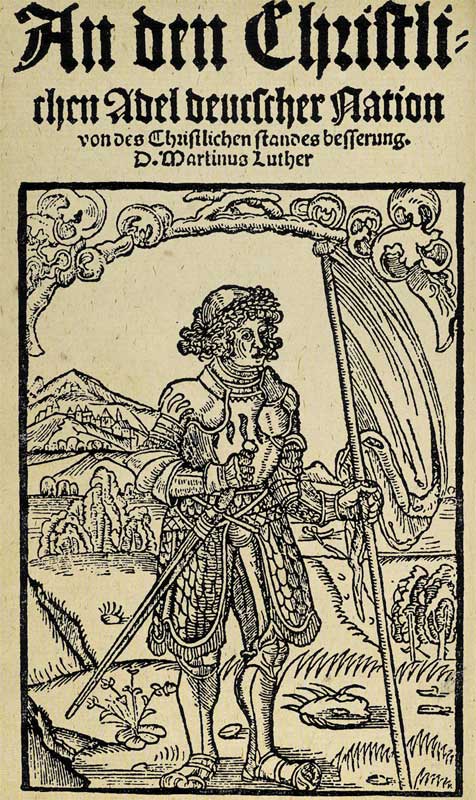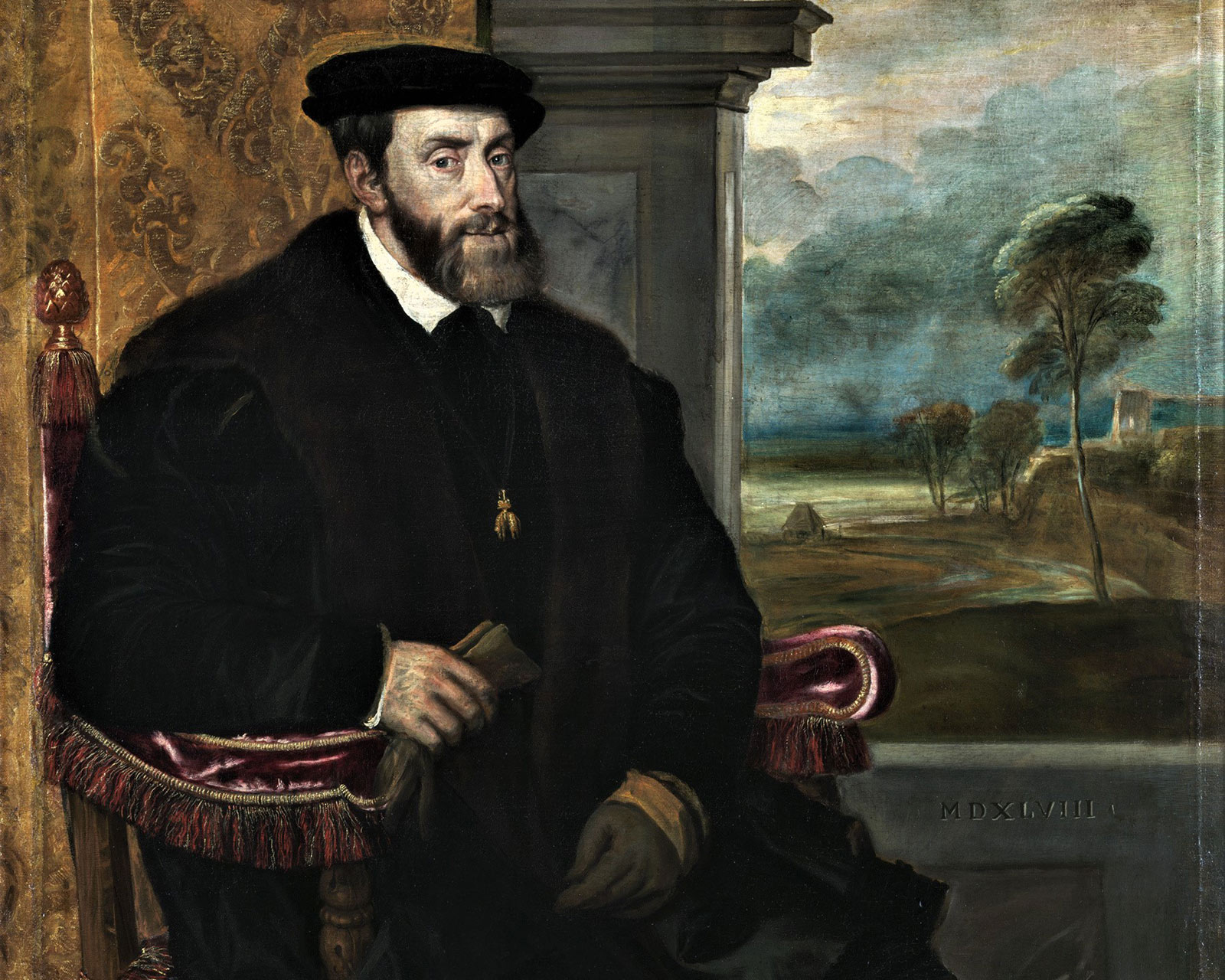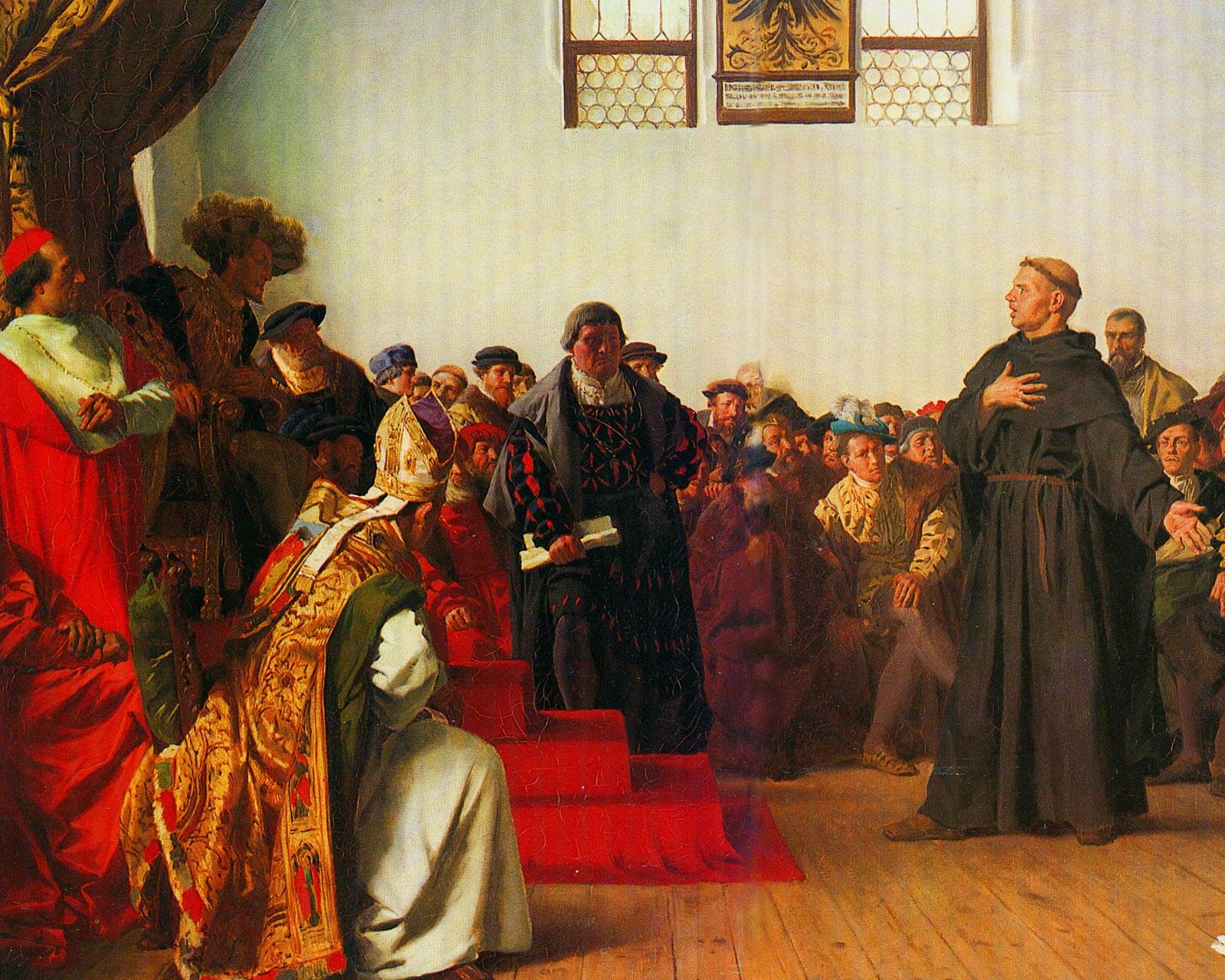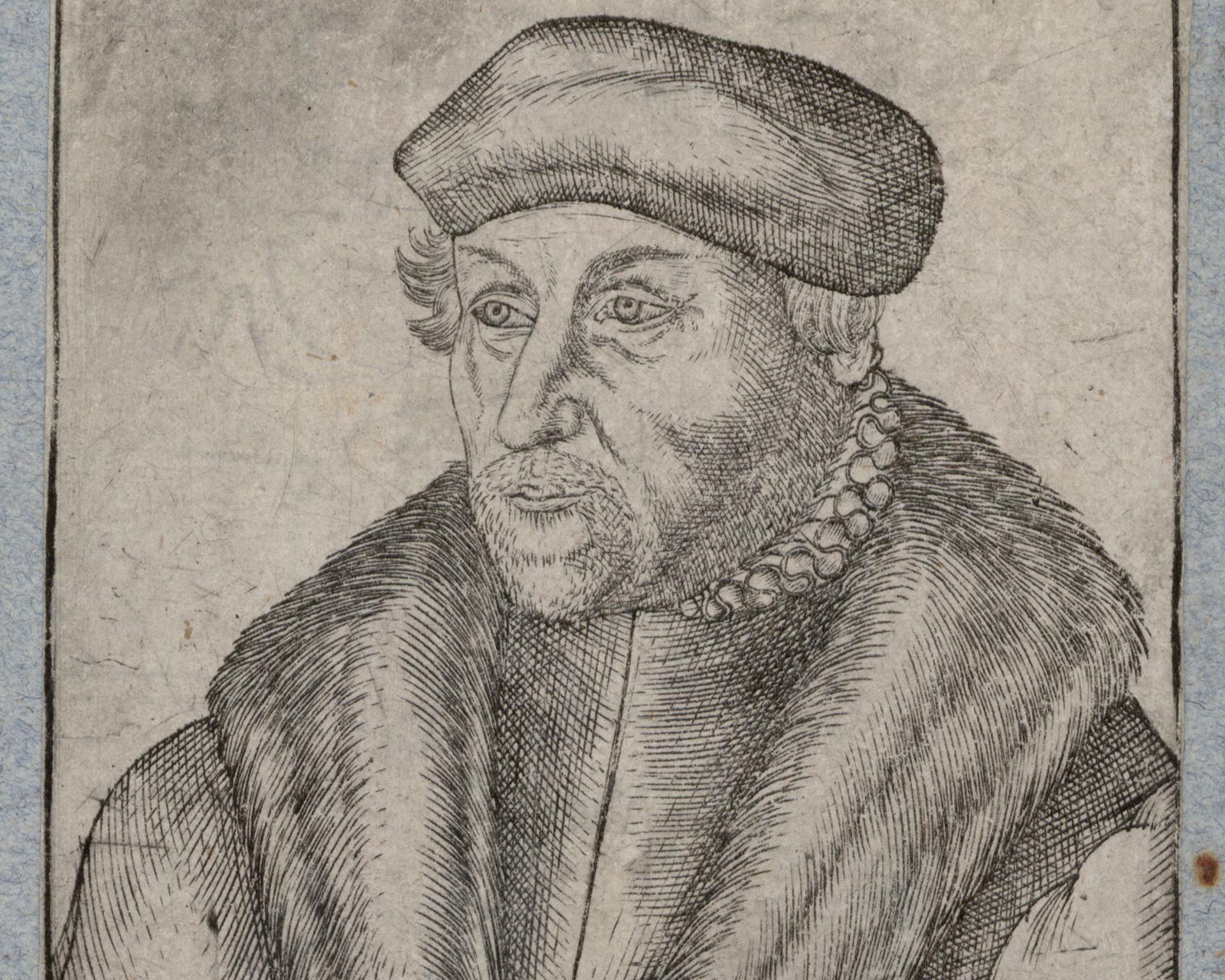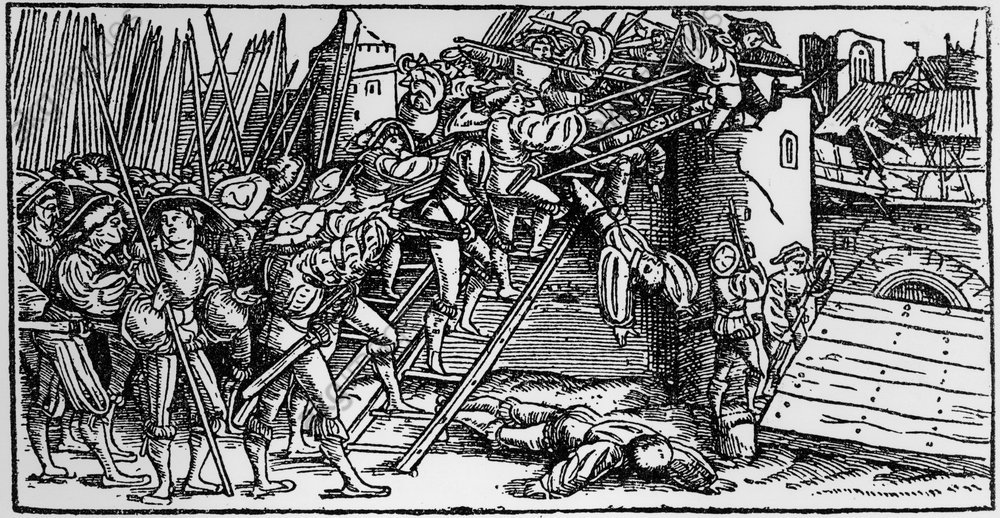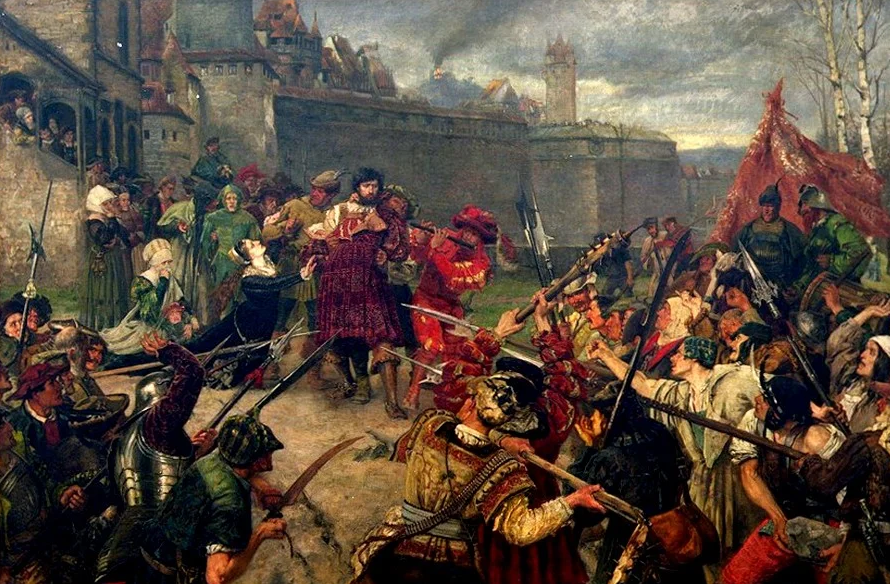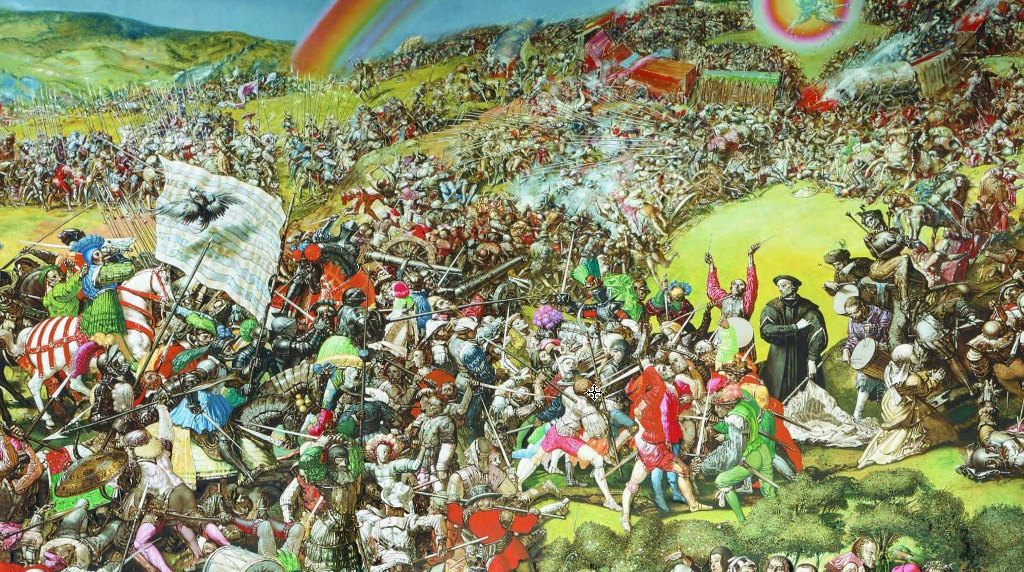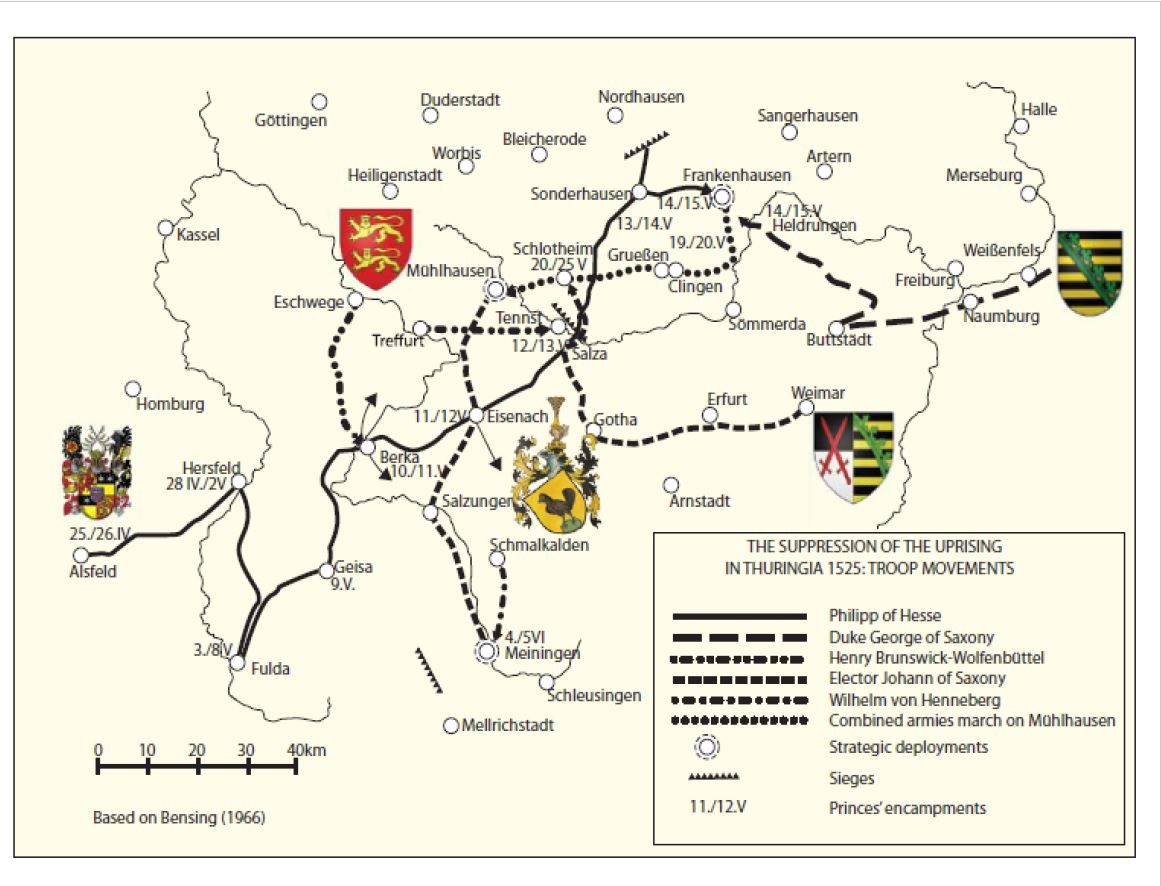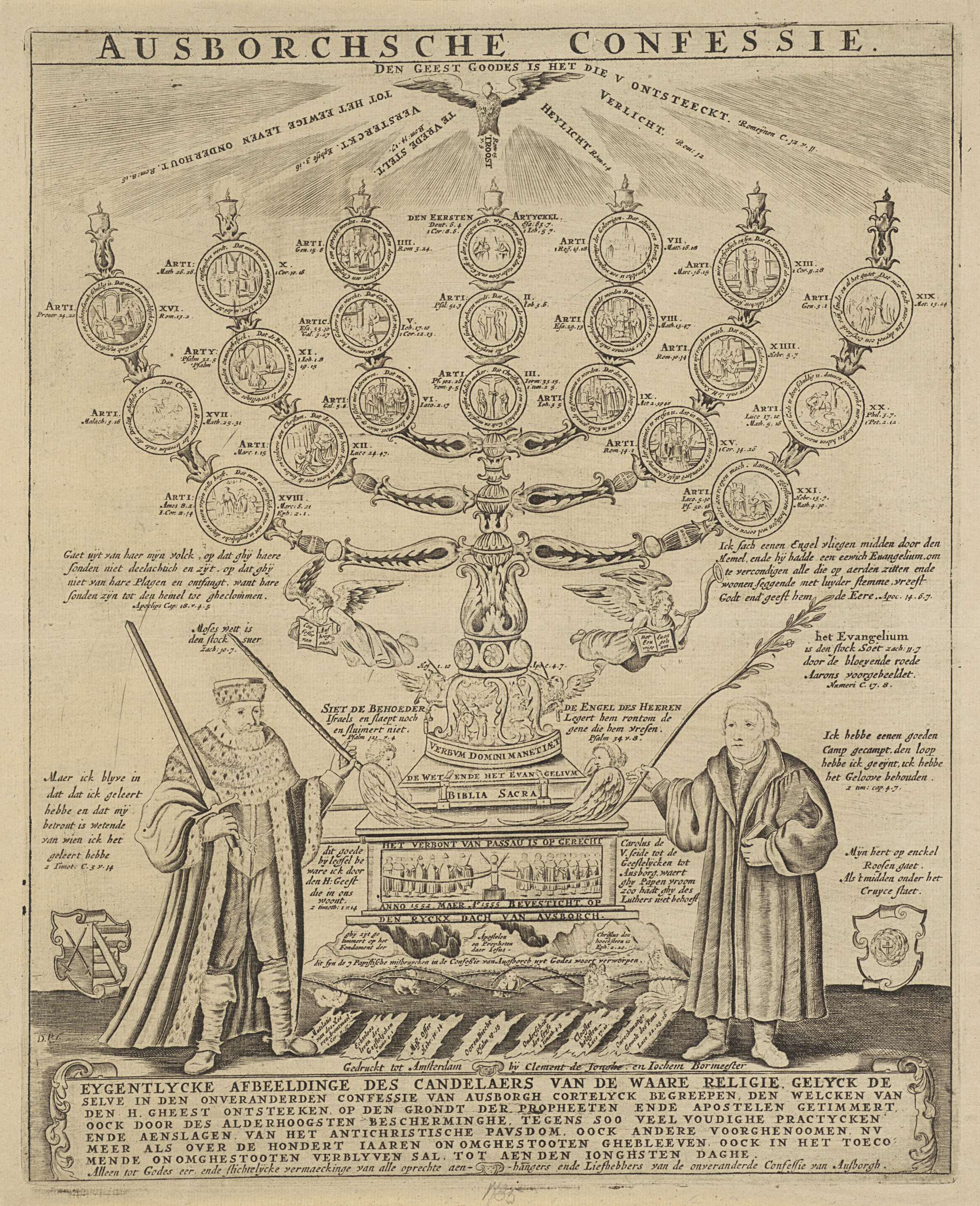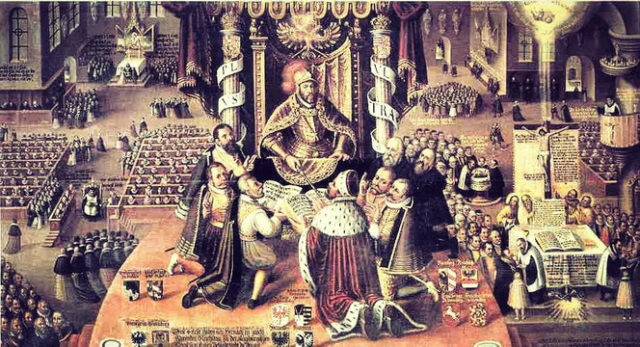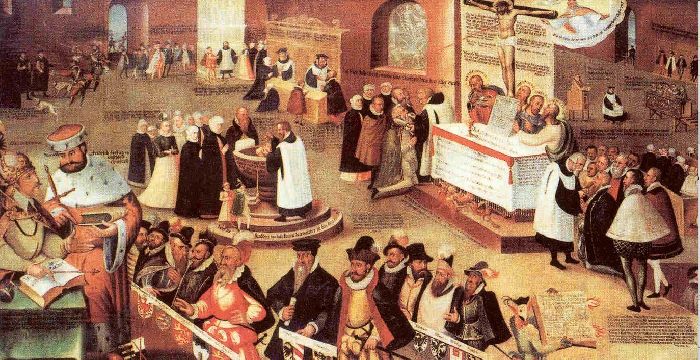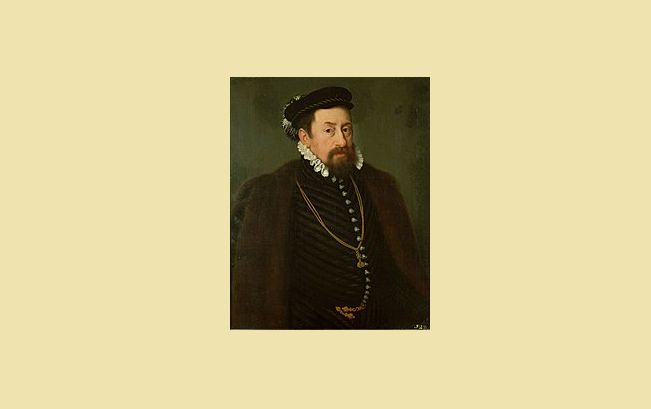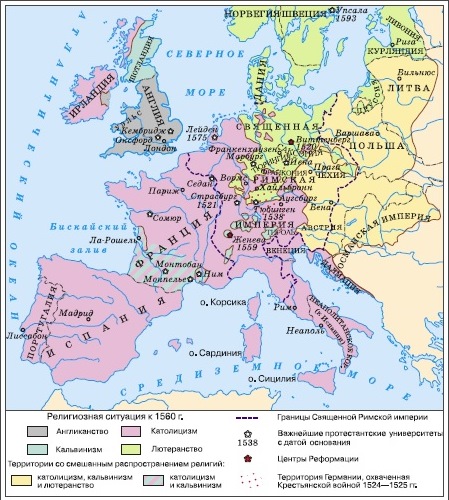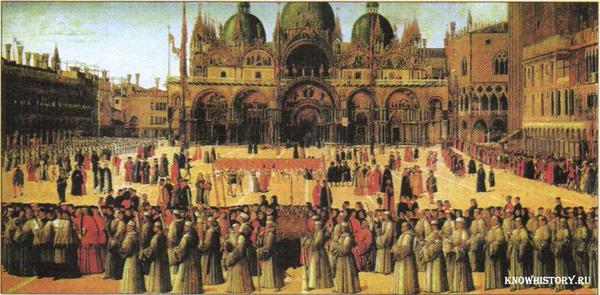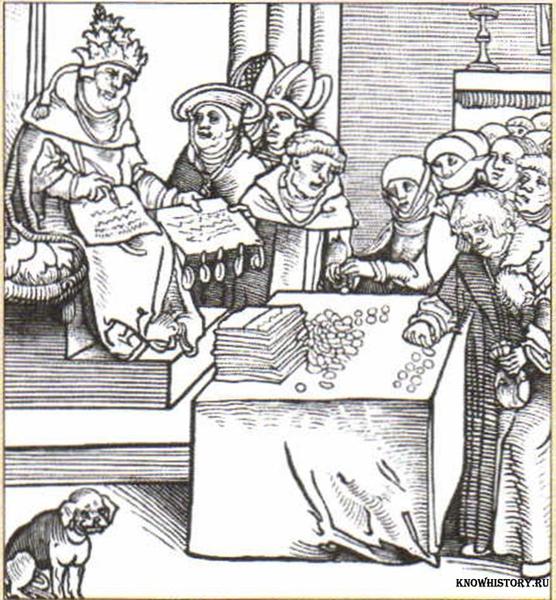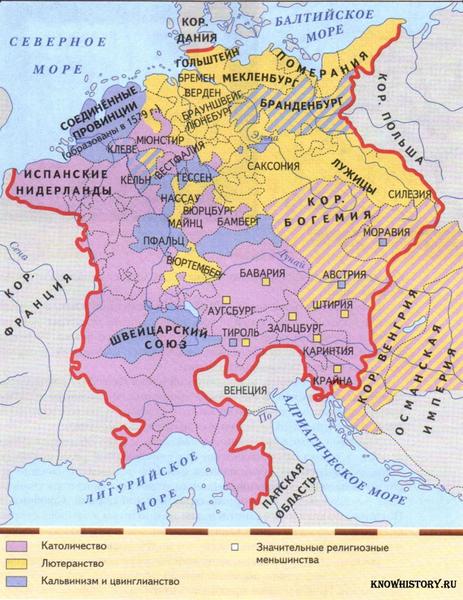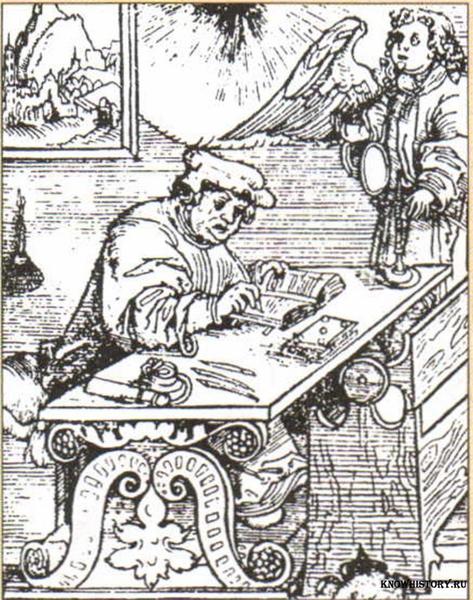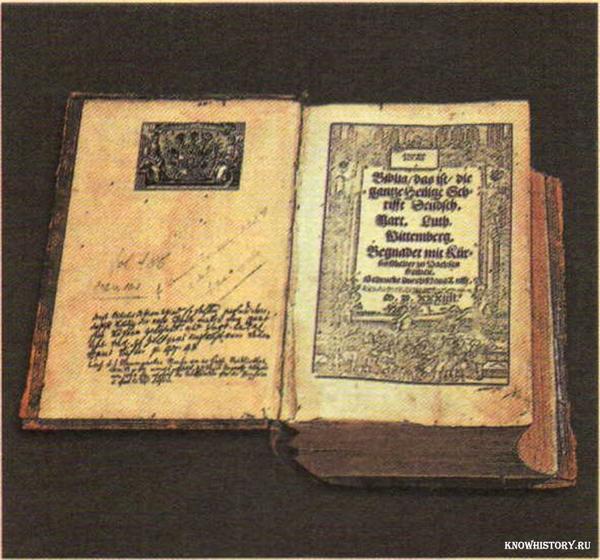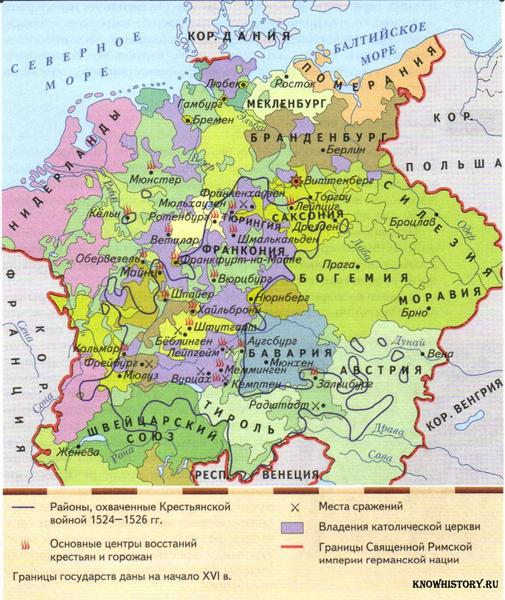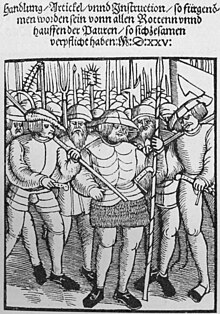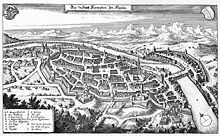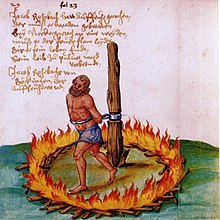Вормсский Рейхстаг: общеимперское дело
Октябрь 1517 года стал отправной точкой в истории Реформации в Германии — это был пролог непростого процесса борьбы ряда общественных групп внутри империи. По сути, 31 октября 1517 года — формальная дата, обросшая красивой легендой, которую, скорее всего, придумал соратник и ученик Лютера Филипп Меланхтон. Якобы к стенам Виттенбергского кафедрального собора доктор богословия прибил открытое письмо архиепископу Майнца Альбрехту Бранденбургскому — 95 тезисов. Сам Лютер никогда не вспоминал об этом событии как о публичной демонстрации своих идей. Период с 1517-го по 1521-й пройдёт в спорах с видными интеллектуалами от церкви, а также в процессе публикации самых известных трактатов. Получат своё распространение такие произведения, как «К христианскому дворянству немецкой нации», «О свободе христианина» и «О вавилонском пленении пап». Апостольский престол был обеспокоен распространением учения бывшего августинского монаха, но в немецких землях пока ещё не случилось бурной реакции.
«К христианскому дворянству немецкой нации». (pinterest)
Однако ситуация внутри империи менялась: в 1519 году Максимилиан I ушёл в лучший из миров, и княжеская ассамблея во Франкфурте выбрала государем Карла V. Ревностный католик, негативно относившийся к опусам Лютера, был обязан избранию на престол голосу протектора богослова, саксонского курфюрста Фридриха III Мудрого. После того как мятежный доктор из Виттенбергского университета сжёг папскую буллу об отлучении его от церкви, верховная власть империи намеревалась выдворить еретика за границу. Но по личной просьбе курфюрста Фридриха Мудрого император Карл V даёт возможность выступить богослову на Вормсском рейхстаге в первой половине 1521 года.
Центральным вопросом рейхстага стала турецкая проблема, далее — жалобы князей на церковную юстицию. Элита хотела разграничения сфер влияния церковной и светской юстиций, так как обе соприкасались слишком часто. Самый главный пункт — право суда над духовными лицами.
17 апреля Мартину Лютеру предоставили возможность выступить. Ему предстояло произнести свою речь в очень непростых условиях. Разбор его дела шёл 3 дня: говорил он путано, очень стеснялся княжеской ассамблеи, чувствовал себя некомфортно. Позднее доктор богословия не любил вспоминать Вормсский съезд, ибо, как сам считал, выглядел он там очень неубедительно. Император не воспринял речь реформатора, но часть князей всё же обратила внимание на его высказывания, ведь он защищал те же постулаты, что выдвигали и они.
В итоге в майские дни 1521 года были приняты два серьёзных решения. Первое — Лютер покидал в 20-дневный срок территорию Священной Римской империи. Второе — ему и его сторонникам запрещалась проповедь, а также решение по его делу откладывалось до следующего вселенского собора. Многие князья, даже архиепископ Майнца, не осмелились подписать это постановление. Официально Лютер — изгой. Он торопится в Саксонию, где попадает в руки местного дворянства: реформатора якобы похищают. Появляется некий рыцарь Георг в замке Вартбург, что в Тюрингии, который занимается переводом Библии на немецкий язык. Эта хитрая операция была подготовлена не без помощи курфюрста Фридриха Мудрого.
Замок Вартбург. (Wikimedia Commons)
Фактически с 1521 года о себе официально заявляет Реформация в Германии: общественные массы начинают включаться в спор Лютера с Римом. Теперь это общеимперское дело.
Крестьянская война в Германии
Отец немецкой Реформации на время отошёл от дел: у движения нет лидера. Оно постепенно распадается на два течения. Первое — откровенно радикальное, которое выступало за немедленные преобразования в церкви, зачастую выливавшиеся в погромы монастырей, соборов и иконоборческое движение.
У «анархистов» было два лидера — импульсивный Андреас Карлштадт и энергичный Томас Мюнцер. Их идеи являлись максимальным упрощением лютеровской риторики. Немедленные действия без чёткого плана были обречены на потерю контроля над движением.
Второе — умеренное, которым руководил ученик Лютера, интеллектуал, преподаватель древнегреческого языка Виттенбергского университета Филипп Меланхтон. Но с простым народом сторонники нейтрального направления не нашли общего языка.
В 1522 году Лютер выходит из тени и выдворяет радикалов из Виттенберга. В землях курфюршества Саксония появляются первые лютеранские общины. Тем не менее до конца не было ясно, как должны существовать сообщества нового вероисповедания. Было необходимо организованное управление и власть.
Но на юго-западе Германии под знамёнами новой веры начинаются волнения. В 1522—1523 гг. в Эльзасе и Швабии прогремело рыцарское восстание. Интересы мелкого дворянства не особенно волновали новоиспечённого императора, а вот братья по Евангелию могли помочь в борьбе за права военной элиты. Но, к несчастью, евангелических сторонников было мало, а имперский Швабский союз городов и дворян дал отпор рыцарям под предводительством Франца фон Зиккенгена и Гёца фон Берлихингена.
Рыцарское восстание 1522−1523 гг. (pinterest)
Через год после провала рыцарского мятежа поднимают головы крестьяне. Их интересуют вопросы общинных прав и церковная реформа. Так и началась Крестьянская война на юге Германии, которая гремела с 1524-го по 1525-й. Стихийный бунт простого люда сильно ударил по дворянским поместьям и церковным землям. Расправы были неминуемы. Во главе отрядов восставших землепашцев были и рыцари, и народные проповедники. Лютера сильно опечалило такое положение дел: он хоть и призывал к борьбе, но не через насилие.
Восставшие крестьяне. (pinterest)
В начале 1525 года Швабский союз подавляет большинство крестьянских бунтов на юго-западе немецких земель. Весной и летом идёт зачистка Тюрингии: в битве под Франкенхаузеном 14−15 мая закончится история Томаса Мюнцера.
Битва под Франкенхаузеном. (pinterest)
Он спрячется в городе и объявит себя пророком. Однако войска ландграфа Гессенского Филиппа Великодушного и Георга Трухзеса фон Вальдбурга найдут главаря мятежников и обезглавят его. Хаос Крестьянской войны оставил сильный отпечаток не только в душе Мартина Лютера, но и на состоянии империи. Число жертв было колоссальным.
Карта восстания в Тюрингии. (pinterest)
После подобных социальных катаклизмов княжеская власть внедряется в реформационное движение. Элита начинает реагировать на посылы Лютера и видеть в них свою выгоду: курфюршество Саксония, ландграфство Гессен, земли Немецкого ордена в Пруссии и Прибалтике принимают учение виттенбергского богослова. Городские общины и мелкие владения дворян на юге и западе Германии также перенимают лютеранство.
Двор Габсбургов откровенно не справлялся с такой диффузией Реформации в Германии. Пока Карл V был занят итальянскими делами, его брат эрцгерцог Фердинанд на рейхстаге в Шпейре 1526 года пошёл на компромисс: к постановлениям Вормсского рейхстага добавилась ещё одна строка: каждый чин империи в своих владениях справляет богослужение, как велит его совесть. Фактически развитию идей Лютера дали зелёный свет. Однако в 1529 году император Карл V потребовал от эрцгерцога добиться признания князьями статей Вормсского рейхстага. Но дворянство ответило протестом.
В 1530 году в Аугсбурге «протестанты» во главе с Меланхтоном представили свою формулу вероисповедания. Карл решительно не соглашался с протестантским крылом княжеской ассамблеи и дал год на пересмотр своего мнения. Государь открыто угрожал опалой и репрессиями.
Шмалькальденская война
Напуганная протестантская знать и города в феврале 1531 года создают своё объединение — Шмалькальденский союз. Во главе стояли две важные для немецкой истории фигуры — Филипп Гессенский и Иоганн-Фридрих Саксонский. У союза сформировалась своя казна и свои вооружённые силы. В управлении объединением протестантов главную роль играл ландграф Гессена Филипп Великодушный — энергичный и деятельный князь, который думал о всеевропейском союзе протестантов. Он искал контакты с французскими, швейцарскими и нидерландскими братьями по вере. Вскоре к союзу примыкают реформаторские Вюртемберг и Брауншвейг.
Филипп Великодушный — ландграф Гессенан. (Wikimedia Commons)
Спустя почти 15 лет император Карл V и его сторонники начали борьбу против окрепшего союза протестантов. В 1545 году в Италии открылся Тридентский собор, который был собран в ответ на реформационное движение. Карл наконец разобрался с турецкой опасностью и заключил перемирие с Францией. Империя решила нанести ответный удар: в феврале 1546 года, когда уже не стало Лютера, на рейхстаге в Регенсбурге вождей Шмалькальденского союза провозгласили мятежниками.
Начались открытые боевые действия. На первых порах протестанты одержали ряд побед, но не смогли со временем закрепить свой успех. Военные советники мятежников предупреждали князей о перекрытии альпийских перевалов, через которые император мог получить подкрепление из Италии. Но лидеры союза больше пеклись о своих наследственных землях. Сторонники Карла собрали сильную группировку в Баварии и к осени 1546 года перешли в наступление. Армия протестантов распалась весной 1547 года в Саксонии и в апреле того же года была наголову разбита под Мюльбергом.
Шмалькальденская война. (Wikimedia Commons)
Император молниеносно развернул кампанию по реставрации католических порядков в Германии. Лютеровское вероучение возбранялось, вожди протестантского союза были помещены в тюрьму в Ингольштадте. Триумф Карла не оказался долгоиграющим: северные города и княжества решительно выступили против консервативных мер имперской власти, а союзники Габсбургов были напуганы — они считали, что император откровенно превышает свои полномочия.
На волне столкновений с Францией в 1551—1552 гг. разыгралась вторая Шмалькальденская война. Первой скрипкой протестантов стал курфюрст Мориц Саксонский. Мятежники решили не повторять старых ошибок и захватили альпийские перевалы, заставив имперское войско бежать в глубь Тироля. Потерявший всякое желание беседовать с протестантами, Карл делегировал полномочия Фердинанду: эрцгерцог пошёл на диалог и подписал с мятежниками в марте 1552 года Пассаутский мир. Союз протестантов распускался при условии вывода всех иностранных формирований с территории империи и освобождения всех пленных вождей объединения. Также гарантировалась свобода лютеранскому вероисповедованию.
Аугсбургский религиозный мир: уязвимое согласие
В 1555 году имперские чины наконец собрались в Аугсбурге, чтобы выработать новую формулу взаимодействия власти и протестантских князей. Напряжённые переговоры всё-таки закончились подписанием 25 октября 1555 года Аугсбургского религиозного мира.
Документ способствовал полному восстановлению земского мира в империи, концу смут и реорганизации имперской юстиции. Также было окончательно узаконено лютеранское вероисповедание, но при этом кальвинисты, баптисты, адвентисты и прочие протестантские движения объявлялись вне закона. Все дела по преследованию лютеран и католиков прекращались.
Аугсбургский религиозный мир. (pinterest)
Казалось, в империи воцарился мир и порядок, но, к сожалению, существовали важные обстоятельства, которые делали Аугсбургское согласие очень уязвимым. Любое появление нового течения протестантизма в немецких землях ставило под угрозу баланс сил. Существовала также проблема трактовки формулировок документа. Несмотря на всю стойкость имперских порядков и соглашений, последствия Аугсбургского мира сыграют важную роль в дестабилизации религиозного климата в Священной Римской империи начала 17-го столетия.
Эта
война – одна из ранних форм буржуазной
революции.
Причины
крестьянской войны,
две главные: 1) кризис феодальной системы
в XVI в.; 2) раскол в реформационном
движении. Крестьянской войне предшествовало
появление различных сект, ересиархи
которых предсказывали грядущую великую
войну. Среди этих сект наиболее значимой
была секта анабаптистов.
Своими действиями и идеологически
анабаптисты в дальнейшем вольются в
крестьянскую войну. В 20-х гг. XVI в. во
главе анабаптистов стоял подмастерье
Николай
Шторх.
Анабаптисты отрицали церковную
организацию и считали, что каждый
верующий обладает даром Божественного
откровения. На кого снизошла Божественная
благодать, тот становится пророком,
вещает «живое Евангелие», поэтому,
проповедовали анабаптисты, не нужен
институт священства. Анабаптисты
возвещали скорое наступление тысячелетнего
царства Христова на земле и предрекали,
что будут низвергнуты все земные троны
и бедные будут возвышены, а богатые
унижены. Реальными действиями анабаптисты
сыграли заметную роль в крестьянской
войне, которая началась в германских
землях в 20-х гг. XVI в.
Основоположником
реформационного народного направления
явился Томас
Мюнцер
(1490-1525). В качестве реформатора он начинал
как единомышленник и соратник Лютера,
но Мюнцер встает во главе
крестьянско-плебейского крыла Реформации,
с его идеями немедленных революционных
действий. Центром соратников Мюнцера
и центром будущей войны становится
город Цвиккау,
к ним присоединяются анабаптисты.
Идеологическое
обоснование
крестьянской войны базировалось
Мюнцером на его понимании Реформации
прежде всего как социально-политического
переворота, должны произвести самые
обездоленные слои населения – крестьяне
и городская беднота. В результате победы
должны установить новый общественный
строй без классовых различий, эксплуатации,
частной собственности. Бог для Мюнцера
не творец, стоящий над миром, а сам мир
в его единстве, высшая идея интегрального,
объединяющего отдельные части. Служение
Богу это, прежде всего, активная
деятельность человечества на общее
благо. Народ, считал Мюнцер, является
ревнителем дела Бога. «Богатые безбожники
будут низвергнуты, униженные возвышены»,
– писал Мюнцер.
Крестьянской
войне под руководством Мюнцера
предшествовали многочисленные волнения
в Германии, где революционная обстановка
к 20-м годам чрезвычайно накалилась.
Первыми выступили рыцари во главе с
Францем
фон Зиккенгеном.
Идеологом рыцарского выступления, как
пролога Крестьянской войны, был
знаменитый немецкий гуманист Ульрих
фон Гуттен.
Крестьянская
война началась в 1524
г. и закончилась в 1525
г. Развернулась она в юго-западных
немецких землях, где было распространено
реформационное религиозное учение
Цвингли. Война под руководством Мюнцера
началась на верхнем Рейне, затем охватила
регионы между верхним Рейном и верхним
Дунаем. Первым требованием, которое
выдвинули восставшие крестьяне, была
отмена феодальных поборов. Но цели и
задачи войны под руководством Мюнцера
не сводилась только к этому положению.
Восстание приобретало организованный
характер. В конце 1524 – нач. 1525 г. появляется
первая общереволюционная программа
«Статейное
письмо»,
открыто провозглашающее необходимость
коренного социального и политического
переворота и создания общества социальной
справедливости. Однако эта программа
не стала общей программой войны. Ряд
руководителей восстания не были столь
революционно настроены и склонялись
к переговорам с властями и с феодалами,
т.е. готовы были занять компромиссные
позиции, далекие от революционных.
Великая
Крестьянская война под руководством
Томаса Мюнцера, началось в феврале 1525
г.
в Швабии,
откуда она перебросилась в другие
немецкие земли. Руководители отдельных
военных отрядов по-разному понимали
«божественное право»: одни понимали
его как установление полного социального
равенства, другие – как ликвидацию
крепостной зависимости. Весной 1525 г.
создается в Швабии крестьянская
организация «Христианское
объединение».
В Швабии действует и враждебное ему
объединение – бюргерский «Швабский
союз».
Поскольку «Швабский союз» был гораздо
сильнее «Христианского объединения»,
представители последнего решили пойти
на переговоры со «Швабским союзом»,
подготовив для этого идейную платформу
– знаменитые «Двенадцать
статей». Эта программа была разработана
цвинглианскими реформаторами.
«Двенадцать статей», обоснованные Св.
Писанием, подчеркивали мирный характер
намерений и требований крестьян. В этот
документ были включены реформационные
статьи: необходимость Реформы Церкви,
обязательная выборность и сменяемость
священников.
Экономические
требования:
отмены крепостного права, требования
«Двенадцати статей» касались самых
злободневных вопросов крестьянской
жизни и стали общей программой восставшего
немецкого крестьянства. А наиболее
революционно настроенная часть крестьян
не была удовлетворена этой программой
и отказалась от нее, начав действовать
и бороться за революционные преобразования
в Германии в духе «Статейного письма»,
более революционной по характеру
программы Крестьянской войны. «Швабский
союз» не смог уничтожить «Христианское
объединение» в Швабии. В германских
землях все более сгущалась грозовая
атмосфера, назревала необходимость
вооруженной борьбы, которую и начал
«Швабский союз» весной 1525 г. Основные
силы восставших крестьян в Швабии были
разбиты. Тогда «Швабский союз» перенес
свои действия в другие немецкие земли,
где бушевала Крестьянская война – во
Франконию. Отношение князей к Реформации
менялось. Сначала они все были на стороне
оппозиции Риму. В отсутствие Карла V во
главе Германии находилось имперское
правление состоявшее из курфюрстов и
из уполномоченных от отдельных округов
Германии. В 1522 оно пригласило саксонских
епископов принять меры против
виттенбергских беспорядков, но когда
Лютер успокоил смуту, курфюрсту
саксонскому удалось склонить имперское
правление к тому, чтобы Вормский эдикт
был оставлен без последствий. Само
управление благосклонно относилось к
Реформации, надеясь посредством нее
освободить Германию от папских поборов.
В 1523 новому папе (Адриану VI) имперское
правление и собравшийся в Нюрнберге
сейм прямо отказали привести в исполнение
церковное отлучение и государственную
опалу, тяготевшие над Лютером. Сейм
выставил целый ряд жалоб против курии.
К 1526 у Лютера окончательно сложились
виттенбергские церковные порядки, т.е.
главным образом богослужение на народном
языке, заменившее католическую мессу.
Согласившись на ограничение прежнего
произвола курии, папа Климент VII расширил
вместе с тем власть князей над местным
духовенством и даже отдал им часть
церковных имуществ и доходов, за что
князья обязывались преследовать
лютеранство в своих владениях. Такое
соглашение курии с южными немецкими
князьями было оформлено на Регенсбургском
съезде в июне 1524 г. после чего в Австрии,
Баварии и Зальцбурге начались гонения
на приверженцев Реформация. В 1529 г. был
созван сейм в Шпеере и императором было
предложено восстановить Вормский эдикт
ввиду возникновения разных ужасных
сект. Большинство прямо выразило
согласие подчиниться Вормскому эдикту;
меньшинство составило протест,
подписанную
пятью князьями (в том числе курфюрстом
саксонским и ландграфом гессенским) и
уполномоченными 14 имперских городов.
Они получили название «протестантов»,
распространившееся впоследствии на
всех оставивших католическую церковь.
Протест был актом неповиновения
императору: князья и имперские города
становились в положение подданных и
заявляли, что во всем остальном они
готовы повиноваться императору, но
только не в том, что касается славы
Божией и спасения души. В связи с
протестом 1529 ставился уже, таким образом,
вопрос о праве с оружием в руках
отстаивать свободу совести. В 1530 Карл
V после девятилетнего отсутствия приехал
в Германию, назначив собрание имперского
сейма в Аугсбурге. Во время Аугсбургского
сейма 1530 Карл V выразил желание
познакомиться с учением лютеран,
Меланхтон составил знаменитое
Аугсбургское
исповедание
в духе сближения протестантского учения
с католическим и во время дальнейших
переговоров с богословами Карла V охотно
шел на уступки, так что его поведение
даже вызвало протесты со стороны Лютера
и лютеранских князей. Документ был
подписан всеми лютеранскими князьями
и представителями двух имперских
городов. Протестантские чины (в том
числе лютеранские и цвинглианские
города) протестовали против такого
решения, и ответом их на угрозы императора
и католиков было заключение ими в самом
конце 1530 г. Шмалькальденского
союза.
В 1532 г. в Нюрнберге состоялось соглашение,
в силу которого князья и города, принявшие
уже аугсбургское исповедание, оставались
при нем, но отказывались от зашиты его
последователей в других землях.
Огражденная Нюрнбергским трактатом,
Реформация могла спокойно утверждаться
и даже распространяться на новые земли,
хотя по смыслу соглашения 1532 должен
был поддерживаться status quo. В 1534 введена
была Реформация в Вюртемберге, куда
возвратился изгнанный оттуда раньше
герцог Ульрих. В 1538 главные католические
князья с королем Фердинандом во главе
заключили между собой союз в Нюрнберге.
В 1539 г. Реформация сделала новые важные
приобретения. Когда умер саксонский
герцог Георг, его преемник Генрих,
поддерживаемый Шмалькальденским
союзом, ввел Реформацию и в альбертинской
Саксонии при содействии светских
сословий ландтага. Иоахим II, курфюрст
бранденбургский, уступая народному
желанию, также ввел у себя лютеранство,
хотя и с некоторыми особенностями. В
1542 Шмалькальденский
союз
напал на герцога брауншвейгского и
заставил его бежать из его владений, в
которых курфюрст саксонский и Филипп
Гессенский ввели протестантизм.
В
1545 при посредстве Франции был заключен
Карлом мир и с турками. Первым результатом
нового мира было подавление кельнской
Реформации. В 1545 по настоянию Карла V
папа Павел III созвал собор в Триденте,
но протестанты отказались в нем
участвовать. В 1546 г., в год смерти Лютера,
началась война между императором и
Шмалькальденским союзом, окончившаяся
поражением и пленом курфюрста саксонского
и ландграфа гессенского. Это была победа
иностранного государя, завоевание
Германии иноземным войском. Папа боялся
усиления императорской власти,
утверждения Карла V в Италии в его планов
на счет собора. Франция была также в
числе врагов Карла V: новый французский
король Генрих II продолжал политику
своего отца. Изменивший шмалькальденцам
герцог саксонский Мориц был недоволен
Карлом V за неисполнение обещаний и
чувствовал себя крайне неловко, так
как все называли его изменником. В
чувстве негодования на императора
нация была солидарна с князьями. В 1552
князья обнародовали манифест, объявляя,
что они берутся за оружие для освобождения
Германии от скотского рабства. Быстрое
движение Морица на Тироль, где находился
не ожидавший нападения император,
заставило его искать спасения в бегстве.
Пассауским соглашением было постановлено
(1552), что имперские чины, держащиеся
Аугсбургского исповедания, будут
пользоваться свободой до восстановления
религиозного единства Германии
вселенским или национальным собором,
совещанием богословов или сеймом.
В
1555
был заключен Аугсбургский
религиозный мир
прекративший религиозную борьбу в
Германии и санкционировавший все
главные приобретения князей за
реформационный период. Наиболее
существенные постановления этого мира
были следующие. Князья и вольные города,
державшиеся Аугсбургского исповедания,
ограждались от притеснения за веру, но
пвинглианцы и кальвинисты (сильно уже
распространившиеся в то время) исключались
из этого правила. Далее провозглашался
принцип в силу которого подданные
должны были следовать вере своего
правительства; в пользу протестантских
подданных в духовных княжествах сделана
была, впрочем, оговорка. Другой оговоркой
постановлялось, что если бы епископ
задумал перейти в протестантизм, то
ему нельзя было секуляризировать свой
лен. Обе эти оговорки не были, однако,
утверждены формально. Политические
итоги немецкой Реформация:
Реформация содействовала начавшемуся
гораздо раздроблению Германии, разделив
страну на два враждебных лагеря, лишь
одну часть нации освободив от Рима,
ослабив власть императора и усилив,
наоборот, власть князей. Сокрушив
рыцарей и крестьян и победив императора,
князья стали в более или менее независимое
положение по отношению к папе, подчинили
себе местное духовенство, секуляризировали
церковную собственность и сделались
господами в религиозных делах своих
княжеств.
Соседние файлы в предмете [НЕСОРТИРОВАННОЕ]
- #
- #
- #
- #
- #
- #
- #
- #
- #
- #
Реформация XVI века — это ключевой этап в истории Европы. Реформация — это движение за обновление католической церкви и пересмотр религиозных догм. Это движение привело к появлению новых конфессиональных течений и к потере католической церковью монополии.
Предпосылки к реформации
Важнейшими предпосылками реформации были, прежде всего:
- распространения философии гуманизма, провозгласивший человека хозяином своей судьбы и связанная с ней обмирщение сознания;
- также к предпосылкам следует отнести распространение новых религиозных учений — ереси, с точки зрения официальной церкви, в которых основной акцент делался на внутреннее стремление человека к богу, а не на религиозные обряды;
- также к предпосылкам реформации можно отнести распространение книгопечатания и подъем образования.
К причинам реформации следует отнести:
- во-первых, богатство церкви и вызывающее поведение священников. Нередко их критиковали за чревоугодие, корыстолюбие и невежество. Такое поведение вызывало недовольство всех социальных слоев;
- также стремление светских властей подчинить себе церковь на своих территориях и секуляризировать церковные земли;
- недовольство бюргерства и крестьянства церковной десятиной и другими церковными поборами тоже является одной из причин реформации;
- ну и, наконец, следует назвать продажу индульгенций.
Начало реформации
Реформация началась в Германии. В XV-XVI веках Германия представляла собой конгломерат земель: курфюршество, герцогство, маркграфство и так далее, которые управлялись фактически независимыми князьями. Власть императора над ними была весьма условна. Хотя имперская корона и оставалась у дома Габсбургов, но ее судьбу решали курфюрсты, поскольку они имели право выбирать императора. Также часть германских земель принадлежала церкви и управлялась независимыми духовными князьями.
Короли Англии и Франции, которые управляли централизованными монархическими государствами, укрепляли свою власть и боролись со стремлениями Папы Римского к верховенству над светскими властями. Германия же, составлявшая большую часть священной Римской империи, продолжала отправлять в Рим большие деньги, что вызывало недовольство, как горожан и крестьян, так и части князей.
Мартин Лютер
Лидером реформации стал Мартин Лютер, католический священник и преподаватель теологии в Виттенбергском университете. 31 октября 1517 года он прибил к дверям Виттенбергского собора свои знаменитые 95 тезисов против индульгенции. Мартин Лютер утверждал, что покупка индульгенции освобождает лишь от наказания, наложенного церковью, а искупление греха возможно только покаянием и добрыми делами. Священники, злоупотребляющие продажей индульгенцией и богатство церкви, по мнению Лютера, подрывает не только авторитет самой церкви, но и авторитет Папы Римского.
Следует отметить, что Мартин Лютер критиковал не столько Папу Римского, хотя и отмечал недопустимость его богатства, вызывающее недовольство паствы. Он критиковал скорее священников, злоупотребляющих своей властью.
Давайте прочтем несколько отрывков из этого произведения: «Поэтому ошибаются те проповедники индульгенций, которые объявляют, что посредством Папских индульгенций, человек избавляется от всякого наказания и спасается. Если кому-нибудь может быть дано полное прощение всех наказаний, то несомненно, что она дается наиправеднейшим, то есть немногим.
Должно учить христиан: Папа не считает покупку индульгенции, даже в малой степени сопоставимой с делами милосердия.
Должно учить христиан: тот, кто, видя нищего и пренебрегая им, покупает индульгенцию, не получит Папского прощения, но гнев Божий навлечет на себя.
Должно учить христиан: если они не обладают достатком, им вменяется в обязанность оставлять необходимое в своем доме и ни в коем случае не тратить достояние на индульгенции.
Должно учить христиан: покупка индульгенции — дело добровольное, а не принудительные.
Должно учить христиан: если бы папа узнал о злоупотреблениях проповедников отпущений, он счел бы за лучше сжечь дотла храм святого Петра, чем возводить его из кожи, мяса и костей своих овец».
Тезисы Мартина Лютера были признаны в то время ересью, и в 1520 году Папа издал буллу об отречении священника от церкви. Но он сжёг это папское послание на глазах у своих студентов. Вступив в полемику с Папой Римским, Мартин Лютер издал несколько сочинений, в которых изложил свои взгляды на религию и церковь. У него появилось много последователей среди немецкого бюргерства и дворянства, поскольку его учение отвечало их утилитарным интересам. Речь идет о желании бюргерства освободиться от церковных поборов и желание князей секуляризировать церковные земли и укрепить собственную власть.
Главная идея учения Мартина Лютера
Главная идея учения Мартина Лютера заключалась в том, что человек спасается только верой в Бога и не нуждается при этом в посредничестве церкви.
Спасение только верой — вот ключевой тезис его учения.
Католическая же церковь утверждала, что человек может получить прощение только при помощи церкви. Мартин Лютер считал, что церковь не должна быть богатой, и поэтому поддерживал идею секуляризации церковных земель. Из семи христианских таинств он предлагал оставить только два: крещение и причастие, поскольку только они упоминаются в Библии, а остальные пять он считал изобретением католической церкви.
Мартин Лютер выступал за перевод Библии с латыни, на которой не говорила паства на национальные языки. Это давало возможность верующим самостоятельно изучать Библию, при этом на священников возлагалась задача помощи в чтении Библии. На национальных языках должно было идти и богослужение. Пышность церковных обрядов, почитание икон, святых и мощей Мартин Лютер объявил идолопоклонством.
Преследования Мартина Лютера
В 1521 году император священной Римской империи Карл V вызвал Мартина Лютера на Вормсский рейхстаг. Туда же прибыли и посланники Папы Римского, которые требовали от Лютера отречения от его еретических взглядов. Но Лютера поддержала группа северо-германских князей, которая желала разрыва с Римом и укрепления собственной власти.
По легенде Мартин Лютер заявил: «Я на том стою и не могу иначе».
Над ним нависла реальная угроза ареста, но его спасли северо-германские князья, которые спрятали священника в одной из крепостей саксонского курфюрста Фридриха. Таковы были ключевые положения религиозного учения Мартина Лютера. Основанная на его учении церковь получила название лютеранская.
Последователи Мартина Лютера
Между тем последователи Мартина Лютера перешли к действию. В Саксонии и некоторых других немецких княжествах католическую мессу заменили проповедью. Из церквей выбрасывали иконы, таким образом, было уничтожено множество предметов средневекового искусства. В борьбу постепенно вовлекались крестьянства, бюргерства и разорившиеся рыцарства.
Появилось и желание политической реформации. Тяжелое социально-экономическое положение немецкого крестьянства обусловило столь быстрое распространение в его среде учений о справедливом политическом переустройстве. Зарождение капиталистических отношений в деревне привели к захвату дворянством христианских общинных земель, а также к увеличению налогов и к разорению и закрепощению части германского крестьянства.
Крестьянские восстания в Германии
Летом 1524 года на юге Германии вспыхнули крестьянские восстания. Идейно это движение возглавил священник Томас Мюнцер. Он призывал не только к реформации церкви, но и к установлению царства Божьего на земле. Восставшие составили программу, которая вошла в историографию под названием «12 статей». В этом документе крестьяне требовали права избирать священника и смещать его с должности. Также они считали, что десятина должна тратится только на содержание священника и его семьи и на помощь бедным членам общины. Также крестьяне требовали личной свободы и права пользоваться лесами, ловить дичь, рыбу и зверей. Леса и пашни должны были быть возвращены в общинное пользование.
Крестьяне требовали установления оброка и барщины по справедливости и отмены всех дополнительных поборов, в частности, отмены штрафов. Особой статьей они требовали отмены, так называемого, посмертного побора, который взимался с семьи умершего крестьянина и к которому, как правило, добавлялся и побор за право пользования наследством.
Постепенно восстание переместилась с юго-запада в центральные земли Германии. Наиболее организованным оно было в Тюрингии. Горожане и разорившееся рыцарства, примкнувшие к крестьянам, составили свою программу. Это, так называемая, Гейльброннская программа. Она ограничивала власть князей, и предусматривала централизацию страны.
Согласно этому документу в стране должны были быть созданы единые органы управления, подчиненные императору. Власть духовенства была ограничена и церковь лишалась собственности. Также документ предусматривал отмену внутренних таможен и введение единой денежной системы, и единой системы мер и весов. Программа практически не учитывала интересы крестьянства, в частности, указывалось, что крестьяне могут освободиться от феодальных повинностей путем выкупа феода в 20 кратном размере. Несмотря на то, что эта программа могла стать базой для объединения немецкого общества, крестьяне так и не смогли созвать съезд, чтобы обсудить ее. Хорошо вооруженные армии князей довольно быстро разбили разрозненные отряды крестьян. К концу 1525 года восстание было полностью подавлено.
Появление протестантизма
После окончания крестьянской войны часть германских князей продолжила секуляризацию церковных земель. Некоторые духовные князья отказывались от своего сана и объявляли себя государями своих прежних духовных княжеств. Так, например, поступил великий магистр Тевтонского ордена, который в 1525 году принял титул герцога Прусского. Другая часть князей, напуганная крестьянской войной и видевшая ее причины в реформации, осталась верной католицизму.
Император Карл V, отстаивая интересы католической церкви, в 1529 году созвал рейхстаг, на котором потребовал от князей прекратить секуляризацию церковных земель. Князья, сторонники учения Мартина Лютера, заявили протест. Так появилось слово протестантизм, обозначающее одно из направлений в христианстве. Основные положения лютеранства были изложены в документе под названием «Апология Аугсбургского вероисповедания».
Противостояние князей протестантов и князей католиков
Противостояние князей протестантов и князей католиков, которых поддерживал император, вылилось в две войны. Это так называемые Шмалькальденские войны. Но боевые действия не привели к перевесу ни одной из сторон и в 1555 году в Аугсбурге был заключен религиозный мир. Император признал право князей самостоятельно решать, какой будет религия в их государстве. Таким образом, восторжествовал принцип: чья земля, того и вера. Подданные же должны были исповедовать ту религию, к которой принадлежал их князь.
Северные и северо-восточные земли Германии, а также некоторые центральные княжества, приняли лютеранство. Юг остался католическим. Аугсбургский религиозный мир закрепил политическую раздробленность Германии. Постепенно в XVI веке лютеранство распространилось в Европе. Оно стало официальной религией в Дании, Норвегии, Финляндии и прибалтийских землях.
Аугсбургский религиозный мир
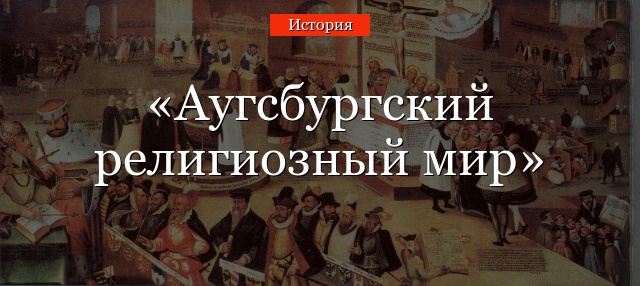
4.4
Средняя оценка: 4.4
Всего получено оценок: 156.
4.4
Средняя оценка: 4.4
Всего получено оценок: 156.
Заключение Аугсбургского религиозного мира в 1555 году стало одним из этапов Реформации в Европе XVI века. Согласно договору, лютеранство становилось официальной религией и у людей появилось право на его вероисповедание.
Предыстория
Реформация в Европе, а точнее на территории Священной Римской империи, началась в 1517 году с деятельности Мартина Лютера. В этом специфическом государстве, состоявшем из множества княжеств и отдельных городов, произошел религиозный раскол.
В 1524-1526 годах империя пережила крестьянскую войну. У протестантов в 1527 году появился первый собственный университет в Марбурге. Католических князей в противостоянии с протестантами поддержал император Карл V Габсбург. В результате, первым крупным военным конфликтом между католиками и протестантами стала Шмалькальденская война 1546-1547 годов. В ходе нее Мориц Саксонский, хоть и являлся сам протестантом, поддержал Карла V. Победителями в войне вышли католики, но из-за угрозы коллапса империи участники конфликта вынуждены были пойти на компромисс как в религиозной, так и в политической сфере.
Поискам компромисса способствовало ряд обстоятельств. Например, у императора Священной Римской империи ухудшились отношения с папой римским. Немецкие князья не хотели, чтобы престол императора достался наследнику по испанской линии Габсбургов – Филиппу II.
Переговоры и подписание
После очередного выступления князей-протестантов в 1552 году состоялись переговоры в городе Пассау. На них впервые образовалась нейтральная группа из князей, которых возглавил брат Карла V, эрцгерцог Австрии и король Чехии – Фердинанд I. Он изъявил готовность признать лютеранство и провести реформу Священной Римской империи.
В марте 1555 года было подписано соглашение между княжествами Саксония, Гессен и Бранденбург. Они согласовали свои позиции на переговорах с императором Карлом V, который от них отказался и переложил это на своего брата Фердинанда.
Датой подписания Аугсбургского мира стало 25 сентября 1555 года. Его условия были таковы:
- Лютеранство признавалось легитимным вероисповеданием.
- Признания не получили следующие направления протестантизма, например, цвинглианство и анабаптизм.
- Амнистия всем, кто был осужден из-за принадлежности к лютеранству.
- Принцип свободы вероисповедания для светских и духовных князей, рыцарей и вольных городов. Любой субъект империи мог перейти в лютеранство или вернуться в католичество.
- Протестанты сохранили земли, которые они успели секуляризировать до 1552 года.
- За католиками сохранялись их земельные владения в случае перехода епископа или аббата в лютеранство.
Религиозный мир восстановил единство Священной Римской империи и установил мир на ее территории. Была восстановлена деятельность ее институтов. Согласно условиям договора, подданные князей не имели права на выбор вероисповедания. Каждый князь сам решал лютеранство или католичество будет в его владениях. Этот принцип получил наименование “Чья страна, того и вера”.
19 сентября 1555 года Карл Габсбург отрекся от престола и выразил в тексте отречения несогласие с Аугсбургским договором, текст которого уже был готов. Следовательно, договор вступил в силу только с 1556 года, после передачи императорского престола Фердинанду I.
Что мы узнали?
Кратко об Аугсбургском мирном договоре можно узнать из школьного курса истории 6-7 класса, когда проходят Реформацию. Он стал важнейшим событием в религиозной и политической жизни Центральной Европы XVI века.
Тест по теме
Доска почёта

Чтобы попасть сюда — пройдите тест.
Пока никого нет. Будьте первым!
Оценка доклада
4.4
Средняя оценка: 4.4
Всего получено оценок: 156.
А какая ваша оценка?
§ 4. Реформация и крестьянская война в Германии
Причины Реформации
XV–XVI века были для Европы временем религиозных исканий. В результате изобретения книгопечатания Библия и комментарии к ней стали доступными не только для священнослужителей, но и для многих грамотных людей. Находилось всё больше смельчаков, склонных к самостоятельным размышлениям, к сомнениям во всём, что ещё недавно казалось незыблемым, в том числе и в вопросах веры. Этих энергичных и предприимчивых людей не устраивали средневековые идеалы смирения и аскетизма, они не хотели смотреть на земную жизнь лишь как на приготовление к жизни загробной. Оставаясь верующими, они испытывали потребность в вероучении, которое оправдывало бы такую позицию. А католические идеалы вызывали всё больше критики, нередко продолжавшей и развивавшей традиции средневековых ересей.
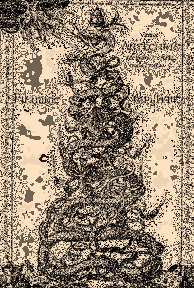
Карикатура на Католическую церковь. Изображающая Антихриста в папской тиаре. XVI в.
Католическую церковь было за что критиковать. Современники высмеивали и обличали корыстолюбие, невежество, чревоугодие священников и монахов. Всеобщее недовольство вызывали огромные богатства Церкви. Предметом зависти дворян были её обширные земельные владения. Экономным горожанам всё меньше нравились пышное церковное убранство и дорогостоящие церковные обряды. Правители хотели установить в своих государствах контроль над Церковью и воспользоваться её богатствами. Этому противились папы, претендовавшие на главенство над светской властью. Кроме того, в Рим поступали колоссальные доходы, получаемые со всех католиков Европы: плата за церковные должности, десятина, плата за исполнение обрядов… Папский двор купался в роскоши, папы и кардиналы пировали, охотились. Многие брали взятки, за деньги в Риме можно было приобрести любую должность и получить отпущение любых грехов. Несоответствие между образом жизни служителей Церкви и тем, что они проповедовали, вызывало возмущение верующих и части духовенства.
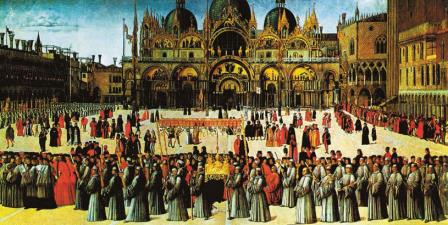
Религиозная процессия на площади Св. Марка в Венеции. Художник Д. Беллини
Католическая церковь учила, что даже самый добродетельный христианин греховен по самой своей природе, в силу первородного греха Адама. Он не способен собственными силами «спастись», т. е. искупить свои грехи. Только Церковь, являясь посредницей между верующим и Богом, может обеспечить человеку вечное спасение. Для этого нужно следовать всем её предписаниям, жертвовать деньги, признавать семь церковных таинств – обрядов, выполняемых священниками. Считалось, что в момент совершения таинства верующему передаётся Божественная благодать. Церковь учила, что страдания Христа, заслуги апостолов и святых создали как бы «запас» благодати. Распоряжаясь им, Папа Римский имеет право прощать верующим любые грехи. Выданные от его лица письменные отпущения грехов назывались индульгенциями. Огромные доходы от их продажи должны были использоваться на благочестивые цели. Торговля индульгенциями не нравилась наиболее совестливым верующим, а то обстоятельство, что эти деньги тратились на личные нужды священнослужителей, лишь подливало масло в огонь.
Какие семь таинств признаёт католицизм? (Вспомните из курса истории Средних веков или выясните из литературы.)
Недовольство Церковью нарастало по всей Европе. Началась Реформация – широкое движение за реформу (обновление) Католической церкви, охватившее в XVI в. многие европейские страны.
Реформация зародилась в Германии, и это не случайно. Ни в одной другой стране Европы к началу XVI в. не накопилось столько противоречий. В отличие от многих европейских стран (Англии, Франции, Испании), в Германии, составлявшей основную часть Священной Римской империи, в это время сохранялась политическая раздробленность. Раннее развитие капитализма во многих отраслях промышленности причудливо сочеталось здесь с отсталостью деревни, в которой сохранялись традиционные отношения между крестьянами и сеньорами.
Идеи объединения страны, ограничения произвола князей, усиления императорской власти и других перемен буквально витали в воздухе. Но многочисленным проектам реформ неизменно противостояли те силы, которые не были в них заинтересованы, и прежде всего семь курфюрстов – наиболее могущественных князей, имевших право выбирать императора. По сути, в стране все враждовали со всеми. Князья не давали усилиться императору и в то же время притесняли простых дворян; дворяне, бессильные перед волей князей, отыгрывались на крестьянах и горожанах, жестоко страдавших от их произвола. И только в одном – в недовольстве Католической церковью – сходились все слои немецкого общества. В раздробленной Германии у слабой императорской власти не было сил противиться притязаниям пап. В немецких землях Церковь сильно зависела от Рима и отправляла туда огромные суммы.
Всеобщее недовольство Римом и обострение всех других общественных противоречий сделало обстановку в Германии взрывоопасной. Воспламеняющее действие, подобно удару молнии в бочку пороха, оказали «95 тезисов» Ма?ртина Лю?тера, с которыми он выступил 31 октября 1517 г.
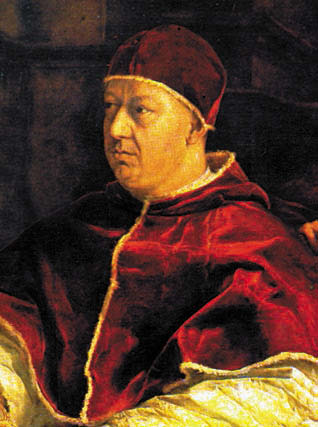
Папа Римский Лев Х – противник Реформации. Художник Рафаэль
Мартин Лютер против Папы Римского
Сын разбогатевшего рудокопа Мартин Лютер (1483–1546) учился в университете и подавал блестящие надежды, но затем бросил учёбу и ушёл в монастырь, стремясь найти там путь к спасению души. Позже он стал священником и доктором теоло?гии, проповедовал в церкви города Ви?ттенберга. После долгих размышлений Лютер пришёл к выводу, что милостью Божьей будет оправдан лишь искренне верующий, а те внешние проявления благочестия, которых Церковь требует от верующих, не имеют никакого значения для спасения души.

Мартин Лютер. Художник Л. Кранах Старший
Придя к своей главной идее об оправдании верой, Лютер не мог не обратить внимания на продажу индульгенций недалеко от Ви?ттенберга. Его уже давно возмущала идея спасения за деньги, и теперь он решился действовать. В считаные недели «95 тезисов» против индульгенций стали известны всей Германии. Не помышляя о разрыве с Римом, Лютер думал лишь убедить Папу отказаться от продажи индульгенций. Однако в Риме в этих тезисах усмотрели ересь. От Лютера требовали отречься от своего учения, грозя отлучением от Церкви. Но он упорно стоял на своём и даже дерзал дальше развивать свои взгляды.
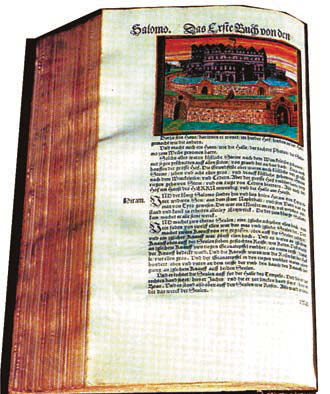
Страница из Библии в переводе Мартина Лютера
Идея Лютера об оправдании верой имела важные последствия, которые он и сам осознал не сразу. Ведь если человека спасает вера, то нужно ли посредничество Церкви во главе с Папой? Церковь должна лишь наставлять людей в религиозной жизни, помогать им понять Библию. Имущества у неё быть не должно, а то, что есть, следует секуляризи?ровать, т. е. передать светским властям. Священники, по Лютеру, ничем не отличаются от обычных людей, и в их безбрачии нет никакого смысла. И тем более не нужны монахи…
Признавая в делах веры авторитет только Священного Писания, Лютер, вопреки нормам католицизма, подчёркивал, что сочинения отцов Церкви, решения пап и соборов не имеют обязательной силы. Зато Библия должна быть доступна каждому христианину, а не только священнику, знающему латынь. Лютер перевёл Библию на немецкий язык, и его перевод считается замечательным памятником немецкой словесности XVI столетия.

Церковь в Виттенберге, где проповедовал Мартин Лютер
Свой идеал Церкви Лютер видел в раннем христианстве и предлагал отказаться от церковных таинств и ритуалов, не присущих ему изначально. Он выступил против пышного богослужения на латыни, причём особенно важным был отказ от торжественной мессы (ит. messa – основная католическая церковная служба); именно отношением к мессе католики и в дальнейшем отличались от сторонников Реформации. Лютер осуждал паломничество, почитание икон и мощей святых, а из семи церковных таинств предлагал оставить лишь те два, которые упоминаются в Библии, – крещение и причащение. Со временем он «добрался» и до центра Католической церкви – Святого Престола, подвергнув резкой критике его пороки и претензии.
Взгляды Лютера, и особенно его идея оправдания верой, легли в основу различных религиозных реформаторских направлений в Германии и за её пределами.
Чем отличается лютеровское понимание путей спасения души от католического?
В 1520 г. Папа Римский издал особый документ – бу?ллу с угрозой отлучить немецкого бунтаря от Церкви. В ответ Лютер публично сжёг один из экземпляров буллы. Множилось число сторойников реформ и среди бюргеров, и среди дворян, и даже среди князей. Их поддержал и саксонский курфюрст Фридрих Мудрый, во владениях которого жил Лютер.
Весной 1521 г. дело Лютера рассматривалось на Во?рмском рейхстаге в присутствии императора Карла V. Лютер вновь отказался отречься от своих взглядов. Император встал на сторону Папы и добился того, что рейхстаг (парламент) резко осудил новую ересь.
Между тем сторонники Лютера от слов переходили к делу. Возбуждённые проповедниками толпы уничтожали в церквах иконы – в результате погибли многие шедевры средневекового искусства. Лютер осудил такие действия: он считал, что Реформацию следует проводить только мирными средствами и что заниматься этим должны власти, а не простой народ.
Однако Лютер не мог контролировать события. Начатое им дело привлекло очень многих, но каждый понимал его учение по-своему. В Реформации появились разные направления, выражавшие интересы различных слоев общества. Сам Лютер оказался сторонником умеренного течения, стремясь опереться на князей и городские власти. Но были и приверженцы решительных действий, связывавшие реформу Церкви с переустройством общества в целом.
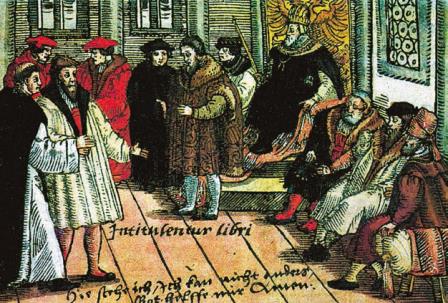
Мартин Лютер перед императором Карлом V на рейхстаге в Вормсе
Крестьянская война в Германии
Идеи Реформации быстро распространялись в народе. Многие считали, что земные порядки, противоречащие Божественным установлениям, следует изменить. Среди сторонников народной Реформации выделялся То?мас Мю?нцер (ок. 1490–1525). Сначала он поддержал Мартина Лютера, но затем стал его непримиримым врагом.
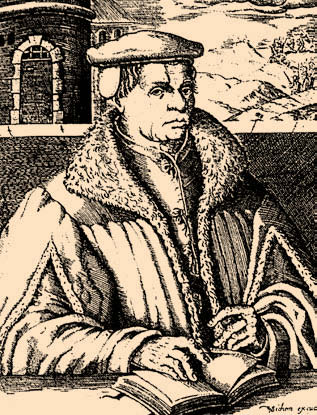
Томас Мюнцер
Мюнцер полагал, что частные интересы людей должны быть подчинены целому – Божественному замыслу. Понять его способны лишь те, кто действует в интересах всего общества. Это – трудовой народ, ремесленники и пахари. Взяв власть в свои руки, они установят на земле царство справедливости. А раз мирным путём им власть не отдают, значит, надо вести вооружённую борьбу против препятствующих воплощению Божественного замысла господ и властей.
Эта проповедь прозвучала на фоне резкого обострения отношений между сеньорами и крестьянами. Сеньоры в это время стремились повысить свои доходы за счёт простых земледельцев, возрождая старые повинности и вводя новые. В ответ крестьяне организовывали заговоры против господ. Все заговоры были раскрыты, но сыграли немаловажную роль в подготовке нового восстания, самого крупного в истории страны.
Крестьянская война началась на юго-западе Германии летом 1524 г. Крестьяне вооружались и собирались в отряды. Они отстаивали «старые обычаи», протестовали против ограничения их личной свободы и увеличения барщины. Восприняв некоторые идеи Реформации, крестьяне всё чаще соглашались признать только такие светские порядки, которые можно обосновать текстом Библии.
Восставшие составили несколько программ, в которых сформулировали свои требования. В одной из них – «Статейном письме» – всем дворянам и служителям Церкви предлагалось отказаться от своих привилегий и начать жить и трудиться как обычные люди. В противном случае они будут поставлены вне общества, а замки и монастыри – разрушены. На практике это выливалось в жестокие казни наиболее ненавистных сеньоров. Составители ещё одной программы – «Двенадцать статей» – требовали отмены личной зависимости крестьян, ограничения церковной десятины, барщины и штрафов. Они выступали за облегчение повинностей, но не за их уничтожение.
Между тем восстание с юго-запада страны распространилось на Франко?нию, Тюри?нгию и Тиро?ль. Во Франконии его поддержали многие горожане. Восставшие хотели обсудить дальнейшие действия и общую программу на съезде своих представителей в городе Хайльбро?нне. «Хайльброннская программа» предусматривала ограничение власти князей и централизацию страны. Все органы управления должны были подчиниться императору. Предусматривались секуляризация церковного имущества, закрытие монастырей, лишение духовенства светской власти, выборность пастырей самими общинами. Намечалось введение равенства всех перед законом, отмена таможен, чеканка единой для всей страны монеты, введение единой системы мер и весов. Предполагалось, что крестьяне смогут выкупить свои повинности путём единовременной уплаты ежегодного взноса в двадцатикратном размере, хотя для большинства крестьян собрать деньги на выкуп было нереально.
Как вы думаете, как развивались бы события, если бы «Хайльброннскую программу» удалось провести в жизнь?
Однако созвать съезд и обсудить эту программу крестьянам не удалось. Оправившись от первоначальной растерянности, власти разбили повстанцев и во Франконии, и в Тюрингии, где восставших возглавлял сам Мюнцер. В мае 1525 г. превосходящие силы князей взяли штурмом укреплённый лагерь восставших у Франкенха?узена. За подавлением восстания последовали жестокие расправы над его участниками, был казнён и Мюнцер. Считается, что в Крестьянской войне погибло около 100 тыс. человек. Положение крестьянства в целом ухудшилось, его сословное неравенство сохранилось.
Подавление крестьянского восстания стало поражением народной Реформации, а также сторонников реформ среди бюргерства и части рыцарства. Было закреплено всевластие князей, и объединение Германии надолго отодвинулось. И всё же Крестьянская война осталась в истории как символ борьбы народа за свободу.
Дальнейшие судьбы лютеранства
Мартин Лютер резко осудил повстанцев и Томаса Мюнцера, закрепив свой союз с князьями и городской верхушкой. Теперь, после поражения народной Реформации, многие князья больше не считали поддержку Лютера опасным делом. В то же время их чрезвычайно привлекали идеи секуляризации и главенства государя над Церковью. Они перешли на сторону Реформации и присвоили себе церковные владения. Даже великий магистр Тевтонского ордена распустил орден, секуляризировал его земли и принял титул герцога Прусского. Главой Церкви в каждом княжестве становился его государь.
Когда на рейхстаге 1529 г. католики оказались в большинстве и потребовали отменить завоевания Реформации, сторонники Лютера – лютеране – заявили протест. Они утверждали, что в делах веры мнение большинства не может быть навязано меньшинству. С этого времени их стали называть также протеста?нтами. Позже этот термин распространился на всех сторонников Реформации в Европе.
Достичь компромисса между протестантами и католиками так и не удалось, но и военные действия не дали перевеса ни одной из сторон. Заключённый в Аугсбурге в 1555 г. религиозный мир признал равноправие католицизма и лютеранства. Князья получили право определять религию своих подданных, руководствуясь принципом «чья власть, того и вера». В Германии образовались две группировки княжеств: на юге и западе страны преобладали католики, на севере и востоке – протестанты. Отношения между ними оставались напряжёнными.
К тому времени Реформация давно перешагнула границы Германии. Число сторонников Лютера множилось всюду. По инициативе королевской власти Реформация по лютеранскому образцу была проведена в Англии, в Дании с подвластными ей Норвегией и Исландией, в Швеции с подвластной Финляндией. В каждой из этих стран Церковь возглавил монарх. Таким образом, к середине XVI в. лютеранство возобладало в нескольких европейских странах.
Реформация в Европе в XVI в. и крестьянская война в Германии
Найдите на карте основные области Крестьянской войны: юго-запад (Швабию), Франконию, Тюрингию, Тироль. Найдите города Хайльбронн и Франкенхаузен. Найдите страны и области, где победило лютеранство.
Подведём итоги
В первой половине XVI в. в Европе началась Реформация – широкое движение за обновление Католической церкви, охватившее почти всю Европу. Расколов Церковь, Реформация дала начало новым направлениям в христианстве. Народная Реформация потерпела поражение в ходе Крестьянской войны в Германии, лютеранство же победило в ряде стран Европы.
Теология (от гр. theo?s – Бог и l?gos – слово) – то же, что богословие: систематизированное изложение вероучения, обосновывающее его истинность и необходимость для человека.
• 1517 – начало Реформации в Германии.
• 1524–1525 – Крестьянская война в Германии.
• 1555 – Аугсбургский религиозный мир.
«Я не могу и не хочу отрекаться, потому что действовать вразрез с совестью тяжело, неблагочестиво и опасно».
(Из речи Мартина Лютера на Вормском рейхстаге)
Вопросы
1*. Как вы думаете, почему Реформация началась именно в Германии?
2. Можно ли считать случайностью то, что Реформация началась с тезисов против индульгенций?
3. Почему в Реформации появились разные направления?
4. Какие положения программ Крестьянской войны говорят о влиянии Реформации на их составителей?
5. Почему сторонников Реформации стали называть протестантами?
6. Каковы были итоги Реформации к середине XVI в.?
Задания
1. Опираясь на материал учебника, докажите, что Реформация назревала во всей Европе, а не только в Германии.
2. Определите, как связаны с идеей Лютера об оправдании верой следующие положения его тезисов:
1) требование секуляризации церковного имущества;
2) осуждение монашества;
3) осуждение паломничества;
4) сокращение числа церковных таинств;
5) отрицание авторитета папских булл и церковных соборов.
3. Определите, какие из приведённых высказываний принадлежат М. Лютеру, а какие – Т. Мюнцеру. Найдите различия во взглядах двух реформаторов.
1) «Когда, какой заповедью Бог дал князьям такую власть, что мы, бедняки, должны проводить на барщине все хорошие дни и можем работать у себя на поле только в дождь, обливаясь кровавым потом? В своей справедливости Бог не потерпит, чтобы нас постоянно заставляли косить их луга, возделывать пашни…»
2) «Каждый христианин, если только он истинно раскаивается, получает полное отпущение вины и без индульгенции».
3) «Если мы на законном основании вешаем воров и обезглавливаем грабителей, то почему мы должны потакать римскому корыстолюбию – величайшему вору и разбойнику изо всех существовавших или могущих существовать на Земле, – которое прикрывается священными именами Христа и святого Петра?»
4) «Бороться против власти Папы, не признавать отпущения грехов, чистилища, панихид и других злоупотреблений – значит проводить реформу только наполовину».
5) «Беритесь за дело Божие и выходите на борьбу. Время настало!.. Господь хочет приняться за дело, злодеи должны погибнуть».
6) «Всякий, кто может, должен их [крестьян] бить, душить, колоть тайно или явно и помнить, что не может быть ничего ядовитее, вреднее, ничего более дьявольского, чем мятежник. Его надо убивать, как бешеную собаку: если ты его не убьёшь, то он убьёт тебя и вместе с тобою целую страну».
Данный текст является ознакомительным фрагментом.
Читайте также
§ 4. Реформация и крестьянская война в Германии
§ 4. Реформация и крестьянская война в Германии
Причины РеформацииXV–XVI века были для Европы временем религиозных исканий. В результате изобретения книгопечатания Библия и комментарии к ней стали доступными не только для священнослужителей, но и для многих грамотных
§ 55. Крестьянская война 1773 – 1775 гг
§ 55. Крестьянская война 1773 – 1775 гг
Положение крестьян. Известно стремление императрицы убедить всех, особенно иностранных корреспондентов, что страна при её правлении процветает, а народ живет в достатке и благоденствии. Показательны два письма Екатерины: одно
Вторая Крестьянская война
Вторая Крестьянская война
Формально она началась в 1930 году – ответ крестьян на проводимую Иосифом Сталиным политику коллективизации. О ее масштабах и количестве активных участников журналисты и историки спорят до сих пор. Одни утверждают, что она представляла большую
Крестьянская война
Крестьянская война
Война «красных и белых», регулярной Красной армии и регулярных белых армий была лишь частью гражданской войны. Второй ее частью была война крестьянская. История России знает большие крестьянские войны, в 17-м веке — восстание Степана Разина, и в 18-м —
Крестьянская война тайпинов
Крестьянская война тайпинов
Эта форма вначале оказалась традиционной для Китая, т.е. такой, в которой почти не была заметной антииностранная, антизападная линия недовольства. Даже напротив, чуждые традиционной структуре западные христианские идеи сыграли чуть ли не
§2. КРЕСТЬЯНСКАЯ ВОЙНА ПОД ПРЕДВОДИТЕЛЬСТВОМ И.И. БОЛОТНИКОВА
§2. КРЕСТЬЯНСКАЯ ВОЙНА ПОД ПРЕДВОДИТЕЛЬСТВОМ И.И. БОЛОТНИКОВА
Если о Василии Шуйском практически нет солидных работ, поскольку основные события шли как бы без него и часто против него, то о крестьянской войне и Иване Исаевиче Болотникове (ум. в 1608) написано много книг и
Крестьянская война в Германии
Крестьянская война в Германии
Протестное общественное движение, вызванное обострением социально-экономических и политических противоречий в Германии на протяжении XV – начала XVI в., достигло своей кульминации во время крестьянской войны 1524–1525 гг. Первые выступления
КРЕСТЬЯНСКАЯ ВОЙНА В ГЕРМАНИИ
КРЕСТЬЯНСКАЯ ВОЙНА В ГЕРМАНИИ
Нападение крестьян на рыцаряРеформация, начатая Лютером, нашла своих сторонников во всех слоях населения Германии. Интересно, что каждый находил в ней что-то свое и подстраивал религиозные идеи Лютера, зачастую искажая их, под свои чаяния.
Крестьянская война (1524—1525 гг.)
Крестьянская война (1524—1525 гг.)
Общественное движение и социальная борьба в Германии конца XV — начала XVI в. достигли своей кульминации в Крестьянской войне 1524—1525 гг. Одна из ее причин — ухудшение экономического,социального и правового статуса крестьян, особенное
Коллективизация и крестьянская война
Коллективизация и крестьянская война
Распространенное в массовом историческом сознании и в работах многих историков и публицистов жесткое противопоставление «программ» Сталина и «правых» — «программ» индустриального скачка и продолжения нэпа, — как правило,
24. К чему привела Реформация в Германии?
24. К чему привела Реформация в Германии?
Реформация была первым актом выступления нового, зародившегося в недрах феодального общества буржуазного сословия против феодальных порядков.Реформация началась в духовной сфере, с выступления буржуазии против католицизма –
31. Крестьянская война под руководством Пугачева
31. Крестьянская война под руководством Пугачева
Начало и ход крестьянской войны. Первыми восстали казаки на реке Яик (теперь река Урал). Царское правительство лишало уральских казаков их вольностей, облагало их обременительными налогами, стремясь превратить казаков в
6. РЕФОРМАЦИЯ В ГЕРМАНИИ
6. РЕФОРМАЦИЯ В ГЕРМАНИИ
Великие географические открытия изменили жизнь европейского общества, причем были опровергнуты некоторые церковные догмы. Открытия ученых также вносили свой вклад в опровержение церковных учений о мироздании. В XVI в. под влиянием открытий,
7. КРЕСТЬЯНСКАЯ ВОЙНА В ГЕРМАНИИ 7 (1524–1526 ГГ.)
7. КРЕСТЬЯНСКАЯ ВОЙНА В ГЕРМАНИИ 7 (1524–1526 ГГ.)
Уровень социально—экономического и политического развития Германии к началу XVI в. уступал только Нидерландам и Англии. Рост городов обусловливал интенсивную деятельность сельского хозяйства, которое стало приносить больше
§ 4. Реформация и крестьянская война в Германии
§ 4. Реформация и крестьянская война в Германии
Причины РеформацииXV–XVI вв. были для Европы временем духовного обновления. В результате изобретения книгопечатания Библия и комментарии к ней стали доступными не только для священнослужителей, но и для многих грамотных
Вслед за началом эпохи культурного возрождения, Великих географических открытий и острого международного соперничества в Европе начался грандиозный переворот в духовной сфере, принявший форму религиозной Реформации.
Содержание
- 1 Предпосылки Реформации
- 2 Германия накануне Реформации
- 3 Начало Реформации в Германии
- 4 Крестьянская война
- 5 Княжеская реформация и итоги Реформации в Германии
- 6 Итоги Реформации в Германии
Предпосылки Реформации
Понятие «Реформация» обозначает широкое движение за обновление католической церкви, развернувшееся по всей Европе, которое в итоге привело к образованию новых, так называемых «протестантских» церквей. Реформация происходила в самый разгар Итальянских войн, в которые были вовлечены практически все государства Европы, что сказалось на ходе и особенностях Реформации в разных странах.
Гуманизм эпохи Возрождения ставил в центр внимания человека с его земными, повседневными интересами, что проявилось даже в поведении первосвященников католической церкви. В конце XV — первой половине XVI в. римский престол один за другим занимали папы, отличавшиеся стремлением к роскоши, военной славе и другим далёким от служения Богу делам. Эти «ренессансные папы» славились беспринципностью и неразборчивостью в средствах, не останавливаясь перед убийством и другими преступлениями ради достижения своих целей. Понятно, что их поведение ослабляло авторитет церкви и усиливало стремление к её реформе.
Дж. Беллини. Процессия с реликвией Св. Креста на площади Св. Марка. Венеция. 1496 г.
Основной причиной Реформации стал внутренний кризис самой католической церкви. Протест против официальной церкви проистекал из глубины религиозного чувства. Необходимо учитывать, что религия имела первостепенное значение в духовной жизни средневекового человека, определяя всё его мировоззрение, а через него — повседневное поведение. Именно поэтому любые перемены в этой области имели большие последствия и оказывали влияние буквально на все стороны жизни.
На протяжении всего позднего Средневековья в европейском обществе, которое считалось единой «христианской республикой», распространялись религиозные течения, сторонники которых делали основной акцент не на соблюдении церковных обрядов и формальных проявлениях веры, а на внутреннем, индивидуальном общении человека с Богом. Реальная жизнь церкви, как им казалось, вступала в явное противоречие с христианским вероучением. Особое возмущение вызывало несоответствие образа жизни служителей церкви тому, что они проповедовали. Их поведение и политика, проводимая Римом, спровоцировали в итоге такую острую реакцию, которая привела к расколу католического мира. Реформационное движение, таким образом, носило не антирелигиозный, а антицерковный характер. Оно ставило целью укрепить истинную веру в противовес испорченной вере католического духовенства.
Неприятие вызывали, прежде всего, растущие материальные запросы римской церкви. Все верующие платили десятину — особый налог в размере 1/10 всех доходов. Велась открытая торговля церковными должностями, усилившаяся в начале XVI в. в связи с Итальянскими войнами. Умение верхушки католической церкви находить всё новые и новые источники богатств казалось неисчерпаемым. По всей Европе существовало огромное количество монастырей, имевших обширные земельные владения и иные богатства, с многочисленным населением, образ жизни которого давал повод для упрёков в праздности.
Важнейшую роль в успехе Реформации сыграло стремительное развитие книгопечатания, позволившее сделать Библию более доступной, что и создавало условия для широкого распространения новых религиозных идей.
Германия накануне Реформации
Родиной Реформации стала Германия, где все накопившиеся к началу XVI в. проблемы ощущались особенно остро. Большое значение имело и то, что на протяжении веков в Германии складывались своеобразные традиции религиозной мысли, которые отличали её от всей остальной Европы. Именно здесь возникло народное движение за «новое благочестие», участники которого пытались самостоятельно изучать Священное Писание. В это же время в Германии появились проповедники, призывавшие к простой жизни в евангельской нищете, они собирали вокруг себя многочисленных последователей.
Католическая церковь в Германии занимала исключительно привилегированное положение по сравнению с другими странами. Она владела почти третью всей германской земли и распоряжалась огромным количеством крестьян. Церковь в Германии больше, чем любая другая, зависела от Рима. Упадок императорской власти давал папам возможность практически бесконтрольно действовать на территории Священной Римской империи германской нации.
Сатирическая гравюра, разоблачающая папскую торговлю индульгенциями
Самой распространённой формой извлечения доходов была продажа индульгенций — специальных свидетельств об «отпущении» грехов. В XVI в. торговля индульгенциями стала совсем уж беззастенчивой. За деньги церковь готова была простить не только прошлые прегрешения, но и будущие, гарантируя верующим безнаказанность и фактически поощряя их жить во грехе.
Начало Реформации в Германии
Продажа индульгенций, начатая для финансирования строительства собора Св. Петра в Риме, приобрела особенно широкий размах при папе Льве X (1513-1521 гг.). Человеком, бросившим ему вызов, стал саксонский монах Мартин Лютер (1483—1546).
М. Лютер
Будущий реформатор родился в семье рудокопа, ставшего впоследствии владельцем небольшого медеплавильного предприятия. Он сумел получить университетское образование, несколько лет провёл в монастыре, а затем начал преподавать богословие в университете г. Виттенберга, расположенного во владениях герцога Саксонского. Хорошее знание церковной жизни и многолетние размышления над религиозными проблемами привели Лютера к мысли о необходимости очистить католическую церковь от пороков, вызывавших всеобщее возмущение. Средство к достижению этой цели он видел в возврате к идеалам раннего христианства, когда единственным авторитетом для христиан был текст Библии в его первозданной чистоте.
31 октября 1517 г. в соответствии с принятым в те времена обычаем Лютер прибил к дверям церкви в Виттенберге знаменитые «95 тезисов» — свои возражения против торговли индульгенциями. Это событие считается началом Реформации.
Переведённые с латыни на немецкий язык тезисы Лютера стремительно распространялись по всей Германии, заставляя миллионы его соотечественников задуматься над сложившимся в их стране положением. Попытка папы опровергнуть опасные мысли привела лишь к тому, что внимание народа ещё более сосредоточилось на Лютере.
В 1520 г. Лютер сделал следующий, ещё более решительный шаг, опубликовав обращение «К христианскому дворянству германской нации об исправлении христианства» и ряд других сочинений, в которых опровергал основные догматы католической церкви и осуждал господствовавшие в ней нравы. В доказательство серьёзности своих намерений Лютер демонстративно сжёг папскую буллу об отлучении его от церкви.
В 1521 г. Лютер был вызван на рейхстаг в Вормсе, где предстал перед судом императора Карла V. Согласно легенде, в ответ на предъявленные ему обвинения непреклонный реформатор решительно заявил: «На том стою и не могу иначе». Императору в тот момент было не до Германии. Назревала война с Францией, поэтому едва ли не в самую критическую минуту истории Германии он спешил оставить её для осуществления своих внешнеполитических замыслов. Карл V издал эдикт об осуждении Лютера, но тот вовремя скрылся во владениях герцога Саксонского Фридриха Мудрого, который первым из крупных германских князей встал на сторону Реформации.
Реформация в Германии
Лютер подготовил перевод Библии на немецкий язык, который сыграл колоссальную роль в истории германской культуры, дав импульс к формированию немецкого литературного языка. Перевод Лютера лёг в основу всей системы немецкого образования, которой он всегда придавал большое значение.
Мартин Лютер за переводом Библии в замке в Вартбурге. Гравюра. 1530 г.
Библия в переводе Мартина Лютера
Религиозное учение, основанное на идеях Лютера, получило название лютеранство. В настоящее время оно насчитывает десятки миллионов последователей во многих странах мира (их называют также евангельскими христианами, или евангелистами).
Основной смысл лютеранства сводится к идее об «оправдании верой», что означает отказ от внешних проявлений религиозности в пользу внутренних переживаний каждого человека. Спасение души провозглашалось индивидуальным делом верующего, не требующим вмешательства со стороны официальной церкви. Священное Писание объявлялось единственным авторитетом в вопросах веры, который не нуждался ни в каких толкованиях, а тем более — в формальных решениях церкви для своего подтверждения.
Лютеранство утверждало ненужность посредника между человеком и Богом — и, таким образом, ненужность церкви как особой организации. Новое учение предполагало отказ от монашества и церковного имущества. На место роскошных, богато декорированных католических храмов приходила «дешёвая церковь», лишённая ненужных украшений и пышных обрядов. От католичества сохранялось лишь то, что прямо не противоречило Писанию: крест, алтарь, орган. Важнейшее значение имело и то, что вместо латыни богослужение велось теперь на родном языке верующего. Религиозная жизнь сосредоточивалась теперь в церковных общинах, возглавляемых проповедниками — пасторами.
Крестьянская война
Реформация породила всеобщие надежды на преобразование германского общества. По всей стране распространялось убеждение, что мир находится накануне переворота, подготовленного всем ходом истории. Никогда ранее Германия не переживала такой поры надежд, энтузиазма, веры в быстрое обновление.
Ненависть к Риму на какое-то время заставила немцев забыть о различии интересов, но чем шире становился круг вовлечённых в движение социальных сил, тем явственнее давали знать о себе их противоречия и несхожие цели.
Первым на защиту своих интересов выступило германское рыцарство. Однако поднятое рыцарями восстание потерпело неудачу, что привело к его ослаблению как самостоятельной общественной силы и постепенному исчезновению с исторической арены.
Широкие народные массы по-своему истолковывали «христианскую свободу» и требовали решительным образом изменить условия своей жизни. Результатом стала «народная Реформация». К 1525 г. вся Германия была охвачена восстаниями, получившими название Крестьянской войны. Эти события заняли важное место в истории Германии в период перехода к Новому времени. Они стали следствием резкого ухудшения условий существования крестьянства, а Реформация подвела под требования крестьян идейную основу.
Вооружённые крестьяне. Гравюра XVI в.
Крестьянская война в Германии
В важнейшем доку менте Крестьянской войны — «12 статьях» — подчеркивалось: «сущность всех крестьянских статей (как ясно видно дальше) направлена к тому, чтобы понять это Евангелие и жить согласно с ним».
Эти выступления наглядно показали, что события стали развиваться не так, как предполагал инициатор Реформации. Лютер осудил восставших, опубликовав воззвание «Против разбойных крестьянских орд».
Борьба носила крайне ожесточённый характер, в ходе подавления крестьянских восстаний погибло около 100 тыс. человек.
Княжеская реформация и итоги Реформации в Германии
После окончания Крестьянской войны дело Реформации взяли в свои руки князья, занявшие отныне ведущее положение в происходящих событиях. Начинался период Реформации, который получил название «княжеская» Реформация. Включение владетельных князей в реформационное движение поднимало его на новый уровень.
В Германской империи существовали две категории князей: князья светские и князья церковные. Между ними существовали серьёзные противоречия. Реформация открывала перед светскими князьями возможности для расширения своих владений за счёт владений церковных князей.
Стремительному распространению Реформации по всей империи способствовала также борьба за власть между императором и князьями. Реформация позволяла светским князьям укрепить своё положение в Империи за счёт ослабления власти монарха.
Главным содержанием «княжеской» Реформации стал захват монастырских земель и секуляризация церковных владений, то есть обращение церковной собственности (преимущественно земли) в светскую. Карл V не сразу вмешался в конфликт между князьями и церковью. Всё это время его отвлекали войны в Италии. В 1529 г., после подписания мира в Каморе, Карл V получил, наконец, возможность заняться германскими делами. Первым делом император запретил захваты монастырского и церковного имущества и восстановил императорский эдикт 1521 г. о запрете лютеранства. Эти решения вызвали знаменитый протест пяти князей и 14 имперских городов — сторонников Реформации. Отсюда происходят понятия протестантизм и протестант, которые стали общими названиями для всего реформационного движения и его последователей.
Попытка Карла V восстановить церковное единство Германии не удалась. Обстоятельства, связанные с внешней политикой, вынудили императора надолго отложить борьбу против протестантов. Только заключённый в 1544 г. мир с Францией развязал Карлу V руки для борьбы с протестантами. Первая религиозная война в Германии (1546-1547 гг.) завершилась решительной победой императора. Однако в ходе второй войны 1552 г. протестанты выступили в союзе с королём Франции и быстро добились победы.
Между тем Германия находилась в состоянии почти полного хаоса. В 1555 г. в Аугсбурге был созван рейхстаг, которому суждено было подвести черту под религиозными войнами в Германии. Заключённый в Аугсбурге религиозный мир был основан на принципе: «Чья страна, того и вера» (то есть в каждом княжестве правитель имел право установить вероисповедание, которое выбрал сам). В Империи отныне признавались два христианских вероисповедания, одинаково равных перед законом, — католическое и лютеранское.
Видя крушение своих идеалов, Карл V отрёкся от всех титулов, чтобы закончить свою жизнь в одном из испанских монастырей.
Итоги Реформации в Германии
В результате Реформации произошло полное преобразование Германии. Отныне Империя была расколота на две неравные части. Протестантизм победил преимущественно на севере. Юг Империи, включая наследственные владения Габсбургов и Баварию, остался по большей части католическим.
Каждый князь сам устанавливал веру своих подданных, что ещё более усилило раздробленность Германии и уничтожило какие-либо возможности для предотвращения её в централизованное государство по образцу других стран Европы.
Из воззвания Мартина Лютера «К христианскому дворянству германской нации об исправлении христианства», 24 июня 1520 г.
«Время молчания прошло, и время говорить настало». И «может быть, Бог все-таки захочет помочь Своей Церкви посредством мирян, поскольку духовенство, которому это более подобает, ни на что не обращает внимания». Ведь «все христианство пришло в ужасный упадок», а «деятельность папы противоречит Писанию». Глава христианской церкви «ведёт такой светский и пышный образ жизни, достичь и сравняться с которым не в состоянии никакой король, никакой император». В Риме — «купля, продажа, размен, обмен, суета, ложь, обман, грабёж, воровство, роскошь, блуд, подлость и пренебрежение Богом во всех видах, так что гнуснее не мог бы править и антихрист». Там никого «не беспокоит, что законно, а что незаконно, там думают лишь о том, что приносит деньги, а что — нет».
Поэтому «немецкая нация, епископы и князья должны сами позаботиться о христианстве и народе, который им вверен, чтобы управлять им и защищать его материальные и духовные блага». Германское «христианское дворянство должно выступить против папы как против всеобщего врага и разрушителя христианства». Оно должно «помочь немецкой нации вновь стать христианской и свободной от жалкого, языческого и нехристианского правления папы».
«И гораздо больше хочет Он, чтобы эта империя управлялась христианским немецким государем».
Использованная литература:
В.В. Носков, Т.П. Андреевская / История с конца XV до конца XVIII века
| German Peasants’ War | ||||||
|---|---|---|---|---|---|---|
| Part of the European wars of religion and the Protestant Reformation |
||||||
 Map showing the locations of the peasant uprisings and major battles |
||||||
|
||||||
| Belligerents | ||||||
|
|
partly:
|
|||||
| Commanders and leaders | ||||||
|
|
|||||
| Strength | ||||||
| 300,000 | 6,000–8,500 | |||||
| Casualties and losses | ||||||
| >100,000 | Minimal |
The German Peasants’ War, Great Peasants’ War or Great Peasants’ Revolt (German: Deutscher Bauernkrieg) was a widespread popular revolt in some German-speaking areas in Central Europe from 1524 to 1525. It failed because of intense opposition from the aristocracy, who slaughtered up to 100,000 of the 300,000 poorly armed peasants and farmers.[1] The survivors were fined and achieved few, if any, of their goals. Like the preceding Bundschuh movement and the Hussite Wars, the war consisted of a series of both economic and religious revolts in which peasants and farmers, often supported by Anabaptist clergy, took the lead. The German Peasants’ War was Europe’s largest and most widespread popular uprising before the French Revolution of 1789. The fighting was at its height in the middle of 1525.
The war began with separate insurrections, beginning in the southwestern part of what is now Germany and Alsace, and spread in subsequent insurrections to the central and eastern areas of Germany and present-day Austria.[2] After the uprising in Germany was suppressed, it flared up briefly in several Swiss cantons.
In mounting their insurrection, peasants faced insurmountable obstacles. The democratic nature of their movement left them without a command structure and they lacked artillery and cavalry. Most of them had little, if any, military experience. Their opposition had experienced military leaders, well-equipped and disciplined armies, and ample funding.
The revolt incorporated some principles and rhetoric from the emerging Protestant Reformation, through which the peasants sought influence and freedom. Radical Reformers and Anabaptists, most famously Thomas Müntzer, instigated and supported the revolt. In contrast, Martin Luther and other Magisterial Reformers condemned it and clearly sided with the nobles. In Against the Murderous, Thieving Hordes of Peasants, Luther condemned the violence as the devil’s work and called for the nobles to put down the rebels like mad dogs.[3] The movement was also supported by Ulrich Zwingli, but the condemnation by Martin Luther contributed to its defeat.[4]
Background[edit]
In the sixteenth century, many parts of Europe had common political links within the Holy Roman Empire, a decentralized entity in which the Holy Roman Emperor himself had little authority outside of his own dynastic lands, which covered only a small fraction of the whole. At the time of the Peasants’ War, Charles V, King of Spain, held the position of Holy Roman Emperor (elected in 1520). Aristocratic dynasties ruled hundreds of largely independent territories (both secular and ecclesiastical) within the framework of the empire, and several dozen others operated as semi-independent city-states. The princes of these dynasties were taxed by the Roman Catholic church. The princes stood to gain economically if they broke away from the Roman church and established a German church under their own control, which would then not be able to tax them as the Roman church did. Most German princes broke with Rome using the nationalistic slogan of «German money for a German church».[5]
Roman civil law[edit]
Princes often attempted to force their freer peasants into serfdom by increasing taxes and introducing Roman civil law. Roman civil law advantaged princes who sought to consolidate their power because it brought all land into their personal ownership and eliminated the feudal concept of the land as a trust between lord and peasant that conferred rights as well as obligations on the latter. By maintaining the remnants of the ancient law which legitimized their own rule, they not only elevated their wealth and position in the empire through the confiscation of all property and revenues, but increased their power over their peasant subjects.
During the Knights’ Revolt the «knights», the lesser landholders of the Rhineland in western Germany, rose up in rebellion in 1522–1523. Their rhetoric was religious, and several leaders expressed Luther’s ideas on the split with Rome and the new German church. However, the Knights’ Revolt was not fundamentally religious. It was conservative in nature and sought to preserve the feudal order. The knights revolted against the new money order, which was squeezing them out of existence.[6]
Luther and Müntzer[edit]
Twelve Articles of the Peasants pamphlet of 1525
Martin Luther, the dominant leader of the Reformation in Germany, initially took a middle course in the Peasants’ War, by criticizing both the injustices imposed on the peasants, and the rashness of the peasants in fighting back. He also tended to support the centralization and urbanization of the economy. This position alienated the lesser nobles, but shored up his position with the burghers. Luther argued that work was the chief duty on earth; the duty of the peasants was farm labor and the duty of the ruling classes was upholding the peace. He could not support the Peasant War because it broke the peace, an evil he thought greater than the evils the peasants were rebelling against. At the peak of the insurrection in 1525, his position shifted completely to support of the rulers of the secular principalities and their Roman Catholic allies.[7]
In Against the Robbing Murderous Hordes of Peasants he encouraged the nobility to swiftly and violently eliminate the rebelling peasants, stating,»[the peasants] must be sliced, choked, stabbed, secretly and publicly, by those who can, like one must kill a rabid dog.»[8] After the conclusion of the Peasants War, he was criticized for his writings in support of the violent actions taken by the ruling class. He responded by writing an open letter to Caspar Muller, defending his position. However, he also stated that the nobles were too severe in suppression of the insurrection, despite having called for severe violence in his previous work.[9] Luther has often been sharply criticized for his position.[10]
Thomas Müntzer was the most prominent radical reforming preacher who supported the demands of the peasantry, including political and legal rights. Müntzer’s theology had been developed against a background of social upheaval and widespread religious doubt, and his call for a new world order fused with the political and social demands of the peasantry. In the final weeks of 1524 and the beginning of 1525, Müntzer travelled into south-west Germany, where the peasant armies were gathering; here he would have had contact with some of their leaders, and it is argued that he also influenced the formulation of their demands. He spent several weeks in the Klettgau area, and there is some evidence to suggest that he helped the peasants to formulate their grievances. While the famous Twelve Articles of the Swabian peasants were certainly not composed by Müntzer, at least one important supporting document, the Constitutional Draft, may well have originated with him.[11]
Returning to Saxony and Thuringia in early 1525, he assisted in the organisation of the various rebel groups there and ultimately led the rebel army in the ill-fated Battle of Frankenhausen on 15 May 1525.[12] Müntzer’s role in the Peasant War has been the subject of considerable controversy, some arguing that he had no influence at all, others that he was the sole inspirer of the uprising. To judge from his writings of 1523 and 1524, it was by no means inevitable that Müntzer would take the road of social revolution. However, it was precisely on this same theological foundation that Müntzer’s ideas briefly coincided with the aspirations of the peasants and plebeians of 1525: viewing the uprising as an apocalyptic act of God, he stepped up as ‘God’s Servant against the Godless’ and took his position as leader of the rebels.[13]
Luther and Müntzer took every opportunity to attack each other’s ideas and actions. Luther himself declared against the moderate demands of the peasantry embodied in the twelve articles. His article Against the Murderous, Thieving Hordes of Peasants appeared in May 1525 just as the rebels were being defeated on the fields of battle.
[edit]
Flyer from the time of the Peasants’ War
In this era of rapid change, modernizing princes tended to align with clergy burghers against the lesser nobility and peasants.
Princes[edit]
Many rulers of Germany’s various principalities functioned as autocratic rulers who recognized no other authority within their territories. Princes had the right to levy taxes and borrow money as they saw fit. The growing costs of administration and military upkeep impelled them to keep raising demands on their subjects.[14] The princes also worked to centralize power in the towns and estates.[15] Accordingly, princes tended to gain economically from the ruination of the lesser nobility, by acquiring their estates. This ignited the Knights’ Revolt that occurred from 1522 through 1523 in the Rhineland. The revolt was «suppressed by both Catholic and Lutheran princes who were satisfied to cooperate against a common danger».[14]
To the degree that other classes, such as the bourgeoisie,[16] might gain from the centralization of the economy and the elimination of the lesser nobles’ territorial controls on manufacture and trade,[17] the princes might unite with the burghers on the issue.[14]
Lesser nobility[edit]
The innovations in military technology of the Late Medieval period began to render the lesser nobility (the knights) militarily obsolete.[17] The introduction of military science and the growing importance of gunpowder and infantry lessened the importance of heavy cavalry and of castles. Their luxurious lifestyle drained what little income they had as prices kept rising. They exercised their ancient rights in order to wring income from their territories.[16]
In the north of Germany many of the lesser nobles had already been subordinated to secular and ecclesiastical lords.[17] Thus, their dominance over serfs was more restricted. However, in the south of Germany their powers were more intact. Accordingly, the harshness of the lesser nobles’ treatment of the peasantry provided the immediate cause of the uprising. The fact that this treatment was worse in the south than in the north was the reason that the war began in the south.[14]
The knights became embittered as their status and income fell and they came increasingly under the jurisdiction of the princes, putting the two groups in constant conflict. The knights also regarded the clergy as arrogant and superfluous, while envying their privileges and wealth. In addition, the knights’ relationships with the patricians in the towns was strained by the debts owed by the knights.[18] At odds with other classes in Germany, the lesser nobility was the least disposed to the changes.[16]
They and the clergy paid no taxes and often supported their local prince.[14]
Clergy[edit]
The clergy in 1525 were the intellectuals of their time. Not only were they literate, but in the Middle Ages they had produced most books. Some clergy were supported by the nobility and the rich, while others appealed to the masses. However, the clergy was beginning to lose its overwhelming intellectual authority. The progress of printing (especially of the Bible) and the expansion of commerce, as well as the spread of renaissance humanism, raised literacy rates, according to Engels.[19] Engels held that the Catholic monopoly on higher education was accordingly reduced. However, despite the secular nature of nineteenth century humanism, three centuries earlier Renaissance humanism had still been strongly connected with the Church: its proponents had attended Church schools.
Over time, some Catholic institutions had slipped into corruption. Clerical ignorance and the abuses of simony and pluralism (holding several offices at once) were rampant. Some bishops, archbishops, abbots and priors were as ruthless in exploiting their subjects as the regional princes.[20] In addition to the sale of indulgences, they set up prayer houses and directly taxed the people. Increased indignation over church corruption had led the monk Martin Luther to post his 95 Theses on the doors of the Castle Church in Wittenberg, Germany, in 1517, as well as impelling other reformers to radically re-think church doctrine and organization.[21] The clergy who did not follow Luther tended to be the aristocratic clergy, who opposed all change, including any break with the Roman Church.[22]
The poorer clergy, rural and urban itinerant preachers who were not well positioned in the church, were more likely to join the Reformation.[23] Some of the poorer clergy sought to extend Luther’s equalizing ideas to society at large.
Patricians[edit]
Many towns had privileges that exempted them from taxes, so that the bulk of taxation fell on the peasants. As the guilds grew and urban populations rose, the town patricians faced increasing opposition. The patricians consisted of wealthy families who sat alone in the town councils and held all the administrative offices. Like the princes, they sought to secure revenues from their peasants by any possible means. Arbitrary road, bridge, and gate tolls were instituted at will. They gradually usurped the common lands and made it illegal for peasants to fish or to log wood from these lands. Guild taxes were exacted. No revenues collected were subject to formal administration, and civic accounts were neglected. Thus embezzlement and fraud became common, and the patrician class, bound by family ties, became wealthier and more powerful.
Burghers[edit]
The town patricians were increasingly criticized by the growing burgher class, which consisted of well-to-do middle-class citizens who held administrative guild positions or worked as merchants. They demanded town assemblies made up of both patricians and burghers, or at least a restriction on simony and the allocation of council seats to burghers. The burghers also opposed the clergy, whom they felt had overstepped and failed to uphold their principles. They demanded an end to the clergy’s special privileges such as their exemption from taxation, as well as a reduction in their numbers. The burgher-master (guild master, or artisan) now owned both his workshop and its tools, which he allowed his apprentices to use, and provided the materials that his workers needed.[24] F. Engels cites: «To the call of Luther of rebellion against the Church, two political uprisings responded, first, the one of lower nobility, headed by Franz von Sickingen in 1523, and then, the great peasant’s war, in 1525; both were crushed, because, mainly, of the indecisiveness of the party having most interest in the fight, the urban bourgeoisie». (Foreword to the English edition of: ‘From Utopy Socialism to Scientific Socialism’, 1892)
Plebeians[edit]
The plebeians comprised the new class of urban workers, journeymen, and peddlers. Ruined burghers also joined their ranks. Although technically potential burghers, most journeymen were barred from higher positions by the wealthy families who ran the guilds.[17] Thus their «temporary» position devoid of civic rights tended to become permanent. The plebeians did not have property like ruined burghers or peasants.
Peasants[edit]
The heavily taxed peasantry continued to occupy the lowest stratum of society. In the early 16th century, no peasant could hunt, fish, or chop wood freely, as they previously had, because the lords had recently taken control of common lands. The lord had the right to use his peasants’ land as he wished; the peasant could do nothing but watch as his crops were destroyed by wild game and by nobles galloping across his fields in the course of chivalric hunts. When a peasant wished to marry, he not only needed the lord’s permission but had to pay a tax. When the peasant died, the lord was entitled to his best cattle, his best garments and his best tools. The justice system, operated by the clergy or wealthy burgher and patrician jurists, gave the peasant no redress. Generations of traditional servitude and the autonomous nature of the provinces limited peasant insurrections to local areas.[citation needed]
Military organizations[edit]
Army of the Swabian League[edit]
Bauernjörg, Georg, Truchsess von Waldburg, the Scourge of the Peasants
The Swabian League fielded an army commanded by Georg, Truchsess von Waldburg, later known as «Bauernjörg» for his role in the suppression of the revolt.[25] He was also known as the «Scourge of the Peasants».[a] The league headquarters was in Ulm, and command was exercised through a war council which decided the troop contingents to be levied from each member. Depending on their capability, members contributed a specific number of mounted knights and foot soldiers, called a contingent, to the league’s army. The Bishop of Augsburg, for example, had to contribute 10 horse (mounted) and 62 foot soldiers, which would be the equivalent of a half-company. At the beginning of the revolt the league members had trouble recruiting soldiers from among their own populations (particularly among peasant class) due to fear of them joining the rebels. As the rebellion expanded many nobles had trouble sending troops to the league armies because they had to combat rebel groups in their own lands. Another common problem regarding raising armies was that while nobles were obligated to provide troops to a member of the league, they also had other obligations to other lords. These conditions created problems and confusion for the nobles as they tried to gather together forces large enough to put down the revolts.[26]
Foot soldiers were drawn from the ranks of the landsknechte. These were mercenaries, usually paid a monthly wage of four guilders, and organized into regiments (haufen) and companies (fähnlein or little flag) of 120–300 men, which distinguished it from others. Each company, in turn, was composed of smaller units of 10 to 12 men, known as rotte. The landsknechte clothed, armed and fed themselves, and were accompanied by a sizable train of sutlers, bakers, washerwomen, prostitutes and sundry individuals with occupations needed to sustain the force. Trains (tross) were sometimes larger than the fighting force, but they required organization and discipline. Each landsknecht maintained its own structure, called the gemein, or community assembly, which was symbolized by a ring. The gemein had its own leader (schultheiss), and a provost officer who policed the ranks and maintained order.[25] The use of the landsknechte in the German Peasants’ War reflects a period of change between traditional noble roles or responsibilities towards warfare and practice of buying mercenary armies, which became the norm throughout the 16th century.[27]
The league relied on the armored cavalry of the nobility for the bulk of its strength; the league had both heavy cavalry and light cavalry, (rennfahne), which served as a vanguard. Typically, the rehnnfahne were the second and third sons of poor knights, the lower and sometimes impoverished nobility with small land-holdings, or, in the case of second and third sons, no inheritance or social role. These men could often be found roaming the countryside looking for work or engaging in highway robbery.[28]
To be effective the cavalry needed to be mobile, and to avoid hostile forces armed with pikes.
Peasant armies[edit]
Wandering bands of insurgents during the German Peasants’ War
The peasant armies were organized in bands (haufen), similar to the landsknecht. Each haufen was organized into unterhaufen, or fähnlein and rotten. The bands varied in size, depending on the number of insurgents available in the locality. Peasant haufen divided along territorial lines, whereas those of the landsknecht drew men from a variety of territories. Some bands could number about 4,000; others, such as the peasant force at Frankenhausen, could gather 8,000. The Alsatian peasants who took to the field at the Battle of Zabern (now Saverne) numbered 18,000.[29]
Haufen were formed from companies, typically 500 men per company, subdivided into platoons of 10 to 15 peasants each. Like the landsknechts, the peasant bands used similar titles: Oberster feldhauptmann, or supreme commander, similar to a colonel, and lieutenants, or leutinger. Each company was commanded by a captain and had its own fähnrich, or ensign, who carried the company’s standard (its ensign). The companies also had a sergeant or feldweibel, and squadron leaders called rottmeister, or masters of the rotte. Officers were usually elected, particularly the supreme commander and the leutinger.[29]
The peasant army was governed by a so-called ring, in which peasants gathered in a circle to debate tactics, troop movements, alliances, and the distribution of spoils. The ring was the decision-making body. In addition to this democratic construct, each band had a hierarchy of leaders including a supreme commander and a marshal (schultheiss), who maintained law and order. Other roles included lieutenants, captains, standard-bearers, master gunner, wagon-fort master, train master, four watch-masters, four sergeant-majors to arrange the order of battle, a weibel (sergeant) for each company, two quartermasters, farriers, quartermasters for the horses, a communications officer and a pillage master.[30]
Peasant resources[edit]
Coat of arms of the Swabian League, with a flag of St. George. Two putti support a red cross in a white field; the motto: What God has joined let man not separate; coloured woodcut by Hans Burgkmair, 1522.
The peasants possessed an important resource, the skills to build and maintain field works. They used the wagon fort effectively, a tactic that had been mastered in the Hussite Wars of the previous century.[31] Wagons were chained together in a suitable defensive location, with cavalry and draft animals placed in the center. Peasants dug ditches around the outer edge of the fort and used timber to close gaps between and underneath the wagons. In the Hussite Wars, artillery was usually placed in the center on raised mounds of earth that allowed them to fire over the wagons. Wagon forts could be erected and dismantled quickly. They were quite mobile, but they also had drawbacks: they required a fairly large area of flat terrain and they were not ideal for offense. Since their earlier use, artillery had increased in range and power.[32]
Peasants served in rotation, sometimes for one week in four, and returned to their villages after service. While the men served, others absorbed their workload. This sometimes meant producing supplies for their opponents, such as in the Archbishopric of Salzburg, where men worked to extract silver, which was used to hire fresh contingents of landsknechts for the Swabian League.[30]
However, the peasants lacked the Swabian League’s cavalry, having few horses and little armour. They seem to have used their mounted men for reconnaissance. The lack of cavalry with which to protect their flanks, and with which to penetrate massed landsknecht squares, proved to be a long-term tactical and strategic problem.[33]
Causes[edit]
Historians disagree on the nature of the revolt and its causes, whether it grew out of the emerging religious controversy centered on Luther; whether a wealthy tier of peasants saw their own wealth and rights slipping away, and sought to weave them into the legal, social and religious fabric of society; or whether peasants objected to the emergence of a modernizing, centralizing nation state.
Threat to prosperity[edit]
One view is that the origins of the German Peasants’ War lay partly in the unusual power dynamic caused by the agricultural and economic dynamism of the previous decades. Labor shortages in the last half of the 14th century had allowed peasants to sell their labor for a higher price; food and goods shortages had allowed them to sell their products for a higher price as well. Consequently, some peasants, particularly those who had limited allodial requirements, were able to accrue significant economic, social, and legal advantages.[34] Peasants were more concerned to protect the social, economic and legal gains they had made than about seeking further gains.[35]
Serfdom[edit]
Their attempt to break new ground was primarily seeking to increase their liberty by changing their status from serfs,[36] such as the infamous moment when the peasants of Mühlhausen refused to collect snail shells around which their lady could wind her thread. The renewal of the signeurial system had weakened in the previous half century, and peasants were unwilling to see it restored.[37]
Luther’s Reformation[edit]
Rebellious peasants surrounding a knight.
People in all layers of the social hierarchy—serfs or city dwellers, guildsmen or farmers, knights and aristocrats—started to question the established hierarchy. The so-called Book of One Hundred Chapters, for example, written between 1501 and 1513, promoted religious and economic freedom, attacking the governing establishment and displaying pride in the virtuous peasant.[38] The Bundschuh revolts of the first 20 years of the century offered another avenue for the expression of anti-authoritarian ideas, and for the spread of these ideas from one geographic region to another.
Luther’s revolution may have added intensity to these movements, but did not create them; the two events, Luther’s Protestant Reformation and the German Peasants’ War, were separate, sharing the same years but occurring independently.[39] However, Luther’s doctrine of the «priesthood of all believers» could be interpreted as proposing greater social equality than Luther intended. Luther vehemently opposed the revolts, writing the pamphlet Against the Murderous, Thieving Hordes of Peasants, in which he remarks «Let everyone who can, smite, slay, and stab, secretly or openly … nothing can be more poisonous, hurtful, or devilish than a rebel. It is just as one must kill a mad dog; if you do not strike him he will strike you.»
Historian Roland Bainton saw the revolt as a struggle that began as an upheaval immersed in the rhetoric of Luther’s Protestant Reformation against the Catholic Church but which really was impelled far beyond the narrow religious confines by the underlying economic tensions of the time.[40][41]
Class struggle[edit]
Friedrich Engels interpreted the war as a case in which an emerging proletariat (the urban class) failed to assert a sense of its own autonomy in the face of princely power and left the rural classes to their fate.[42]
Outbreak in the southwest[edit]
During the 1524 harvest, in Stühlingen, south of the Black Forest, the Countess of Lupfen ordered serfs to collect snail shells for use as thread spools after a series of difficult harvests. Within days, 1,200 peasants had gathered, created a list of grievances, elected officers, and raised a banner.[43] Within a few weeks most of southwestern Germany was in open revolt.[43] The uprising stretched from the Black Forest, along the Rhine river, to Lake Constance, into the Swabian highlands, along the upper Danube river, and into Bavaria[44] and the Tyrol.[45]
Insurgency expands[edit]
On 16 February 1525, 25 villages belonging to the city of Memmingen rebelled, demanding of the magistrates (city council) improvements in their economic condition and the general political situation. They complained of peonage, land use, easements on the woods and the commons, as well as ecclesiastical requirements of service and payment.
The city set up a committee of villagers to discuss their issues, expecting to see a checklist of specific and trivial demands. Unexpectedly, the peasants delivered a uniform declaration that struck at the pillars of the peasant-magisterial relationship. Twelve articles clearly and consistently outlined their grievances. The council rejected many of the demands. Historians have generally concluded that the articles of Memmingen became the basis for the Twelve Articles agreed on by the Upper Swabian Peasants Confederation of 20 March 1525.
A single Swabian contingent, close to 200 horse and 1,000-foot soldiers, however, could not deal with the size of the disturbance. By 1525, the uprisings in the Black Forest, the Breisgau, Hegau, Sundgau, and Alsace alone required a substantial muster of 3,000-foot and 300 horse soldiers.[25]
Twelve Articles (statement of principles)[edit]
The title page of the 12 Articles. On browned paper, an illustration shows men seated in a circle talking.
On 6 March 1525, some 50 representatives of the Upper Swabian Peasants Haufen (troops)—the Baltringer Haufen, the Allgäuer Haufen, and the Lake Constance Haufen (Seehaufen)—met in Memmingen to agree to a common cause against the Swabian League.[46] One day later, after difficult negotiations, they proclaimed the establishment of the Christian Association, an Upper Swabian Peasants’ Confederation.[47] The peasants met again on 15 and 20 March in Memmingen and after some additional deliberation, adopted the Twelve Articles and the Federal Order (Bundesordnung).[47] Their banner, the Bundschuh, or a laced boot, served as the emblem of their agreement.[47] The Twelve Articles were printed over 25,000 times in the next two months, and quickly spread throughout Germany, an example of how modernization came to the aid of the rebels.[47]
The Twelve Articles demanded the right for communities to elect and depose clergymen and demanded the utilization of the «great tithe» for public purposes after subtraction of a reasonable pastor’s salary.[48] (The «great tithe» was assessed by the Catholic Church against the peasant’s wheat crop and the peasant’s vine crops. The great tithe often amounted to more than 10% of the peasant’s income.[49]) The Twelve Articles also demanded the abolition of the «small tithe» which was assessed against the peasant’s other crops. Other demands of the Twelve Articles included the abolition of serfdom, death tolls, and the exclusion from fishing and hunting rights; restoration of the forests, pastures, and privileges withdrawn from the community and individual peasants by the nobility; and a restriction on excessive statute labor, taxes and rents. Finally, the Twelve Articles demanded an end to arbitrary justice and administration.[48]
Course of the war[edit]
Kempten Insurrection[edit]
A finely detailed drawing of an old city, with church towers, thick defensive walls, moats, and many houses. The Iller river divided the Free Imperial City of Kempten and Kempten Abbey.
Kempten im Allgäu was an important city in the Allgäu, a region in what became Bavaria, near the borders with Württemberg and Austria. In the early eighth century, Celtic monks established a monastery there, Kempten Abbey. In 1213, Holy Roman Emperor Frederick II declared the abbots members of the Reichsstand, or imperial estate, and granted the abbot the title of duke. In 1289, King Rudolf of Habsburg granted special privileges to the urban settlement in the river valley, making it a free imperial city. In 1525 the last property rights of the abbots in the Imperial City were sold in the so-called «Great Purchase», marking the start of the co-existence of two independent cities bearing the same name next to each other. In this multi-layered authority, during the Peasants’ War, the abbey-peasants revolted, plundering the abbey and moving on the town.[b]
Battle of Leipheim[edit]
48°26′56″N 10°13′15″E / 48.44889°N 10.22083°E
On 4 April 1525, 5,000 peasants, the Leipheimer Haufen (literally: the Leipheim Bunch), gathered near Leipheim to rise against the city of Ulm. A band of five companies, plus approximately 25 citizens of Leipheim, assumed positions west of the town. League reconnaissance reported to the Truchsess that the peasants were well-armed. They had cannons with powder and shot and they numbered 3,000–4,000. They took an advantageous position on the east bank of the Biber. On the left stood a wood, and on their right, a stream and marshland; behind them, they had erected a wagon fortress, and they were armed with arquebuses and some light artillery pieces.[50]
As he had done in earlier encounters with the peasants, the Truchsess negotiated while he continued to move his troops into advantageous positions. Keeping the bulk of his army facing Leipheim, he dispatched detachments of horse from Hesse and Ulm across the Danube to Elchingen. The detached troops encountered a separate group of 1,200 peasants engaged in local requisitions, and entered into combat, dispersing them and taking 250 prisoners. At the same time, the Truchsess broke off his negotiations, and received a volley of fire from the main group of peasants. He dispatched a guard of light horse and a small group of foot soldiers against the fortified peasant position. This was followed by his main force; when the peasants saw the size of his main force—his entire force was 1,500 horse, 7,000-foot, and 18 field guns—they began an orderly retreat. Of the 4,000 or so peasants who had manned the fortified position, 2,000 were able to reach the town of Leipheim itself, taking their wounded with them in carts. Others sought to escape across the Danube, and 400 drowned there. The Truchsess’ horse units cut down an additional 500. This was the first important battle of the war.[c]
Weinsberg Massacre[edit]
49°9′1.90″N 9°17′0.20″E / 49.1505278°N 9.2833889°E
Illustration of the castle at Weinsberg, surrounded by vineyards. At Weinsberg, the peasants overwhelmed the castle, and slaughtered the aristocratic landlords.
An element of the conflict drew on resentment toward some of the nobility. The peasants of Odenwald had already taken the Cistercian Monastery at Schöntal, and were joined by peasant bands from Limpurg (near Schwäbisch Hall) and Hohenlohe. A large band of peasants from the Neckar valley, under the leadership of Jakob Rohrbach, joined them and from Neckarsulm, this expanded band, called the «Bright Band» (in German, Heller Haufen), marched to the town of Weinsberg, where the Count of Helfenstein, then the Austrian Governor of Württemberg, was present.[d] Here, the peasants achieved a major victory. The peasants assaulted and captured the castle of Weinsberg; most of its own soldiers were on duty in Italy, and it had little protection. Having taken the count as their prisoner, the peasants took their revenge a step further: They forced him, and approximately 70 other nobles who had taken refuge with him, to run the gauntlet of pikes, a popular form of execution among the landsknechts. Rohrbach ordered the band’s piper to play during the running of the gauntlet. [51][52]
This was too much for many of the peasant leaders of other bands; they repudiated Rohrbach’s actions. He was deposed and replaced by a knight, Götz von Berlichingen, who was subsequently elected as supreme commander of the band. At the end of April, the band marched to Amorbach, joined on the way by some radical Odenwald peasants out for Berlichingen’s blood. Berlichingen had been involved in the suppression of the Poor Conrad uprising ten years earlier, and these peasants sought vengeance. In the course of their march, they burned down the Wildenburg castle, a contravention of the Articles of War to which the band had agreed.[53] The massacre at Weinsberg was also too much for Luther; this is the deed that drew his ire in Against the Murderous, Thieving Hordes of Peasants in which he castigated peasants for unspeakable crimes, not only for the murder of the nobles at Weinsberg, but also for the impertinence of their revolt.[54]
Massacre at Frankenhausen[edit]
- 51°21′21″N 11°6′4″E / 51.35583°N 11.10111°E
The burning of Little Jack (Jacklein) Rohrbach, a leader of the peasants during the war, in Neckargartach.
On 29 April the peasant protests in Thuringia culminated in open revolt. Large sections of the town populations joined the uprising. Together they marched around the countryside and stormed the castle of the Counts of Schwarzburg. In the following days, a larger number of insurgents gathered in the fields around the town. When Müntzer arrived with 300 fighters from Mühlhausen on 11 May, several thousand more peasants of the surrounding estates camped on the fields and pastures: the final strength of the peasant and town force was estimated at 6,000. The Landgrave, Philip of Hesse and Duke George of Saxony were on Müntzer’s trail and directed their Landsknecht troops toward Frankenhausen. On 15 May joint troops of Landgraf Philipp I of Hesse and George, Duke of Saxony defeated the peasants under Müntzer near Frankenhausen in the County of Schwarzburg. [55]
The Princes’ troops included close to 6,000 mercenaries, the Landsknechte. As such they were experienced, well-equipped, well-trained and of good morale. The peasants, on the other hand, had poor, if any, equipment, and many had neither experience nor training. Many of the peasants disagreed over whether to fight or negotiate. On 14 May, they warded off smaller feints of the Hesse and Brunswick troops, but failed to reap the benefits from their success. Instead the insurgents arranged a ceasefire and withdrew into a wagon fort.
The next day Philip’s troops united with the Saxon army of Duke George and immediately broke the truce, starting a heavy combined infantry, cavalry and artillery attack. The peasants were caught off-guard and fled in panic to the town, followed and continuously attacked by the public forces. Most of the insurgents were slain in what turned out to be a massacre. Casualty figures are unreliable but estimates range from 3,000 to 10,000 while the Landsknecht casualties were as few as six (two of whom were only wounded). Müntzer was captured, tortured and executed at Mühlhausen on 27 May.
Battle of Böblingen[edit]
The Battle of Böblingen (12 May 1525) perhaps resulted in the greatest casualties of the war. When the peasants learned that the Truchsess (Seneschal) of Waldburg had pitched camp at Rottenburg, they marched towards him and took the city of Herrenberg on 10 May. Avoiding the advances of the Swabian League to retake Herrenberg, the Württemberg band set up three camps between Böblingen and Sindelfingen. There they formed four units, standing upon the slopes between the cities. Their 18 artillery pieces stood on a hill called Galgenberg, facing the hostile armies. The peasants were overtaken by the League’s horse, which encircled and pursued them for kilometres.[56] While the Württemberg band lost approximately 3,000 peasants (estimates range from 2,000 to 9,000), the League lost no more than 40 soldiers.[57]
Battle of Königshofen[edit]
At Königshofen, on 2 June, peasant commanders Wendel Hipfler and Georg Metzler had set camp outside of town. Upon identifying two squadrons of League and Alliance horse approaching on each flank, now recognized as a dangerous Truchsess strategy, they redeployed the wagon-fort and guns to the hill above the town. Having learned how to protect themselves from a mounted assault, peasants assembled in four massed ranks behind their cannon, but in front of their wagon-fort, intended to protect them from a rear attack. The peasant gunnery fired a salvo at the League advanced horse, which attacked them on the left. The Truchsess’ infantry made a frontal assault, but without waiting for his foot soldiers to engage, he also ordered an attack on the peasants from the rear. As the knights hit the rear ranks, panic erupted among the peasants. Hipler and Metzler fled with the master gunners. Two thousand reached the nearby woods, where they re-assembled and mounted some resistance. In the chaos that followed, the peasants and the mounted knights and infantry conducted a pitched battle. By nightfall only 600 peasants remained. The Truchsess ordered his army to search the battlefield, and the soldiers discovered approximately 500 peasants who had feigned death. The battle is also called the Battle of the Turmberg, for a watch-tower on the field.[58]
Siege of Freiburg im Breisgau[edit]
Freiburg, which was a Habsburg territory, had considerable trouble raising enough conscripts to fight the peasants, and when the city did manage to put a column together and march out to meet them, the peasants simply melted into the forest. After the refusal by the Duke of Baden, Margrave Ernst, to accept the 12 Articles, peasants attacked abbeys in the Black Forest. The Knights Hospitallers at Heitersheim fell to them on 2 May; Haufen to the north also sacked abbeys at Tennenbach and Ettenheimmünster. In early May, Hans Müller arrived with over 8,000 men at Kirzenach, near Freiburg. Several other bands arrived, bringing the total to 18,000, and within a matter of days, the city was encircled and the peasants made plans to lay a siege.[59] On 23 May, the city fathers capitulated and entered into the so-called «Christian Union» with the peasants.
Second Battle of Würzburg (1525)[edit]
After the peasants took control of Freiburg in Breisgau, Hans Müller took some of the group to assist in the siege at Radolfzell. The rest of the peasants returned to their farms. On 4 June, near Würzburg, Müller and his small group of peasant-soldiers joined with the Franconian farmers of the Hellen Lichten Haufen. Despite this union, the strength of their force was relatively small. At Waldburg-Zeil near Würzburg they met the army of Götz von Berlichingen («Götz of the Iron Hand»). An imperial knight and experienced soldier, although he had a relatively small force himself, he easily defeated the peasants. In approximately two hours, more than 8,000 peasants were killed.
Closing stages[edit]
Several smaller uprisings were also put down. For example, on 23/24 June 1525 in the Battle of Pfeddersheim the rebellious haufens in the Palatine Peasants’ War were decisively defeated. By September 1525 all fighting and punitive action had ended. Emperor Charles V and Pope Clement VII thanked the Swabian League for its intervention.
Failure of the rebellion[edit]
The peasant movement failed, with cities and nobles making a separate peace with the princely armies that restored the old order in a frequently harsher form, under the nominal control of the Holy Roman Emperor Charles V, represented in German affairs by his younger brother Ferdinand. The main causes of the failure of the rebellion was the lack of communication between the peasant bands because of territorial divisions, and because of their military inferiority.[60] While Landsknechts, professional soldiers and knights joined the peasants in their efforts (albeit in fewer numbers), the Swabian League had a better grasp of military technology, strategy and experience. The aftermath of the German Peasants’ War led to a reduction of rights and freedoms of the peasant class, pushing them out of political life. Certain territories in upper Swabia such as Kempton, Weissenau and Tyrol saw peasants create territorial assemblies (Landschaft), sit on territorial committees as well as other bodies which dealt with issues that directly affected the peasants like taxation.[61] The goals of change for these peasants, particularly looking through the lens of the Twelve Articles, had failed to come to pass and would remain stagnant, real change coming centuries later.
Historiography[edit]
Marx and Engels[edit]
Friedrich Engels wrote The Peasant War in Germany (1850), which opened up the issue of the early stages of German capitalism on later bourgeois «civil society» at the level of peasant economies. Engels’ analysis was picked up in the middle 20th century by the French Annales School, and Marxist historians in East Germany and Britain.[62] Using Karl Marx’s concept of historical materialism, Engels portrayed the events of 1524–1525 as prefiguring the Revolutions of 1848. He wrote, «Three centuries have passed and many a thing has changed; still the Peasant War is not so impossibly far removed from our present struggle, and the opponents who have to be fought are essentially the same. We shall see the classes and fractions of classes which everywhere betrayed 1848 and 1849 in the role of traitors, though on a lower level of development, already in 1525.»[63] Engels ascribed the failure of the revolt to its fundamental conservatism.[64] This led both Marx and Engels to conclude that the communist revolution, when it occurred, would be led not by a peasant army but by an urban proletariat.
Later historiography[edit]
Historians disagree on the nature of the revolt and its causes, whether it grew out of the emerging religious controversy centered on Martin Luther; whether a wealthy tier of peasants saw their wealth and rights slipping away, and sought to re-inscribe them in the fabric of society; or whether it was peasant resistance to the emergence of a modernizing, centralizing political state. Historians have tended to categorize it either as an expression of economic problems, or as a theological/political statement against the constraints of feudal society.[65]
After the 1930s, Günter Franz’s work on the peasant war dominated interpretations of the uprising. Franz understood the Peasants’ War as a political struggle in which social and economic aspects played a minor role. Key to Franz’s interpretation is the understanding that peasants had benefited from the economic recovery of the early 16th century and that their grievances, as expressed in such documents as the Twelve Articles, had little or no economic basis. He interpreted the uprising’s causes as essentially political, and secondarily economic: the assertions by princely landlords of control over the peasantry through new taxes and the modification of old ones, and the creation of servitude backed up by princely law. For Franz, the defeat thrust the peasants from view for centuries.[66]
The national aspect of the Peasants’ Revolt was also utilised by the Nazis. For example, an SS cavalry division (the 8th SS Cavalry Division Florian Geyer) was named after Florian Geyer, a knight who led a peasant unit known as the Black Company.
A new economic interpretation arose in the 1950s and 1960s. This interpretation was informed by economic data on harvests, wages and general financial conditions. It suggested that in the late 15th and early 16th centuries, peasants saw newly achieved economic advantages slipping away, to the benefit of the landed nobility and military groups. The war was thus an effort to wrest these social, economic and political advantages back.[66]
Meanwhile, historians in East Germany engaged in major research projects to support the Marxist viewpoint.[67]
Starting in the 1970s, research benefited from the interest of social and cultural historians. Using sources such as letters, journals, religious tracts, city and town records, demographic information, family and kinship developments, historians challenged long-held assumptions about German peasants and the authoritarian tradition.
This view held that peasant resistance took two forms. The first, spontaneous (or popular) and localized revolt drew on traditional liberties and old law for its legitimacy. In this way, it could be explained as a conservative and traditional effort to recover lost ground. The second was an organized inter-regional revolt that claimed its legitimacy from divine law and found its ideological basis in the Reformation.
Later historians refuted both Franz’s view of the origins of the war, and the Marxist view of the course of the war, and both views on the outcome and consequences. One of the most important was Peter Blickle’s emphasis on communalism. Although Blickle sees a crisis of feudalism in the latter Middle Ages in southern Germany, he highlighted political, social and economic features that originated in efforts by peasants and their landlords to cope with long term climate, technological, labor and crop changes, particularly the extended agrarian crisis and its drawn-out recovery.[17] For Blickle, the rebellion required a parliamentary tradition in southwestern Germany and the coincidence of a group with significant political, social and economic interest in agricultural production and distribution. These individuals had a great deal to lose.[61]
This view, which asserted that the uprising grew out of the participation of agricultural groups in the economic recovery, was in turn challenged by Scribner, Stalmetz and Bernecke. They claimed that Blickle’s analysis was based on a dubious form of the Malthusian principle, and that the peasant economic recovery was significantly limited, both regionally and in its depth, allowing only a few peasants to participate. Blickle and his students later modified their ideas about peasant wealth. A variety of local studies showed that participation was not as broad based as formerly thought.[68][69]
The new studies of localities and social relationships through the lens of gender and class showed that peasants were able to recover, or even in some cases expand, many of their rights and traditional liberties, to negotiate these in writing, and force their lords to guarantee them.[70]
The course of the war also demonstrated the importance of a congruence of events: the new liberation ideology, the appearance within peasant ranks of charismatic and military-trained men like Müntzer and Gaismair, a set of grievances with specific economic and social origins, a challenged set of political relationships and a communal tradition of political and social discourse.
See also[edit]
- List of peasant revolts
- Popular revolt in late-medieval Europe
- Melchior Rink, who was accused by Lutherans of being an instigator of the war
- Wir sind des Geyers schwarzer Haufen, a World War I-era song about the German Peasants’ War.
Notes[edit]
- ^
Born in Waldsee (1488–1531), the son of Johann II von Waldburg-Wolfegg († 1511) and of Helena von Hohenzollern, he married Appolonia von Waldburg-Sonnenberg in 1509; and, secondly, Maria von Oettingen (1498–1555).
Marek, Miroslav. «Waldburg genealogical table». Genealogy.EU.[self-published source][better source needed]) - ^ More conflict arose after the Imperial City converted to Protestantism in direct opposition to the Catholic monastery (and Free City) in 1527.
- ^ In 1994, a mass grave was discovered near Leipheim; linked by coins to the time period, archaeologists discovered that most of the occupants had died of head wounds (Miller 2003, p. 21).
- ^ The count, much despised by his subjects, was the son-in-law of the previous Holy Roman Emperor, Maximilian.(Miller 2003, p. 35)
References[edit]
- ^ Blickle 1981, p. 165.
- ^ Klassen 1979, p. 59.
- ^ Jaroslav J. Pelikan, Hilton C. Oswald, Luther’s Works, 55 vols. (St. Louis and Philadelphia: Concordia Pub. House and Fortress Press, 1955–1986), 46: 50–51.
- ^ «Peasants’ War | German history | Britannica». www.britannica.com. Retrieved 31 March 2022.
- ^ Bainton 1978, p. 76.
- ^ Wolf 1962, p. 47.
- ^ «Martin Luther and the Peasants’ War».
- ^ «Martin Luther and the Peasants’ War».
- ^ Luther. Open Letter on the Harsh Book. (1525).
- ^ Donald K. McKim (2003). The Cambridge Companion to Martin Luther. Cambridge University Press. pp. 184–186. ISBN 9780521016735.
- ^ Scott 1989, pp. 132ff.
- ^ Scott 1989, pp. 164ff.
- ^ Scott 1989, p. 183.
- ^ a b c d e Wolf 1962, p. 147.
- ^ Engels 1978, p. 402.
- ^ a b c Klassen 1979, p. 57.
- ^ a b c d e Engels 1978, p. 400.
- ^ Engels 1978, pp. 403–404.
- ^ Engels 1978, p. 687, Note 295.
- ^ Lins 1908, Cologne.
- ^
(in German) Ennen, pp. 291–313.[verification needed] - ^ Engels 1978, p. 404.
- ^ Engels 1978, p. 405.
- ^ Engels 1978, p. 407.
- ^ a b c Miller 2003, p. 7.
- ^ Sea, Thomas F. (2007). «The German Princes’ Response to the German Peasants’ Revolt of 1525». Central European History. 40 (2): 219–240. doi:10.1017/S0008938907000520. JSTOR 20457227. S2CID 144392248.
- ^ Moxey, Keith (1989). Peasants Warriors and Wives. London: The University of Chicago Press. p. 71. ISBN 978-0-226-54391-8.
- ^ Miller 2003, p. 6.
- ^ a b Miller 2003, p. 8.
- ^ a b Miller 2003, p. 10.
- ^ Wilhelm 1907, Hussites.
- ^ Miller 2003, p. 13.
- ^ Miller 2003, p. 11.
- ^ Zagorín 1984, pp. 187–188.
- ^ Zagorín 1984, p. 187.
- ^ Zagorín 1984, p. 188.
- ^ Bercé 1987, p. 154.
- ^ Strauss 1971, p. [page needed].
- ^ Zagorín 1984, p. 190.
- ^ Bainton 1978, p. 208.
- ^ Engels 1978, pp. 411–412 & 446.
- ^ Engels 1978, pp. 59–62.
- ^ a b Engels 1978, p. 446.
- ^ Miller 2003, p. 4.
- ^ Hannes Obermair, «Logiche sociali della rivolta tradizionalista. Bolzano e l’impatto della «Guerra dei contadini» del 1515,» Studi Trentini. Storia, 92#1 (2013), pp. 185–194.
- ^ Bainton 1978, p. 210.
- ^ a b c d Bainton 1978, pp. 211–212.
- ^ a b Engels 1978, p. 451.
- ^ Engels 1978, p. 691, Note 331.
- ^ Miller 2003, pp. 20–21.
- ^ Menzel 1848–49, p. 239.
- ^ Miller2003, p. 35.
- ^ Miller 2003, p. 34.
- ^ Blickle 1981, p. xxiii.
- ^ Scott 1989, p. 158ff.
- ^ Miller 2003, p. 33.
- ^ Wald 2010, Böblingen.
- ^ Miller 2003, p. 37.
- ^ Scott 1989, pp. 204–209.
- ^ Blickle 1981, pp. 181–182.
- ^ a b Blickle 1981.
- ^ Eric R. Wolf, «The Peasant War in Germany: Friedrich Engels as Social Historian,» Science and Society (1987) 51:1 pp. 82–92.
- ^ Engels 1978, p. 399.
- ^ Engels 1978, pp. 397, 482.
- ^ Ozment 1980, p. 279.
- ^ a b Ozment 1980, p. 250.
- ^ Tom Scott, «The Peasants’ War: A Historiographical Review,» Historical Journal (1979) 22#3, pp. 693–720 in JSTOR
- ^ Tom Scott and Robert W. Scribner, eds. The German peasants’ war: a history in documents (Humanities Press International, 1991).
- ^ Govind P. Sreenivasan, «The social origins of the Peasants’ War of 1525 in Upper Swabia.» Past & Present 171 (2001): 30–65. in JSTOR
- ^ Keith Moxey, Peasants, Warriors, and Wives: Popular Imagery in the Reformation (U of Chicago Press, 2004).
Further reading[edit]
- Bainton, Roland H. (1978). Here I Stand: A Life of Martin Luther. Nashville: Pierce & Smith Company. pp. 76, 202, 214–221.
- Bercé, Yves-Marie (1987). Revolt and revolution in early modern Europe: an essay on the history of political violence. Translated by Bergin, Joseph. Manchester: Manchester University Press. p. 154. ISBN 9780719019678.
- Blickle, Peter (1981). The Revolution of 1525: The German Peasants War from a New Perspective. Translated by Brady, Thomas A., Jr; Midelfort, H. C. Baltimore: Johns Hopkins University Press.
- Bok, Janos. The German Peasant War of 1525 (The Library of Peasant Studies : No. 3) (1976) excerpt and text search
- Engels, Friedrich (1978) [1850]. «The Peasant War in Germany». Marx & Engels Collected Works. Vol. 10. New York: International Publishers. pp. 59–62, 402–405, 451, 691. (web source (1850 edition))
- Klassen, Peter J. (1979). Europe in Reformation. Englewood, Cliffs, New Jersey: Prentice-Hall. p. 57.
- Lins, J. (1908). «Cologne» . In Herbermann, Charles (ed.). Catholic Encyclopedia. Vol. 4. New York: Robert Appleton Company.
- Lucas, Henry S. (1960). The Renaissance and the Reformation. New York: Harper & Row. p. 448.
- Menzel, Wolfgang (1848–1849). The History of Germany, from the Earliest Period to the Present Time. Translated by Horrocks, Mrs. George. London: H. G. Bohn. p. 239., Volume One, Volume Two, Volume Three
- Miller, Douglas (2003). Armies of the German Peasants’ War 1524–1526. Oxford: Osprey Publishing. pp. 4, 6–8, 10, 11, 13, 20, 21, 33–35.
- Ozment, Steven (1980). The age of reform 1250–1550: an intellectual and religious history of late medieval and reformation Europe. New Haven: Yale University Press. ISBN 978-0-300-02760-0.
- Pollock, James K.; Thomas, Homer (1952). Germany in Power and Eclipse. London: D. Van Nostrand. p. 483.
- Scott, Tom (1986). Freiburg and the Breisgau: Town-Country Relations in the Age of Reformation and Peasants’ War. Oxford: Clarendon Press. ISBN 9780198219965.
- Scott, Tom (1989). Thomas Müntzer: Theology and Revolution in the German Reformation. London: Macmillan. ISBN 978-0-33346-498-4.
- Strauss, Gerald, ed. (1971). Manifestations of Discontent in Germany on the Eve of the Reformation. Bloomington, Illinois: University of Illinois Press.
- Wolf, John B. (1962). The Emergence of European Civilization. New York: Harper & Row. pp. 47, 147.
- Zagorín, Pérez (1984). Rebels and rulers, 1500–1660. Cambridge and New York: Cambridge University Press. pp. 187, 188, 190. ISBN 978-0-521-28711-1.
- Wilhelm, Joseph (1907). «Hussites» . In Herbermann, Charles (ed.). Catholic Encyclopedia. Vol. 2. New York: Robert Appleton Company.
External links[edit]
- Peasants’ War museum Böblingen
- Case-study 3: The Peasant Reformation in Germany: Bibliography
| German Peasants’ War | ||||||
|---|---|---|---|---|---|---|
| Part of the European wars of religion and the Protestant Reformation |
||||||
 Map showing the locations of the peasant uprisings and major battles |
||||||
|
||||||
| Belligerents | ||||||
|
|
partly:
|
|||||
| Commanders and leaders | ||||||
|
|
|||||
| Strength | ||||||
| 300,000 | 6,000–8,500 | |||||
| Casualties and losses | ||||||
| >100,000 | Minimal |
The German Peasants’ War, Great Peasants’ War or Great Peasants’ Revolt (German: Deutscher Bauernkrieg) was a widespread popular revolt in some German-speaking areas in Central Europe from 1524 to 1525. It failed because of intense opposition from the aristocracy, who slaughtered up to 100,000 of the 300,000 poorly armed peasants and farmers.[1] The survivors were fined and achieved few, if any, of their goals. Like the preceding Bundschuh movement and the Hussite Wars, the war consisted of a series of both economic and religious revolts in which peasants and farmers, often supported by Anabaptist clergy, took the lead. The German Peasants’ War was Europe’s largest and most widespread popular uprising before the French Revolution of 1789. The fighting was at its height in the middle of 1525.
The war began with separate insurrections, beginning in the southwestern part of what is now Germany and Alsace, and spread in subsequent insurrections to the central and eastern areas of Germany and present-day Austria.[2] After the uprising in Germany was suppressed, it flared up briefly in several Swiss cantons.
In mounting their insurrection, peasants faced insurmountable obstacles. The democratic nature of their movement left them without a command structure and they lacked artillery and cavalry. Most of them had little, if any, military experience. Their opposition had experienced military leaders, well-equipped and disciplined armies, and ample funding.
The revolt incorporated some principles and rhetoric from the emerging Protestant Reformation, through which the peasants sought influence and freedom. Radical Reformers and Anabaptists, most famously Thomas Müntzer, instigated and supported the revolt. In contrast, Martin Luther and other Magisterial Reformers condemned it and clearly sided with the nobles. In Against the Murderous, Thieving Hordes of Peasants, Luther condemned the violence as the devil’s work and called for the nobles to put down the rebels like mad dogs.[3] The movement was also supported by Ulrich Zwingli, but the condemnation by Martin Luther contributed to its defeat.[4]
Background[edit]
In the sixteenth century, many parts of Europe had common political links within the Holy Roman Empire, a decentralized entity in which the Holy Roman Emperor himself had little authority outside of his own dynastic lands, which covered only a small fraction of the whole. At the time of the Peasants’ War, Charles V, King of Spain, held the position of Holy Roman Emperor (elected in 1520). Aristocratic dynasties ruled hundreds of largely independent territories (both secular and ecclesiastical) within the framework of the empire, and several dozen others operated as semi-independent city-states. The princes of these dynasties were taxed by the Roman Catholic church. The princes stood to gain economically if they broke away from the Roman church and established a German church under their own control, which would then not be able to tax them as the Roman church did. Most German princes broke with Rome using the nationalistic slogan of «German money for a German church».[5]
Roman civil law[edit]
Princes often attempted to force their freer peasants into serfdom by increasing taxes and introducing Roman civil law. Roman civil law advantaged princes who sought to consolidate their power because it brought all land into their personal ownership and eliminated the feudal concept of the land as a trust between lord and peasant that conferred rights as well as obligations on the latter. By maintaining the remnants of the ancient law which legitimized their own rule, they not only elevated their wealth and position in the empire through the confiscation of all property and revenues, but increased their power over their peasant subjects.
During the Knights’ Revolt the «knights», the lesser landholders of the Rhineland in western Germany, rose up in rebellion in 1522–1523. Their rhetoric was religious, and several leaders expressed Luther’s ideas on the split with Rome and the new German church. However, the Knights’ Revolt was not fundamentally religious. It was conservative in nature and sought to preserve the feudal order. The knights revolted against the new money order, which was squeezing them out of existence.[6]
Luther and Müntzer[edit]
Twelve Articles of the Peasants pamphlet of 1525
Martin Luther, the dominant leader of the Reformation in Germany, initially took a middle course in the Peasants’ War, by criticizing both the injustices imposed on the peasants, and the rashness of the peasants in fighting back. He also tended to support the centralization and urbanization of the economy. This position alienated the lesser nobles, but shored up his position with the burghers. Luther argued that work was the chief duty on earth; the duty of the peasants was farm labor and the duty of the ruling classes was upholding the peace. He could not support the Peasant War because it broke the peace, an evil he thought greater than the evils the peasants were rebelling against. At the peak of the insurrection in 1525, his position shifted completely to support of the rulers of the secular principalities and their Roman Catholic allies.[7]
In Against the Robbing Murderous Hordes of Peasants he encouraged the nobility to swiftly and violently eliminate the rebelling peasants, stating,»[the peasants] must be sliced, choked, stabbed, secretly and publicly, by those who can, like one must kill a rabid dog.»[8] After the conclusion of the Peasants War, he was criticized for his writings in support of the violent actions taken by the ruling class. He responded by writing an open letter to Caspar Muller, defending his position. However, he also stated that the nobles were too severe in suppression of the insurrection, despite having called for severe violence in his previous work.[9] Luther has often been sharply criticized for his position.[10]
Thomas Müntzer was the most prominent radical reforming preacher who supported the demands of the peasantry, including political and legal rights. Müntzer’s theology had been developed against a background of social upheaval and widespread religious doubt, and his call for a new world order fused with the political and social demands of the peasantry. In the final weeks of 1524 and the beginning of 1525, Müntzer travelled into south-west Germany, where the peasant armies were gathering; here he would have had contact with some of their leaders, and it is argued that he also influenced the formulation of their demands. He spent several weeks in the Klettgau area, and there is some evidence to suggest that he helped the peasants to formulate their grievances. While the famous Twelve Articles of the Swabian peasants were certainly not composed by Müntzer, at least one important supporting document, the Constitutional Draft, may well have originated with him.[11]
Returning to Saxony and Thuringia in early 1525, he assisted in the organisation of the various rebel groups there and ultimately led the rebel army in the ill-fated Battle of Frankenhausen on 15 May 1525.[12] Müntzer’s role in the Peasant War has been the subject of considerable controversy, some arguing that he had no influence at all, others that he was the sole inspirer of the uprising. To judge from his writings of 1523 and 1524, it was by no means inevitable that Müntzer would take the road of social revolution. However, it was precisely on this same theological foundation that Müntzer’s ideas briefly coincided with the aspirations of the peasants and plebeians of 1525: viewing the uprising as an apocalyptic act of God, he stepped up as ‘God’s Servant against the Godless’ and took his position as leader of the rebels.[13]
Luther and Müntzer took every opportunity to attack each other’s ideas and actions. Luther himself declared against the moderate demands of the peasantry embodied in the twelve articles. His article Against the Murderous, Thieving Hordes of Peasants appeared in May 1525 just as the rebels were being defeated on the fields of battle.
[edit]
Flyer from the time of the Peasants’ War
In this era of rapid change, modernizing princes tended to align with clergy burghers against the lesser nobility and peasants.
Princes[edit]
Many rulers of Germany’s various principalities functioned as autocratic rulers who recognized no other authority within their territories. Princes had the right to levy taxes and borrow money as they saw fit. The growing costs of administration and military upkeep impelled them to keep raising demands on their subjects.[14] The princes also worked to centralize power in the towns and estates.[15] Accordingly, princes tended to gain economically from the ruination of the lesser nobility, by acquiring their estates. This ignited the Knights’ Revolt that occurred from 1522 through 1523 in the Rhineland. The revolt was «suppressed by both Catholic and Lutheran princes who were satisfied to cooperate against a common danger».[14]
To the degree that other classes, such as the bourgeoisie,[16] might gain from the centralization of the economy and the elimination of the lesser nobles’ territorial controls on manufacture and trade,[17] the princes might unite with the burghers on the issue.[14]
Lesser nobility[edit]
The innovations in military technology of the Late Medieval period began to render the lesser nobility (the knights) militarily obsolete.[17] The introduction of military science and the growing importance of gunpowder and infantry lessened the importance of heavy cavalry and of castles. Their luxurious lifestyle drained what little income they had as prices kept rising. They exercised their ancient rights in order to wring income from their territories.[16]
In the north of Germany many of the lesser nobles had already been subordinated to secular and ecclesiastical lords.[17] Thus, their dominance over serfs was more restricted. However, in the south of Germany their powers were more intact. Accordingly, the harshness of the lesser nobles’ treatment of the peasantry provided the immediate cause of the uprising. The fact that this treatment was worse in the south than in the north was the reason that the war began in the south.[14]
The knights became embittered as their status and income fell and they came increasingly under the jurisdiction of the princes, putting the two groups in constant conflict. The knights also regarded the clergy as arrogant and superfluous, while envying their privileges and wealth. In addition, the knights’ relationships with the patricians in the towns was strained by the debts owed by the knights.[18] At odds with other classes in Germany, the lesser nobility was the least disposed to the changes.[16]
They and the clergy paid no taxes and often supported their local prince.[14]
Clergy[edit]
The clergy in 1525 were the intellectuals of their time. Not only were they literate, but in the Middle Ages they had produced most books. Some clergy were supported by the nobility and the rich, while others appealed to the masses. However, the clergy was beginning to lose its overwhelming intellectual authority. The progress of printing (especially of the Bible) and the expansion of commerce, as well as the spread of renaissance humanism, raised literacy rates, according to Engels.[19] Engels held that the Catholic monopoly on higher education was accordingly reduced. However, despite the secular nature of nineteenth century humanism, three centuries earlier Renaissance humanism had still been strongly connected with the Church: its proponents had attended Church schools.
Over time, some Catholic institutions had slipped into corruption. Clerical ignorance and the abuses of simony and pluralism (holding several offices at once) were rampant. Some bishops, archbishops, abbots and priors were as ruthless in exploiting their subjects as the regional princes.[20] In addition to the sale of indulgences, they set up prayer houses and directly taxed the people. Increased indignation over church corruption had led the monk Martin Luther to post his 95 Theses on the doors of the Castle Church in Wittenberg, Germany, in 1517, as well as impelling other reformers to radically re-think church doctrine and organization.[21] The clergy who did not follow Luther tended to be the aristocratic clergy, who opposed all change, including any break with the Roman Church.[22]
The poorer clergy, rural and urban itinerant preachers who were not well positioned in the church, were more likely to join the Reformation.[23] Some of the poorer clergy sought to extend Luther’s equalizing ideas to society at large.
Patricians[edit]
Many towns had privileges that exempted them from taxes, so that the bulk of taxation fell on the peasants. As the guilds grew and urban populations rose, the town patricians faced increasing opposition. The patricians consisted of wealthy families who sat alone in the town councils and held all the administrative offices. Like the princes, they sought to secure revenues from their peasants by any possible means. Arbitrary road, bridge, and gate tolls were instituted at will. They gradually usurped the common lands and made it illegal for peasants to fish or to log wood from these lands. Guild taxes were exacted. No revenues collected were subject to formal administration, and civic accounts were neglected. Thus embezzlement and fraud became common, and the patrician class, bound by family ties, became wealthier and more powerful.
Burghers[edit]
The town patricians were increasingly criticized by the growing burgher class, which consisted of well-to-do middle-class citizens who held administrative guild positions or worked as merchants. They demanded town assemblies made up of both patricians and burghers, or at least a restriction on simony and the allocation of council seats to burghers. The burghers also opposed the clergy, whom they felt had overstepped and failed to uphold their principles. They demanded an end to the clergy’s special privileges such as their exemption from taxation, as well as a reduction in their numbers. The burgher-master (guild master, or artisan) now owned both his workshop and its tools, which he allowed his apprentices to use, and provided the materials that his workers needed.[24] F. Engels cites: «To the call of Luther of rebellion against the Church, two political uprisings responded, first, the one of lower nobility, headed by Franz von Sickingen in 1523, and then, the great peasant’s war, in 1525; both were crushed, because, mainly, of the indecisiveness of the party having most interest in the fight, the urban bourgeoisie». (Foreword to the English edition of: ‘From Utopy Socialism to Scientific Socialism’, 1892)
Plebeians[edit]
The plebeians comprised the new class of urban workers, journeymen, and peddlers. Ruined burghers also joined their ranks. Although technically potential burghers, most journeymen were barred from higher positions by the wealthy families who ran the guilds.[17] Thus their «temporary» position devoid of civic rights tended to become permanent. The plebeians did not have property like ruined burghers or peasants.
Peasants[edit]
The heavily taxed peasantry continued to occupy the lowest stratum of society. In the early 16th century, no peasant could hunt, fish, or chop wood freely, as they previously had, because the lords had recently taken control of common lands. The lord had the right to use his peasants’ land as he wished; the peasant could do nothing but watch as his crops were destroyed by wild game and by nobles galloping across his fields in the course of chivalric hunts. When a peasant wished to marry, he not only needed the lord’s permission but had to pay a tax. When the peasant died, the lord was entitled to his best cattle, his best garments and his best tools. The justice system, operated by the clergy or wealthy burgher and patrician jurists, gave the peasant no redress. Generations of traditional servitude and the autonomous nature of the provinces limited peasant insurrections to local areas.[citation needed]
Military organizations[edit]
Army of the Swabian League[edit]
Bauernjörg, Georg, Truchsess von Waldburg, the Scourge of the Peasants
The Swabian League fielded an army commanded by Georg, Truchsess von Waldburg, later known as «Bauernjörg» for his role in the suppression of the revolt.[25] He was also known as the «Scourge of the Peasants».[a] The league headquarters was in Ulm, and command was exercised through a war council which decided the troop contingents to be levied from each member. Depending on their capability, members contributed a specific number of mounted knights and foot soldiers, called a contingent, to the league’s army. The Bishop of Augsburg, for example, had to contribute 10 horse (mounted) and 62 foot soldiers, which would be the equivalent of a half-company. At the beginning of the revolt the league members had trouble recruiting soldiers from among their own populations (particularly among peasant class) due to fear of them joining the rebels. As the rebellion expanded many nobles had trouble sending troops to the league armies because they had to combat rebel groups in their own lands. Another common problem regarding raising armies was that while nobles were obligated to provide troops to a member of the league, they also had other obligations to other lords. These conditions created problems and confusion for the nobles as they tried to gather together forces large enough to put down the revolts.[26]
Foot soldiers were drawn from the ranks of the landsknechte. These were mercenaries, usually paid a monthly wage of four guilders, and organized into regiments (haufen) and companies (fähnlein or little flag) of 120–300 men, which distinguished it from others. Each company, in turn, was composed of smaller units of 10 to 12 men, known as rotte. The landsknechte clothed, armed and fed themselves, and were accompanied by a sizable train of sutlers, bakers, washerwomen, prostitutes and sundry individuals with occupations needed to sustain the force. Trains (tross) were sometimes larger than the fighting force, but they required organization and discipline. Each landsknecht maintained its own structure, called the gemein, or community assembly, which was symbolized by a ring. The gemein had its own leader (schultheiss), and a provost officer who policed the ranks and maintained order.[25] The use of the landsknechte in the German Peasants’ War reflects a period of change between traditional noble roles or responsibilities towards warfare and practice of buying mercenary armies, which became the norm throughout the 16th century.[27]
The league relied on the armored cavalry of the nobility for the bulk of its strength; the league had both heavy cavalry and light cavalry, (rennfahne), which served as a vanguard. Typically, the rehnnfahne were the second and third sons of poor knights, the lower and sometimes impoverished nobility with small land-holdings, or, in the case of second and third sons, no inheritance or social role. These men could often be found roaming the countryside looking for work or engaging in highway robbery.[28]
To be effective the cavalry needed to be mobile, and to avoid hostile forces armed with pikes.
Peasant armies[edit]
Wandering bands of insurgents during the German Peasants’ War
The peasant armies were organized in bands (haufen), similar to the landsknecht. Each haufen was organized into unterhaufen, or fähnlein and rotten. The bands varied in size, depending on the number of insurgents available in the locality. Peasant haufen divided along territorial lines, whereas those of the landsknecht drew men from a variety of territories. Some bands could number about 4,000; others, such as the peasant force at Frankenhausen, could gather 8,000. The Alsatian peasants who took to the field at the Battle of Zabern (now Saverne) numbered 18,000.[29]
Haufen were formed from companies, typically 500 men per company, subdivided into platoons of 10 to 15 peasants each. Like the landsknechts, the peasant bands used similar titles: Oberster feldhauptmann, or supreme commander, similar to a colonel, and lieutenants, or leutinger. Each company was commanded by a captain and had its own fähnrich, or ensign, who carried the company’s standard (its ensign). The companies also had a sergeant or feldweibel, and squadron leaders called rottmeister, or masters of the rotte. Officers were usually elected, particularly the supreme commander and the leutinger.[29]
The peasant army was governed by a so-called ring, in which peasants gathered in a circle to debate tactics, troop movements, alliances, and the distribution of spoils. The ring was the decision-making body. In addition to this democratic construct, each band had a hierarchy of leaders including a supreme commander and a marshal (schultheiss), who maintained law and order. Other roles included lieutenants, captains, standard-bearers, master gunner, wagon-fort master, train master, four watch-masters, four sergeant-majors to arrange the order of battle, a weibel (sergeant) for each company, two quartermasters, farriers, quartermasters for the horses, a communications officer and a pillage master.[30]
Peasant resources[edit]
Coat of arms of the Swabian League, with a flag of St. George. Two putti support a red cross in a white field; the motto: What God has joined let man not separate; coloured woodcut by Hans Burgkmair, 1522.
The peasants possessed an important resource, the skills to build and maintain field works. They used the wagon fort effectively, a tactic that had been mastered in the Hussite Wars of the previous century.[31] Wagons were chained together in a suitable defensive location, with cavalry and draft animals placed in the center. Peasants dug ditches around the outer edge of the fort and used timber to close gaps between and underneath the wagons. In the Hussite Wars, artillery was usually placed in the center on raised mounds of earth that allowed them to fire over the wagons. Wagon forts could be erected and dismantled quickly. They were quite mobile, but they also had drawbacks: they required a fairly large area of flat terrain and they were not ideal for offense. Since their earlier use, artillery had increased in range and power.[32]
Peasants served in rotation, sometimes for one week in four, and returned to their villages after service. While the men served, others absorbed their workload. This sometimes meant producing supplies for their opponents, such as in the Archbishopric of Salzburg, where men worked to extract silver, which was used to hire fresh contingents of landsknechts for the Swabian League.[30]
However, the peasants lacked the Swabian League’s cavalry, having few horses and little armour. They seem to have used their mounted men for reconnaissance. The lack of cavalry with which to protect their flanks, and with which to penetrate massed landsknecht squares, proved to be a long-term tactical and strategic problem.[33]
Causes[edit]
Historians disagree on the nature of the revolt and its causes, whether it grew out of the emerging religious controversy centered on Luther; whether a wealthy tier of peasants saw their own wealth and rights slipping away, and sought to weave them into the legal, social and religious fabric of society; or whether peasants objected to the emergence of a modernizing, centralizing nation state.
Threat to prosperity[edit]
One view is that the origins of the German Peasants’ War lay partly in the unusual power dynamic caused by the agricultural and economic dynamism of the previous decades. Labor shortages in the last half of the 14th century had allowed peasants to sell their labor for a higher price; food and goods shortages had allowed them to sell their products for a higher price as well. Consequently, some peasants, particularly those who had limited allodial requirements, were able to accrue significant economic, social, and legal advantages.[34] Peasants were more concerned to protect the social, economic and legal gains they had made than about seeking further gains.[35]
Serfdom[edit]
Their attempt to break new ground was primarily seeking to increase their liberty by changing their status from serfs,[36] such as the infamous moment when the peasants of Mühlhausen refused to collect snail shells around which their lady could wind her thread. The renewal of the signeurial system had weakened in the previous half century, and peasants were unwilling to see it restored.[37]
Luther’s Reformation[edit]
Rebellious peasants surrounding a knight.
People in all layers of the social hierarchy—serfs or city dwellers, guildsmen or farmers, knights and aristocrats—started to question the established hierarchy. The so-called Book of One Hundred Chapters, for example, written between 1501 and 1513, promoted religious and economic freedom, attacking the governing establishment and displaying pride in the virtuous peasant.[38] The Bundschuh revolts of the first 20 years of the century offered another avenue for the expression of anti-authoritarian ideas, and for the spread of these ideas from one geographic region to another.
Luther’s revolution may have added intensity to these movements, but did not create them; the two events, Luther’s Protestant Reformation and the German Peasants’ War, were separate, sharing the same years but occurring independently.[39] However, Luther’s doctrine of the «priesthood of all believers» could be interpreted as proposing greater social equality than Luther intended. Luther vehemently opposed the revolts, writing the pamphlet Against the Murderous, Thieving Hordes of Peasants, in which he remarks «Let everyone who can, smite, slay, and stab, secretly or openly … nothing can be more poisonous, hurtful, or devilish than a rebel. It is just as one must kill a mad dog; if you do not strike him he will strike you.»
Historian Roland Bainton saw the revolt as a struggle that began as an upheaval immersed in the rhetoric of Luther’s Protestant Reformation against the Catholic Church but which really was impelled far beyond the narrow religious confines by the underlying economic tensions of the time.[40][41]
Class struggle[edit]
Friedrich Engels interpreted the war as a case in which an emerging proletariat (the urban class) failed to assert a sense of its own autonomy in the face of princely power and left the rural classes to their fate.[42]
Outbreak in the southwest[edit]
During the 1524 harvest, in Stühlingen, south of the Black Forest, the Countess of Lupfen ordered serfs to collect snail shells for use as thread spools after a series of difficult harvests. Within days, 1,200 peasants had gathered, created a list of grievances, elected officers, and raised a banner.[43] Within a few weeks most of southwestern Germany was in open revolt.[43] The uprising stretched from the Black Forest, along the Rhine river, to Lake Constance, into the Swabian highlands, along the upper Danube river, and into Bavaria[44] and the Tyrol.[45]
Insurgency expands[edit]
On 16 February 1525, 25 villages belonging to the city of Memmingen rebelled, demanding of the magistrates (city council) improvements in their economic condition and the general political situation. They complained of peonage, land use, easements on the woods and the commons, as well as ecclesiastical requirements of service and payment.
The city set up a committee of villagers to discuss their issues, expecting to see a checklist of specific and trivial demands. Unexpectedly, the peasants delivered a uniform declaration that struck at the pillars of the peasant-magisterial relationship. Twelve articles clearly and consistently outlined their grievances. The council rejected many of the demands. Historians have generally concluded that the articles of Memmingen became the basis for the Twelve Articles agreed on by the Upper Swabian Peasants Confederation of 20 March 1525.
A single Swabian contingent, close to 200 horse and 1,000-foot soldiers, however, could not deal with the size of the disturbance. By 1525, the uprisings in the Black Forest, the Breisgau, Hegau, Sundgau, and Alsace alone required a substantial muster of 3,000-foot and 300 horse soldiers.[25]
Twelve Articles (statement of principles)[edit]
The title page of the 12 Articles. On browned paper, an illustration shows men seated in a circle talking.
On 6 March 1525, some 50 representatives of the Upper Swabian Peasants Haufen (troops)—the Baltringer Haufen, the Allgäuer Haufen, and the Lake Constance Haufen (Seehaufen)—met in Memmingen to agree to a common cause against the Swabian League.[46] One day later, after difficult negotiations, they proclaimed the establishment of the Christian Association, an Upper Swabian Peasants’ Confederation.[47] The peasants met again on 15 and 20 March in Memmingen and after some additional deliberation, adopted the Twelve Articles and the Federal Order (Bundesordnung).[47] Their banner, the Bundschuh, or a laced boot, served as the emblem of their agreement.[47] The Twelve Articles were printed over 25,000 times in the next two months, and quickly spread throughout Germany, an example of how modernization came to the aid of the rebels.[47]
The Twelve Articles demanded the right for communities to elect and depose clergymen and demanded the utilization of the «great tithe» for public purposes after subtraction of a reasonable pastor’s salary.[48] (The «great tithe» was assessed by the Catholic Church against the peasant’s wheat crop and the peasant’s vine crops. The great tithe often amounted to more than 10% of the peasant’s income.[49]) The Twelve Articles also demanded the abolition of the «small tithe» which was assessed against the peasant’s other crops. Other demands of the Twelve Articles included the abolition of serfdom, death tolls, and the exclusion from fishing and hunting rights; restoration of the forests, pastures, and privileges withdrawn from the community and individual peasants by the nobility; and a restriction on excessive statute labor, taxes and rents. Finally, the Twelve Articles demanded an end to arbitrary justice and administration.[48]
Course of the war[edit]
Kempten Insurrection[edit]
A finely detailed drawing of an old city, with church towers, thick defensive walls, moats, and many houses. The Iller river divided the Free Imperial City of Kempten and Kempten Abbey.
Kempten im Allgäu was an important city in the Allgäu, a region in what became Bavaria, near the borders with Württemberg and Austria. In the early eighth century, Celtic monks established a monastery there, Kempten Abbey. In 1213, Holy Roman Emperor Frederick II declared the abbots members of the Reichsstand, or imperial estate, and granted the abbot the title of duke. In 1289, King Rudolf of Habsburg granted special privileges to the urban settlement in the river valley, making it a free imperial city. In 1525 the last property rights of the abbots in the Imperial City were sold in the so-called «Great Purchase», marking the start of the co-existence of two independent cities bearing the same name next to each other. In this multi-layered authority, during the Peasants’ War, the abbey-peasants revolted, plundering the abbey and moving on the town.[b]
Battle of Leipheim[edit]
48°26′56″N 10°13′15″E / 48.44889°N 10.22083°E
On 4 April 1525, 5,000 peasants, the Leipheimer Haufen (literally: the Leipheim Bunch), gathered near Leipheim to rise against the city of Ulm. A band of five companies, plus approximately 25 citizens of Leipheim, assumed positions west of the town. League reconnaissance reported to the Truchsess that the peasants were well-armed. They had cannons with powder and shot and they numbered 3,000–4,000. They took an advantageous position on the east bank of the Biber. On the left stood a wood, and on their right, a stream and marshland; behind them, they had erected a wagon fortress, and they were armed with arquebuses and some light artillery pieces.[50]
As he had done in earlier encounters with the peasants, the Truchsess negotiated while he continued to move his troops into advantageous positions. Keeping the bulk of his army facing Leipheim, he dispatched detachments of horse from Hesse and Ulm across the Danube to Elchingen. The detached troops encountered a separate group of 1,200 peasants engaged in local requisitions, and entered into combat, dispersing them and taking 250 prisoners. At the same time, the Truchsess broke off his negotiations, and received a volley of fire from the main group of peasants. He dispatched a guard of light horse and a small group of foot soldiers against the fortified peasant position. This was followed by his main force; when the peasants saw the size of his main force—his entire force was 1,500 horse, 7,000-foot, and 18 field guns—they began an orderly retreat. Of the 4,000 or so peasants who had manned the fortified position, 2,000 were able to reach the town of Leipheim itself, taking their wounded with them in carts. Others sought to escape across the Danube, and 400 drowned there. The Truchsess’ horse units cut down an additional 500. This was the first important battle of the war.[c]
Weinsberg Massacre[edit]
49°9′1.90″N 9°17′0.20″E / 49.1505278°N 9.2833889°E
Illustration of the castle at Weinsberg, surrounded by vineyards. At Weinsberg, the peasants overwhelmed the castle, and slaughtered the aristocratic landlords.
An element of the conflict drew on resentment toward some of the nobility. The peasants of Odenwald had already taken the Cistercian Monastery at Schöntal, and were joined by peasant bands from Limpurg (near Schwäbisch Hall) and Hohenlohe. A large band of peasants from the Neckar valley, under the leadership of Jakob Rohrbach, joined them and from Neckarsulm, this expanded band, called the «Bright Band» (in German, Heller Haufen), marched to the town of Weinsberg, where the Count of Helfenstein, then the Austrian Governor of Württemberg, was present.[d] Here, the peasants achieved a major victory. The peasants assaulted and captured the castle of Weinsberg; most of its own soldiers were on duty in Italy, and it had little protection. Having taken the count as their prisoner, the peasants took their revenge a step further: They forced him, and approximately 70 other nobles who had taken refuge with him, to run the gauntlet of pikes, a popular form of execution among the landsknechts. Rohrbach ordered the band’s piper to play during the running of the gauntlet. [51][52]
This was too much for many of the peasant leaders of other bands; they repudiated Rohrbach’s actions. He was deposed and replaced by a knight, Götz von Berlichingen, who was subsequently elected as supreme commander of the band. At the end of April, the band marched to Amorbach, joined on the way by some radical Odenwald peasants out for Berlichingen’s blood. Berlichingen had been involved in the suppression of the Poor Conrad uprising ten years earlier, and these peasants sought vengeance. In the course of their march, they burned down the Wildenburg castle, a contravention of the Articles of War to which the band had agreed.[53] The massacre at Weinsberg was also too much for Luther; this is the deed that drew his ire in Against the Murderous, Thieving Hordes of Peasants in which he castigated peasants for unspeakable crimes, not only for the murder of the nobles at Weinsberg, but also for the impertinence of their revolt.[54]
Massacre at Frankenhausen[edit]
- 51°21′21″N 11°6′4″E / 51.35583°N 11.10111°E
The burning of Little Jack (Jacklein) Rohrbach, a leader of the peasants during the war, in Neckargartach.
On 29 April the peasant protests in Thuringia culminated in open revolt. Large sections of the town populations joined the uprising. Together they marched around the countryside and stormed the castle of the Counts of Schwarzburg. In the following days, a larger number of insurgents gathered in the fields around the town. When Müntzer arrived with 300 fighters from Mühlhausen on 11 May, several thousand more peasants of the surrounding estates camped on the fields and pastures: the final strength of the peasant and town force was estimated at 6,000. The Landgrave, Philip of Hesse and Duke George of Saxony were on Müntzer’s trail and directed their Landsknecht troops toward Frankenhausen. On 15 May joint troops of Landgraf Philipp I of Hesse and George, Duke of Saxony defeated the peasants under Müntzer near Frankenhausen in the County of Schwarzburg. [55]
The Princes’ troops included close to 6,000 mercenaries, the Landsknechte. As such they were experienced, well-equipped, well-trained and of good morale. The peasants, on the other hand, had poor, if any, equipment, and many had neither experience nor training. Many of the peasants disagreed over whether to fight or negotiate. On 14 May, they warded off smaller feints of the Hesse and Brunswick troops, but failed to reap the benefits from their success. Instead the insurgents arranged a ceasefire and withdrew into a wagon fort.
The next day Philip’s troops united with the Saxon army of Duke George and immediately broke the truce, starting a heavy combined infantry, cavalry and artillery attack. The peasants were caught off-guard and fled in panic to the town, followed and continuously attacked by the public forces. Most of the insurgents were slain in what turned out to be a massacre. Casualty figures are unreliable but estimates range from 3,000 to 10,000 while the Landsknecht casualties were as few as six (two of whom were only wounded). Müntzer was captured, tortured and executed at Mühlhausen on 27 May.
Battle of Böblingen[edit]
The Battle of Böblingen (12 May 1525) perhaps resulted in the greatest casualties of the war. When the peasants learned that the Truchsess (Seneschal) of Waldburg had pitched camp at Rottenburg, they marched towards him and took the city of Herrenberg on 10 May. Avoiding the advances of the Swabian League to retake Herrenberg, the Württemberg band set up three camps between Böblingen and Sindelfingen. There they formed four units, standing upon the slopes between the cities. Their 18 artillery pieces stood on a hill called Galgenberg, facing the hostile armies. The peasants were overtaken by the League’s horse, which encircled and pursued them for kilometres.[56] While the Württemberg band lost approximately 3,000 peasants (estimates range from 2,000 to 9,000), the League lost no more than 40 soldiers.[57]
Battle of Königshofen[edit]
At Königshofen, on 2 June, peasant commanders Wendel Hipfler and Georg Metzler had set camp outside of town. Upon identifying two squadrons of League and Alliance horse approaching on each flank, now recognized as a dangerous Truchsess strategy, they redeployed the wagon-fort and guns to the hill above the town. Having learned how to protect themselves from a mounted assault, peasants assembled in four massed ranks behind their cannon, but in front of their wagon-fort, intended to protect them from a rear attack. The peasant gunnery fired a salvo at the League advanced horse, which attacked them on the left. The Truchsess’ infantry made a frontal assault, but without waiting for his foot soldiers to engage, he also ordered an attack on the peasants from the rear. As the knights hit the rear ranks, panic erupted among the peasants. Hipler and Metzler fled with the master gunners. Two thousand reached the nearby woods, where they re-assembled and mounted some resistance. In the chaos that followed, the peasants and the mounted knights and infantry conducted a pitched battle. By nightfall only 600 peasants remained. The Truchsess ordered his army to search the battlefield, and the soldiers discovered approximately 500 peasants who had feigned death. The battle is also called the Battle of the Turmberg, for a watch-tower on the field.[58]
Siege of Freiburg im Breisgau[edit]
Freiburg, which was a Habsburg territory, had considerable trouble raising enough conscripts to fight the peasants, and when the city did manage to put a column together and march out to meet them, the peasants simply melted into the forest. After the refusal by the Duke of Baden, Margrave Ernst, to accept the 12 Articles, peasants attacked abbeys in the Black Forest. The Knights Hospitallers at Heitersheim fell to them on 2 May; Haufen to the north also sacked abbeys at Tennenbach and Ettenheimmünster. In early May, Hans Müller arrived with over 8,000 men at Kirzenach, near Freiburg. Several other bands arrived, bringing the total to 18,000, and within a matter of days, the city was encircled and the peasants made plans to lay a siege.[59] On 23 May, the city fathers capitulated and entered into the so-called «Christian Union» with the peasants.
Second Battle of Würzburg (1525)[edit]
After the peasants took control of Freiburg in Breisgau, Hans Müller took some of the group to assist in the siege at Radolfzell. The rest of the peasants returned to their farms. On 4 June, near Würzburg, Müller and his small group of peasant-soldiers joined with the Franconian farmers of the Hellen Lichten Haufen. Despite this union, the strength of their force was relatively small. At Waldburg-Zeil near Würzburg they met the army of Götz von Berlichingen («Götz of the Iron Hand»). An imperial knight and experienced soldier, although he had a relatively small force himself, he easily defeated the peasants. In approximately two hours, more than 8,000 peasants were killed.
Closing stages[edit]
Several smaller uprisings were also put down. For example, on 23/24 June 1525 in the Battle of Pfeddersheim the rebellious haufens in the Palatine Peasants’ War were decisively defeated. By September 1525 all fighting and punitive action had ended. Emperor Charles V and Pope Clement VII thanked the Swabian League for its intervention.
Failure of the rebellion[edit]
The peasant movement failed, with cities and nobles making a separate peace with the princely armies that restored the old order in a frequently harsher form, under the nominal control of the Holy Roman Emperor Charles V, represented in German affairs by his younger brother Ferdinand. The main causes of the failure of the rebellion was the lack of communication between the peasant bands because of territorial divisions, and because of their military inferiority.[60] While Landsknechts, professional soldiers and knights joined the peasants in their efforts (albeit in fewer numbers), the Swabian League had a better grasp of military technology, strategy and experience. The aftermath of the German Peasants’ War led to a reduction of rights and freedoms of the peasant class, pushing them out of political life. Certain territories in upper Swabia such as Kempton, Weissenau and Tyrol saw peasants create territorial assemblies (Landschaft), sit on territorial committees as well as other bodies which dealt with issues that directly affected the peasants like taxation.[61] The goals of change for these peasants, particularly looking through the lens of the Twelve Articles, had failed to come to pass and would remain stagnant, real change coming centuries later.
Historiography[edit]
Marx and Engels[edit]
Friedrich Engels wrote The Peasant War in Germany (1850), which opened up the issue of the early stages of German capitalism on later bourgeois «civil society» at the level of peasant economies. Engels’ analysis was picked up in the middle 20th century by the French Annales School, and Marxist historians in East Germany and Britain.[62] Using Karl Marx’s concept of historical materialism, Engels portrayed the events of 1524–1525 as prefiguring the Revolutions of 1848. He wrote, «Three centuries have passed and many a thing has changed; still the Peasant War is not so impossibly far removed from our present struggle, and the opponents who have to be fought are essentially the same. We shall see the classes and fractions of classes which everywhere betrayed 1848 and 1849 in the role of traitors, though on a lower level of development, already in 1525.»[63] Engels ascribed the failure of the revolt to its fundamental conservatism.[64] This led both Marx and Engels to conclude that the communist revolution, when it occurred, would be led not by a peasant army but by an urban proletariat.
Later historiography[edit]
Historians disagree on the nature of the revolt and its causes, whether it grew out of the emerging religious controversy centered on Martin Luther; whether a wealthy tier of peasants saw their wealth and rights slipping away, and sought to re-inscribe them in the fabric of society; or whether it was peasant resistance to the emergence of a modernizing, centralizing political state. Historians have tended to categorize it either as an expression of economic problems, or as a theological/political statement against the constraints of feudal society.[65]
After the 1930s, Günter Franz’s work on the peasant war dominated interpretations of the uprising. Franz understood the Peasants’ War as a political struggle in which social and economic aspects played a minor role. Key to Franz’s interpretation is the understanding that peasants had benefited from the economic recovery of the early 16th century and that their grievances, as expressed in such documents as the Twelve Articles, had little or no economic basis. He interpreted the uprising’s causes as essentially political, and secondarily economic: the assertions by princely landlords of control over the peasantry through new taxes and the modification of old ones, and the creation of servitude backed up by princely law. For Franz, the defeat thrust the peasants from view for centuries.[66]
The national aspect of the Peasants’ Revolt was also utilised by the Nazis. For example, an SS cavalry division (the 8th SS Cavalry Division Florian Geyer) was named after Florian Geyer, a knight who led a peasant unit known as the Black Company.
A new economic interpretation arose in the 1950s and 1960s. This interpretation was informed by economic data on harvests, wages and general financial conditions. It suggested that in the late 15th and early 16th centuries, peasants saw newly achieved economic advantages slipping away, to the benefit of the landed nobility and military groups. The war was thus an effort to wrest these social, economic and political advantages back.[66]
Meanwhile, historians in East Germany engaged in major research projects to support the Marxist viewpoint.[67]
Starting in the 1970s, research benefited from the interest of social and cultural historians. Using sources such as letters, journals, religious tracts, city and town records, demographic information, family and kinship developments, historians challenged long-held assumptions about German peasants and the authoritarian tradition.
This view held that peasant resistance took two forms. The first, spontaneous (or popular) and localized revolt drew on traditional liberties and old law for its legitimacy. In this way, it could be explained as a conservative and traditional effort to recover lost ground. The second was an organized inter-regional revolt that claimed its legitimacy from divine law and found its ideological basis in the Reformation.
Later historians refuted both Franz’s view of the origins of the war, and the Marxist view of the course of the war, and both views on the outcome and consequences. One of the most important was Peter Blickle’s emphasis on communalism. Although Blickle sees a crisis of feudalism in the latter Middle Ages in southern Germany, he highlighted political, social and economic features that originated in efforts by peasants and their landlords to cope with long term climate, technological, labor and crop changes, particularly the extended agrarian crisis and its drawn-out recovery.[17] For Blickle, the rebellion required a parliamentary tradition in southwestern Germany and the coincidence of a group with significant political, social and economic interest in agricultural production and distribution. These individuals had a great deal to lose.[61]
This view, which asserted that the uprising grew out of the participation of agricultural groups in the economic recovery, was in turn challenged by Scribner, Stalmetz and Bernecke. They claimed that Blickle’s analysis was based on a dubious form of the Malthusian principle, and that the peasant economic recovery was significantly limited, both regionally and in its depth, allowing only a few peasants to participate. Blickle and his students later modified their ideas about peasant wealth. A variety of local studies showed that participation was not as broad based as formerly thought.[68][69]
The new studies of localities and social relationships through the lens of gender and class showed that peasants were able to recover, or even in some cases expand, many of their rights and traditional liberties, to negotiate these in writing, and force their lords to guarantee them.[70]
The course of the war also demonstrated the importance of a congruence of events: the new liberation ideology, the appearance within peasant ranks of charismatic and military-trained men like Müntzer and Gaismair, a set of grievances with specific economic and social origins, a challenged set of political relationships and a communal tradition of political and social discourse.
See also[edit]
- List of peasant revolts
- Popular revolt in late-medieval Europe
- Melchior Rink, who was accused by Lutherans of being an instigator of the war
- Wir sind des Geyers schwarzer Haufen, a World War I-era song about the German Peasants’ War.
Notes[edit]
- ^
Born in Waldsee (1488–1531), the son of Johann II von Waldburg-Wolfegg († 1511) and of Helena von Hohenzollern, he married Appolonia von Waldburg-Sonnenberg in 1509; and, secondly, Maria von Oettingen (1498–1555).
Marek, Miroslav. «Waldburg genealogical table». Genealogy.EU.[self-published source][better source needed]) - ^ More conflict arose after the Imperial City converted to Protestantism in direct opposition to the Catholic monastery (and Free City) in 1527.
- ^ In 1994, a mass grave was discovered near Leipheim; linked by coins to the time period, archaeologists discovered that most of the occupants had died of head wounds (Miller 2003, p. 21).
- ^ The count, much despised by his subjects, was the son-in-law of the previous Holy Roman Emperor, Maximilian.(Miller 2003, p. 35)
References[edit]
- ^ Blickle 1981, p. 165.
- ^ Klassen 1979, p. 59.
- ^ Jaroslav J. Pelikan, Hilton C. Oswald, Luther’s Works, 55 vols. (St. Louis and Philadelphia: Concordia Pub. House and Fortress Press, 1955–1986), 46: 50–51.
- ^ «Peasants’ War | German history | Britannica». www.britannica.com. Retrieved 31 March 2022.
- ^ Bainton 1978, p. 76.
- ^ Wolf 1962, p. 47.
- ^ «Martin Luther and the Peasants’ War».
- ^ «Martin Luther and the Peasants’ War».
- ^ Luther. Open Letter on the Harsh Book. (1525).
- ^ Donald K. McKim (2003). The Cambridge Companion to Martin Luther. Cambridge University Press. pp. 184–186. ISBN 9780521016735.
- ^ Scott 1989, pp. 132ff.
- ^ Scott 1989, pp. 164ff.
- ^ Scott 1989, p. 183.
- ^ a b c d e Wolf 1962, p. 147.
- ^ Engels 1978, p. 402.
- ^ a b c Klassen 1979, p. 57.
- ^ a b c d e Engels 1978, p. 400.
- ^ Engels 1978, pp. 403–404.
- ^ Engels 1978, p. 687, Note 295.
- ^ Lins 1908, Cologne.
- ^
(in German) Ennen, pp. 291–313.[verification needed] - ^ Engels 1978, p. 404.
- ^ Engels 1978, p. 405.
- ^ Engels 1978, p. 407.
- ^ a b c Miller 2003, p. 7.
- ^ Sea, Thomas F. (2007). «The German Princes’ Response to the German Peasants’ Revolt of 1525». Central European History. 40 (2): 219–240. doi:10.1017/S0008938907000520. JSTOR 20457227. S2CID 144392248.
- ^ Moxey, Keith (1989). Peasants Warriors and Wives. London: The University of Chicago Press. p. 71. ISBN 978-0-226-54391-8.
- ^ Miller 2003, p. 6.
- ^ a b Miller 2003, p. 8.
- ^ a b Miller 2003, p. 10.
- ^ Wilhelm 1907, Hussites.
- ^ Miller 2003, p. 13.
- ^ Miller 2003, p. 11.
- ^ Zagorín 1984, pp. 187–188.
- ^ Zagorín 1984, p. 187.
- ^ Zagorín 1984, p. 188.
- ^ Bercé 1987, p. 154.
- ^ Strauss 1971, p. [page needed].
- ^ Zagorín 1984, p. 190.
- ^ Bainton 1978, p. 208.
- ^ Engels 1978, pp. 411–412 & 446.
- ^ Engels 1978, pp. 59–62.
- ^ a b Engels 1978, p. 446.
- ^ Miller 2003, p. 4.
- ^ Hannes Obermair, «Logiche sociali della rivolta tradizionalista. Bolzano e l’impatto della «Guerra dei contadini» del 1515,» Studi Trentini. Storia, 92#1 (2013), pp. 185–194.
- ^ Bainton 1978, p. 210.
- ^ a b c d Bainton 1978, pp. 211–212.
- ^ a b Engels 1978, p. 451.
- ^ Engels 1978, p. 691, Note 331.
- ^ Miller 2003, pp. 20–21.
- ^ Menzel 1848–49, p. 239.
- ^ Miller2003, p. 35.
- ^ Miller 2003, p. 34.
- ^ Blickle 1981, p. xxiii.
- ^ Scott 1989, p. 158ff.
- ^ Miller 2003, p. 33.
- ^ Wald 2010, Böblingen.
- ^ Miller 2003, p. 37.
- ^ Scott 1989, pp. 204–209.
- ^ Blickle 1981, pp. 181–182.
- ^ a b Blickle 1981.
- ^ Eric R. Wolf, «The Peasant War in Germany: Friedrich Engels as Social Historian,» Science and Society (1987) 51:1 pp. 82–92.
- ^ Engels 1978, p. 399.
- ^ Engels 1978, pp. 397, 482.
- ^ Ozment 1980, p. 279.
- ^ a b Ozment 1980, p. 250.
- ^ Tom Scott, «The Peasants’ War: A Historiographical Review,» Historical Journal (1979) 22#3, pp. 693–720 in JSTOR
- ^ Tom Scott and Robert W. Scribner, eds. The German peasants’ war: a history in documents (Humanities Press International, 1991).
- ^ Govind P. Sreenivasan, «The social origins of the Peasants’ War of 1525 in Upper Swabia.» Past & Present 171 (2001): 30–65. in JSTOR
- ^ Keith Moxey, Peasants, Warriors, and Wives: Popular Imagery in the Reformation (U of Chicago Press, 2004).
Further reading[edit]
- Bainton, Roland H. (1978). Here I Stand: A Life of Martin Luther. Nashville: Pierce & Smith Company. pp. 76, 202, 214–221.
- Bercé, Yves-Marie (1987). Revolt and revolution in early modern Europe: an essay on the history of political violence. Translated by Bergin, Joseph. Manchester: Manchester University Press. p. 154. ISBN 9780719019678.
- Blickle, Peter (1981). The Revolution of 1525: The German Peasants War from a New Perspective. Translated by Brady, Thomas A., Jr; Midelfort, H. C. Baltimore: Johns Hopkins University Press.
- Bok, Janos. The German Peasant War of 1525 (The Library of Peasant Studies : No. 3) (1976) excerpt and text search
- Engels, Friedrich (1978) [1850]. «The Peasant War in Germany». Marx & Engels Collected Works. Vol. 10. New York: International Publishers. pp. 59–62, 402–405, 451, 691. (web source (1850 edition))
- Klassen, Peter J. (1979). Europe in Reformation. Englewood, Cliffs, New Jersey: Prentice-Hall. p. 57.
- Lins, J. (1908). «Cologne» . In Herbermann, Charles (ed.). Catholic Encyclopedia. Vol. 4. New York: Robert Appleton Company.
- Lucas, Henry S. (1960). The Renaissance and the Reformation. New York: Harper & Row. p. 448.
- Menzel, Wolfgang (1848–1849). The History of Germany, from the Earliest Period to the Present Time. Translated by Horrocks, Mrs. George. London: H. G. Bohn. p. 239., Volume One, Volume Two, Volume Three
- Miller, Douglas (2003). Armies of the German Peasants’ War 1524–1526. Oxford: Osprey Publishing. pp. 4, 6–8, 10, 11, 13, 20, 21, 33–35.
- Ozment, Steven (1980). The age of reform 1250–1550: an intellectual and religious history of late medieval and reformation Europe. New Haven: Yale University Press. ISBN 978-0-300-02760-0.
- Pollock, James K.; Thomas, Homer (1952). Germany in Power and Eclipse. London: D. Van Nostrand. p. 483.
- Scott, Tom (1986). Freiburg and the Breisgau: Town-Country Relations in the Age of Reformation and Peasants’ War. Oxford: Clarendon Press. ISBN 9780198219965.
- Scott, Tom (1989). Thomas Müntzer: Theology and Revolution in the German Reformation. London: Macmillan. ISBN 978-0-33346-498-4.
- Strauss, Gerald, ed. (1971). Manifestations of Discontent in Germany on the Eve of the Reformation. Bloomington, Illinois: University of Illinois Press.
- Wolf, John B. (1962). The Emergence of European Civilization. New York: Harper & Row. pp. 47, 147.
- Zagorín, Pérez (1984). Rebels and rulers, 1500–1660. Cambridge and New York: Cambridge University Press. pp. 187, 188, 190. ISBN 978-0-521-28711-1.
- Wilhelm, Joseph (1907). «Hussites» . In Herbermann, Charles (ed.). Catholic Encyclopedia. Vol. 2. New York: Robert Appleton Company.
External links[edit]
- Peasants’ War museum Böblingen
- Case-study 3: The Peasant Reformation in Germany: Bibliography

